Collection Holdings
IPAM Collections: A Comprehensive Collection of Rare and Unique Source Materials
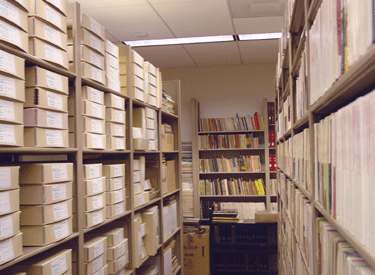
The diverse IPAM collections contain:
- An estimated 96% of all commercial piano recordings ever issued. Formats include 12,000 78 rpm shellac records; 26,000 vinyl long-play records; over 20,000 compact discs.
- Over 4,000 reel-to-reel and cassette tapes, many of which are unique recordings of live concerts and radio broadcasts.
- 2,500 books about the piano and pianists, with special strength in volumes about Franz Liszt and books in the Russian language.
- Over 25,000 scores, including diverse editions of standard repertoire as well as out-of-print editions of works by lesser-known composers.
- Major archival collections of individual pianists and scholars (see listing below), including programs, letters, photographs, recordings in all formats, manuscripts, diaries, scrapbooks, etc. Details about Finding Aids and inventories of individual collections are available on request.
- The Harry L. Anderson Collection of piano recordings, discographical research, scrapbooks, clippings, periodicals, and other materials--assembled by the pioneer researcher in the field of pianism.
- A unique Artist File featuring the Henry Z. Steinway Collection of Steinway artists as well as files on the careers of hundreds of other pianists.
- The John C. Tibbetts Piano Archive, consisting of in-depth recorded interviews with more than 80 noted pianists. Spanning the years from 1981 to the present, they were conducted by Professor John Tibbetts of the University of Kansas.
- Programs and tapes from the William Kapell International Piano Festival and Competition.
- Several hundred concert programs documenting piano concerts in the United Kingdom between 1970 and 2020.
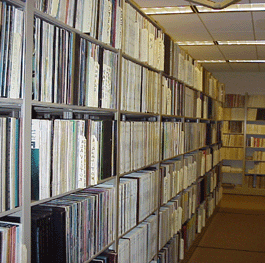
IPAM maintains files devoted to many thousands of concert pianists. Those listed below are represented by unique, extensive individual collections donated by the pianists themselves or by their families, descendants and/or pupils. Finding Aids for most of these collections are available on request.
The International Piano Archives at Maryland seeks to strengthen its already extraordinary collections and to enhance the services which are so important to scholars and friends. We are committed to:
- Acquiring historic and current piano recordings, collections of pianists' papers, and other related materials.
- Ensuring the protection of these rare and unique resources, actively working in the vanguard of research in special methods of preservation.
- Making these materials accessible and providing a variety of reference services and professional assistance.
Pianist Collections
Daniel Abrams Collection
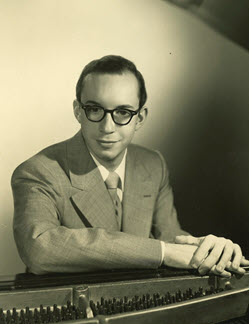 A native of Cleveland, OH, pianist and composer Daniel Abrams began his formal training in 1939 at the Cleveland Institute of Music. He later studied at the Juilliard School of Music, the Mannes College of Music, and a Fulbright Grant brought him to London to study piano and composition at the Royal Academy of Music. His instructors have included Nadia Boulanger, Darius Milhaud, Lennox Berkeley, Howard Ferguson and Felix Salzer in composition, and Isabelle Vengerova, Louis Persinger and Harold Craxton in piano. While in London, Abrams recorded 12 Beethoven Sonatas for Whitehall Records and subsequently embarked upon a successful tour of Europe. He returned to the United States to make his Town Hall debut in 1957. This was followed by further solo recitals in New York City at Carnegie Hall, the Metropolitan Museum, Alice Tully Hall and the 92nd Street “Y” and further tours of the United States, Canada, Europe and South America. Abrams has performed the complete Mozart Piano Sonatas in New York City, Baltimore and Woodstock, and the five Beethoven Concertos with the Baltimore Symphony. Abrams is a prolific composer who has written in a range of genres, including choral, chamber, orchestral, along with musicals, opera and works for piano. Among his piano works are pieces based on operas by Mozart, Wagner, Weber, Gounod and Offenbach. Abrams has also published instructional series that include Practice Techniques for All Musicians, Put Your Hands on the Piano and Play!, and Understanding the Language of Music.
A native of Cleveland, OH, pianist and composer Daniel Abrams began his formal training in 1939 at the Cleveland Institute of Music. He later studied at the Juilliard School of Music, the Mannes College of Music, and a Fulbright Grant brought him to London to study piano and composition at the Royal Academy of Music. His instructors have included Nadia Boulanger, Darius Milhaud, Lennox Berkeley, Howard Ferguson and Felix Salzer in composition, and Isabelle Vengerova, Louis Persinger and Harold Craxton in piano. While in London, Abrams recorded 12 Beethoven Sonatas for Whitehall Records and subsequently embarked upon a successful tour of Europe. He returned to the United States to make his Town Hall debut in 1957. This was followed by further solo recitals in New York City at Carnegie Hall, the Metropolitan Museum, Alice Tully Hall and the 92nd Street “Y” and further tours of the United States, Canada, Europe and South America. Abrams has performed the complete Mozart Piano Sonatas in New York City, Baltimore and Woodstock, and the five Beethoven Concertos with the Baltimore Symphony. Abrams is a prolific composer who has written in a range of genres, including choral, chamber, orchestral, along with musicals, opera and works for piano. Among his piano works are pieces based on operas by Mozart, Wagner, Weber, Gounod and Offenbach. Abrams has also published instructional series that include Practice Techniques for All Musicians, Put Your Hands on the Piano and Play!, and Understanding the Language of Music.
SERIES DESCRIPTION
I – Performance Files
II – Correspondence
III – Recording Files
IV – Documents: Publications
V – Publicity
VI – Writings
VII – Photographs
VIII – Other Artists
IX – Miscellaneous
X – Recordings
XI - Compositions
Claudio Arrau Collection
Claudio Arrau, a Chilean pianist, is counted amongst the most renowned performers of the 20th century. Arrau was a child prodigy, playing Beethoven sonatas by the age of 4 and debuting publicly at the age of 5. At 8, Arrau was sent to study in Germany on a 10-year-long grant from the Chilean government. Martin Krause, a Liszt pupil and Arrau’s teacher at the Berlin Conservatory, was a beloved figure in young Arrau’s life, and provided the bulk of his formal piano instruction. Krause died when Arrau was only 15, and Arrau never took on another teacher.
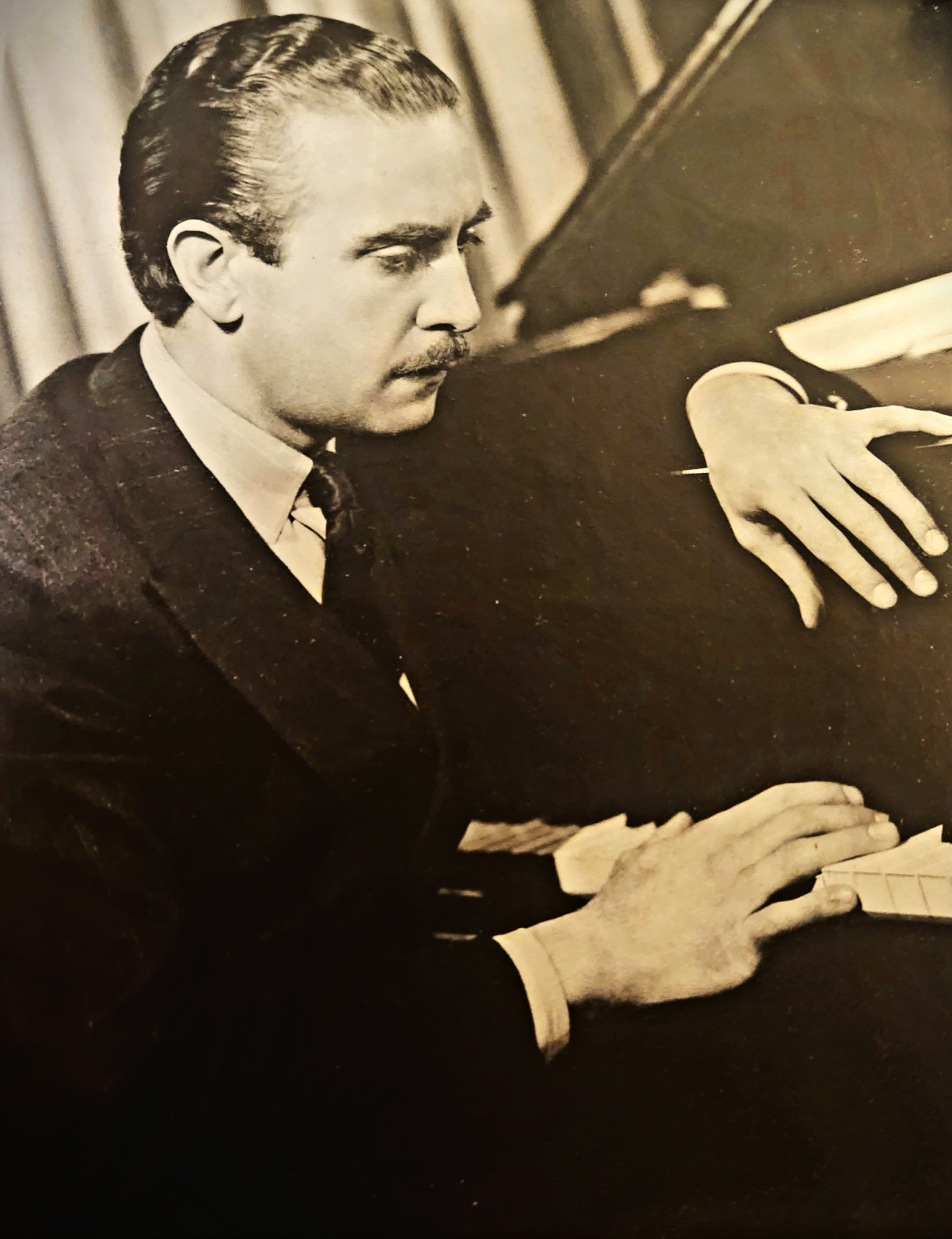
Arrau was known for performing complete cycles of composers’ work, including that of Bach, Beethoven, Mozart, Schubert, and Weber. He also recorded much of the work of Schumann, Chopin, Debussy, and Liszt. Despite his vast repertoire, Arrau remains most closely associated with Beethoven. He was an acclaimed interpreter of Beethoven’s works, and completed a performer’s edition urtext of the 32 Beethoven Sonatas for the Peters publishing house. He was also a dedicated teacher, instructing students from across the world.
Arrau has been praised for his highly intellectual, thoughtful playing; he was considered a pianist of intense depth and strength. Outside of music, he was an avid reader, with a wide range of interests such as pre-Columbian and Etruscan art, opera, philosophy, and literature.
Arrau was married to mezzo-soprano Ruth Schneider, with whom he shared three children. Arrau died at age 88, in Austria.
SERIES DESCRIPTION
Series I- Photographs
Series II- Selected Programs
Series III- Selected Performance Files
Victor Babin Collection
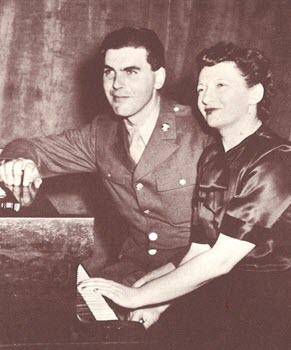 Victor Babin was born in Russia and met his wife/performing partner, Vitya Vronsky, while studying with Artur Schnabel in Berlin. Vronsky also studied with Alfred Cortot and with Egon Petri. Babin and Vronsky, once described by Newsweek as "the most brilliant two-piano team of our generation," embarked upon a career as a duo that took them all over the world. Their recordings were issued by RCA Victor, Columbia, Decca and EMI. Despite a break from performance during World War II (during which Babin served in the Armed Forces and Vronsky worked with war casualties in Washington D.C. hospitals), the duo still managed to perform well over 1200 concerts in North America alone. In 1961, Babin became Director of the Cleveland Institute of Music, where both he and Vronsky served on the Institute's faculty. Babin died in 1972 and Vronsky died in 1992.
Victor Babin was born in Russia and met his wife/performing partner, Vitya Vronsky, while studying with Artur Schnabel in Berlin. Vronsky also studied with Alfred Cortot and with Egon Petri. Babin and Vronsky, once described by Newsweek as "the most brilliant two-piano team of our generation," embarked upon a career as a duo that took them all over the world. Their recordings were issued by RCA Victor, Columbia, Decca and EMI. Despite a break from performance during World War II (during which Babin served in the Armed Forces and Vronsky worked with war casualties in Washington D.C. hospitals), the duo still managed to perform well over 1200 concerts in North America alone. In 1961, Babin became Director of the Cleveland Institute of Music, where both he and Vronsky served on the Institute's faculty. Babin died in 1972 and Vronsky died in 1992.
Katherine Bacon Collection
Katherine Bacon was born in Chesterfield, England on June 2, 1896. Soon after taking a few piano lessons with a family friend at the age of four, she was encouraged to begin regular lessons with a local piano teacher. At age nine she began serious study in piano and harmony with a local professor. 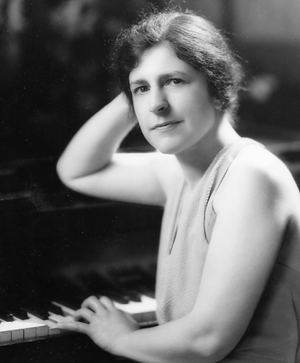
When Bacon was eleven, she was taken to a concert of the young English pianist, Arthur Newstead. After the concert she played for him on the concert hall stage, and he praised her talent and musical promise. Shortly thereafter, she began studying with Mr. Newstead, traveling 600 miles a week to London for two weekly lessons.
In 1913, Newstead was appointed to the Faculty at the Peabody Conservatory of Music in Baltimore, and his young prodigy was not long in following. While at Peabody, Bacon attracted considerable attention by playing a series of five different recital programs in the span of one month. On May 29, 1916, three days following graduation and the completion of her degree at Peabody, Bacon and Newstead were married in Annapolis, Maryland.
The following year, Bacon had a daughter Joan and shortly thereafter Newstead accepted a teaching position at the Institute of Musical Art (now the Juilliard School) in New York City. For a period of one or two years he commuted back and forth from Baltimore to New York, but eventually the family settled in New York.
After her New York debut on November 19, 1920, Bacon was regarded as one of the outstanding young pianists of her day. In addition to numerous solo recitals, she appeared with the New York Philharmonic, Toronto Symphony, and Baltimore Symphony, to name a few, as well as with fine chamber music players.
Outstanding achievements in her career include a 1927 performance of the 32 Beethoven piano sonatas in a series of seven weekly recitals at Aeolian Hall in New York in commemoration of the Beethoven Centenary. The following year, marking the centenary Franz Schubert, she gave a series of four concerts in which she performed all his important piano works. In 1939-40, Bacon repeated the Beethoven cycle at Town Hall in New York as well as at the Juilliard Summer School.
In 1955 Bacon temporarily directed the Piano Department of the Chautauqua School of Music in Chautauqua, New York. In addition to a full teaching schedule, her responsibilities included two weekly master classes, 13 different recital programs, and an appearance with the Chautauqua Symphony Orchestra.
From 1930 to 1968 Bacon lectured and performed at universities and colleges throughout the United States as part of the Association of American Colleges Arts Program. In the fall of 1966, a far Eastern tour took her to Japan, Korea, and Hong Kong for concerts, radio and television broadcasts, and lecture recitals.
Bacon taught piano at the Mannes College of Music in New York from 1921 to 1929 and served on the faculty of the Juilliard School from 1940 until her retirement in 1972. In addition, she participated in the Juilliard Summer School program for its 21 years of operation from 1932 to 1952.
On January 30, 1982, Bacon died in a New York nursing home at the age of 85.
Erno Balogh Collection
Erno Balogh, pianist, composer, editor and teacher, was born on April 4, 1897 in Budapest, Hungary. From an early age, he performed and composed music at the piano. Punishment for him was being denied access to the piano. His first compositions, two short piano pieces dedicated to his father, were written at the age of eight. For twelve years, 1905 to 1917, he attended the Budapest Conservatory, completing the Professor's Certificate and receiving the Franz Liszt Prize in piano and composition. During this period, he studied piano with Bela Bartok and composition with Zoltan Kodaly. Balogh became a close friend of both men and he was instrumental in bringing Bartok to the U.S. for his first concert tour in 1927. 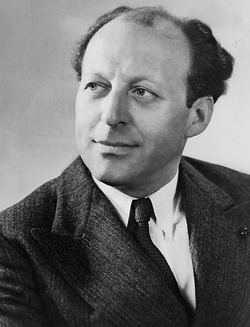
Balogh left Hungary in 1919 and arrived in Berlin. He studied piano at the Berlin Conservatory from 1920 to 1923 with Leonid Kreutzer. In 1923, Balogh was considering coming to the United States when he met violinist Fritz Kreisler, who asked him to be his accompanist on a tour of Scandinavia. Kreisler advised him that a move to the United States would be enhanced by this experience because, as Balogh explained, "he was rather well known there, and that having my name listed on his programs would not hurt me with American managers."
Balogh settled in the United States in 1924. He lived in New York City until 1960 and, during that time, was an established figure among concert pianists, appearing in recital and with orchestra throughout the United States and in Canada and Cuba, accompanying the great singers, Lotte Lehmann and Grace Moore and making several recordings. In 1936, he married Malvina Schweitzer, a New York University professor of biochemistry.
In 1960, Balogh and his wife moved to Washington, D.C. and he taught at the Peabody Conservatory in Baltimore where he influenced many piano and composition students. He wrote articles on piano pedagogy, opera, performance practice, and Bartok for such magazines as Etude, Opera News, and The Musical Observer. Balogh died on June 2, 1989 at the age of 92.
SERIES DESCRIPTION
Series I - Music Manuscripts
Music manuscripts composed by Erno Balogh from 1905 through 1973. This series has been subdivided into eight subseries:
Subseries 100: Piano Solo
Subseries 200: One or Two Pianos, Four Hands
Subseries 300: Voice
Subseries 400: Chamber Music
Subseries 500: Orchestra
Subseries 600: Sketches and Transcriptions Pre-1914
Subseries 700: Sketches Post-1914
Subseries 800: Works by d'Elvesta (Balogh)
The manuscripts are arranged alphabetically within each subseries and the series is located in boxes 1 through 7 (3 linear feet).
Series II - Printed Scores
Printed scores composed by Erno Balogh from 1921 through 1966. Most have been published. This series has been subdivided into eight subseries:
Subseries 100: Piano Solo
Subseries 200: Two Pianos, Four Hands
Subseries 300: Voice and Piano
Subseries 400: Chamber Music
Subseries 500: Orchestra
Subseries 600: Works Arranged by Balogh
Subseries 700: Works Compiled and Edited by Balogh
Subseries 800: Works by d'Elvesta (Balogh)
The scores are arranged alphabetically within each subseries and the series is located in boxes 8 and 9 (1 linear foot).
Series III - Photographs
Photographs and negatives that have been subdivided into the following subseries:
Subseries 100: Balogh
Subseries 200: Bartok
Subseries 300: Bartok Memorials
Subseries 400: Colleagues and Friends
Subseries 500: Students
Subseries 600: Miscellaneous
Subseries 700: Balogh's childhood photos
Subseries 800: Balogh's family photos
No number - 3 framed photos
Series IV - Contracts
Contracts and correspondence relating to such between Balogh and various music publishers and/or colleagues regarding music manuscripts published between 1924 and 1970. The series is arranged chronologically by title of composition published, with all related renewal contracts and correspondence attached. The series is located in box 11 (.5 linear foot).
Series V - Correspondence
Correspondence, primarily from Bartok and other musicians and to his wife, Malvina, covering the period 1934 through 1991. The series is located in box 12.
Series VI - Bartok Material
The series consists of articles, brochures, festivals, concerts, correspondence, and auction papers related to Bartok.
Series VII - Performance Files
Programs, reviews, promotional materials and similar documents related to specific performances of Balogh. The materials are organized chronologically by performance date and cover the years 1914 through 1975. This series is located in boxes 13 through 17 (2 linear feet).
Series VIII - Literary Manuscripts
The series consists of published, unpublished writings, and scripts for the plays. The materials are organized chronologically by date of composition and cover the years 1930 through 1970. This series is located in box 18 (.5 linear foot).
Series IX - Subject Files
Various documents that have been divided into subseries including awards, diaries, materials relating to ASCAP, address books, legal documents, Balogh's obituary, auction papers, biographical articles, his books, compositions, publicity material, recording advertisements and reviews, sketchbooks, certificates, interview/radio scripts, and others. It is arranged chronologically within each subseries and covers the years 1924 through 1973. This series is located in boxes 19 through 22 (2 linear feet).
Series X - Sound Recordings
Recordings by Balogh and recordings owned by Balogh of both his music and other compositions from 1941 through 1975. The series is subdivided into the following series:
Subseries 100: Tapes
Subseries 200: Acetate Discs
Subseries 300: Commercial and non-commercial 78s
Subseries 400: Commercial LPs
Subseries 500: Commercial recordings (78s and LPs) unrelated to EB
The subseries are arranged chronologically by date of issue. This series is located in IPAM on shelves (8 linear feet).
Series XI - Miscellaneous
A work by Mary McInnis, describing views of Balogh regarding piano technique and pedagogy.
David Barnett Collection
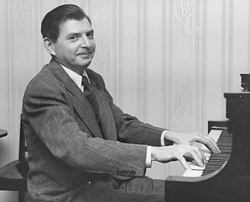 David Barnett was born in New York City on December 1, 1907. He graduated with an academic degree from Columbia University and went on to study music at the Curtis Institute in Philadelphia and Juilliard Graduate School in New York City. Barnett studied piano with Alfred Cortot in Paris, where he also received his teaching diploma. At this time, he made his debut as a pianist as well as a published composer. Upon returning to the U.S., Barnett began to teach piano and music theory, as well as continuing his touring and composing careers. Barnett taught at Harvard, Columbia, Wellesley and the New England Conservatory of Music, as well as a stint as Headmaster of the Thomas School in Rowayton, CT. Barnett is also a published author, including the books "Living With Music" and "They Shall Have Music." Barnett died in 1985.
David Barnett was born in New York City on December 1, 1907. He graduated with an academic degree from Columbia University and went on to study music at the Curtis Institute in Philadelphia and Juilliard Graduate School in New York City. Barnett studied piano with Alfred Cortot in Paris, where he also received his teaching diploma. At this time, he made his debut as a pianist as well as a published composer. Upon returning to the U.S., Barnett began to teach piano and music theory, as well as continuing his touring and composing careers. Barnett taught at Harvard, Columbia, Wellesley and the New England Conservatory of Music, as well as a stint as Headmaster of the Thomas School in Rowayton, CT. Barnett is also a published author, including the books "Living With Music" and "They Shall Have Music." Barnett died in 1985.
IPAM holds multiple copies of most of Barnett's published compositions. These are available free of charge. Inquire of the IPAM curator for further information.
SERIES DESCRIPTION
Series I - Correspondence
Series II - Reviews
Series III - Miscellaneous Files
Series IV - Cassette Tapes
Series V - Reel Tapes
Series VI - Video Tapes
Series VII - Music Manuscripts
Series VIII - Scores
Scott Beard Collection
Dr. Robert Scott Beard was a nationally recognized pianist, author, and educator. He served as Provost, Professor of Piano, Dean of Graduate Studies, Coordinator of Keyboard Studies, and Associate Provost during his time at Shepherd University, as well as Artistic Director of the Washington Opera Society in Washington DC. Beard showed musical promise early on in his life, beginning his studies with Judith Ross and Judith Siegel in Virginia before attending the Peabody Institute to obtain his Bachelor of Music degree. Beard went on to earn Master’s and Doctoral degrees in Piano Performance from the University of Maryland, during which he studied with Lillian Freundlich, Tinka Knopf, Robert Weirich, and Ann Koscielny.
Beard was one of the leading authorities in the world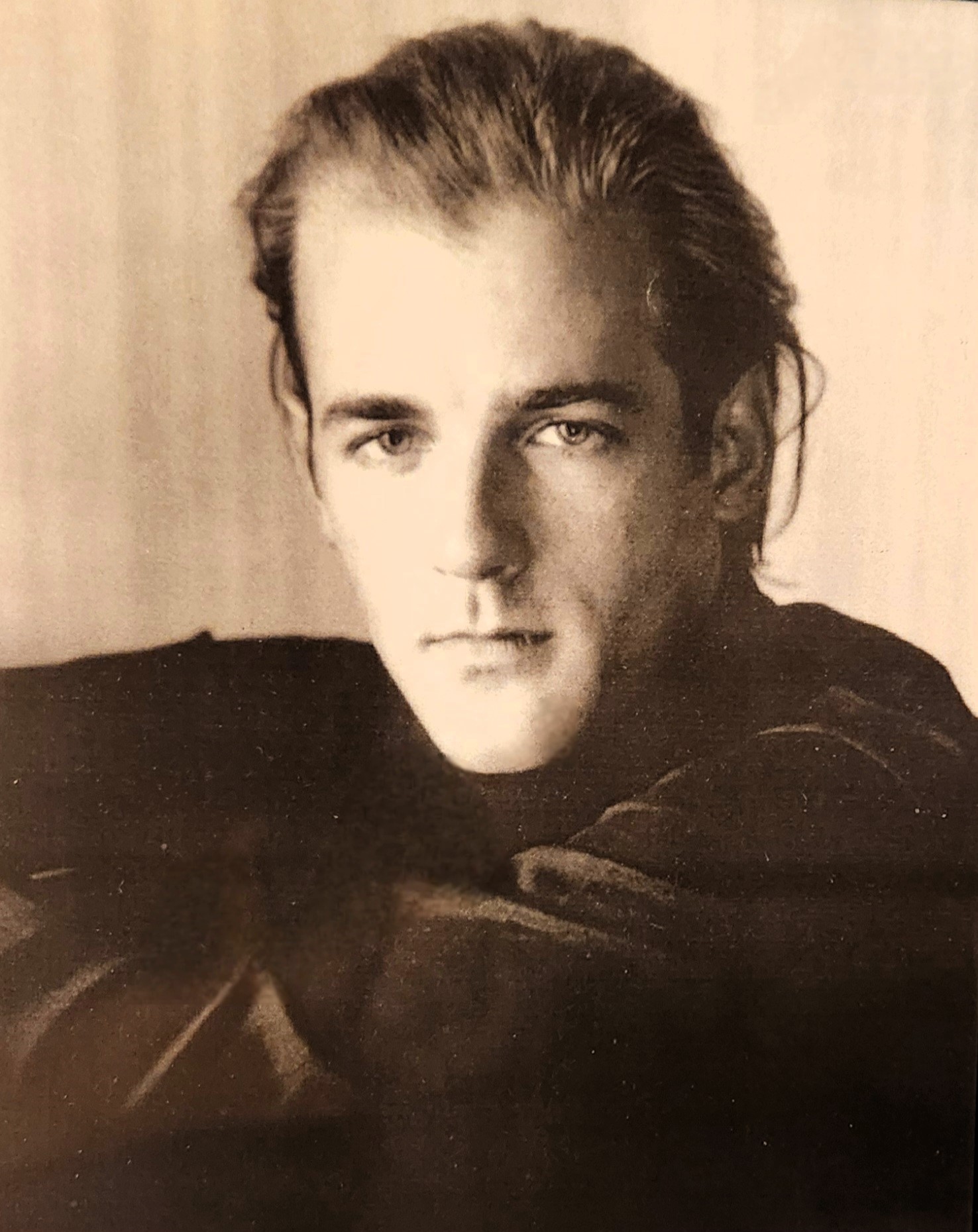 on the topic of 19th Century pianist and pedagogue Theodor Leschetizky, completing his doctoral dissertation and accompanying recording, “Leschetizky: Piano Treasures,” on the subject. Beard was a fervent believer in Leschetizky’s pedagogical methods and in his music.
on the topic of 19th Century pianist and pedagogue Theodor Leschetizky, completing his doctoral dissertation and accompanying recording, “Leschetizky: Piano Treasures,” on the subject. Beard was a fervent believer in Leschetizky’s pedagogical methods and in his music.
As an educator, Beard was well-loved by his students. He was named the 2006 West Virginia Music Teacher of the Year, and was a finalist for Professor of the Year in 2010. Beard also served as the organist and music director for Our Savior Lutheran Church in Laurel, Maryland. As a pianist, Beard performed as a soloist and chamber musician throughout the United States, South America, and Europe. Beard took part in the French Piano Institute at Schola Cantorum in Paris, France for several years, and won the Roussel Foundation Prize for best performance of a work by Roussel. Beard also won prizes for the best overall performance of a work by a French composer, as well as the jury prize for Baroque music. Beard was often praised for his expressive playing and inventive programming.
In addition to his accomplishments as a pianist, educator, and higher education administrator, Beard was also an author and editor. He collaborated on several editions of piano ensemble repertoire with Alfred Publishing Company, and on a college-level piano textbook with Dr. Lucy Mauro, published by Oxford University Press.
The Scott Beard Collection at IPAM houses papers, scores, recordings, and photographs relating to the life and career of Scott Beard, as well as materials compiled by Beard with a focus on Theodor Leschetizky.
SERIES DESCRIPTION
Series I- Performance and Pedagogical Files
Series II- Subject Files
Series III- Theodor Leschetizky Files
Ralph Berkowitz Collection
Ralph Berkowitz was born in New York City in 1910. In 1928, he enrolled at the Curtis Institute in Philadelphia. He later became a member of the Institute's staff, teaching form and analysis, directing the Historical Series (concerts), and coaching vocal students. He remained in that position until 1940 when he became the accompanist for cellist Gregor Piatigorsky. He continued in that role for 30 years, appearing with Piatigorsky in recitals throughout the world until the cellist's death in 1972. 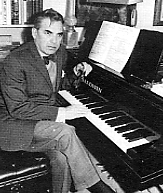
Berkowitz was executive assistant to Serge Koussevitzky at Tanglewood from 1946 to 1951. He became Dean of the Berkshire Music Center at Tanglewood in 1951 and remained in that position until his resignation in 1964.
In 1953, he took on the dual role of executive director and principal pianist of the June Music Festival in Albuquerque. After commuting from the East coast, for five summers, he moved to Albuquerque in 1958 and became business manager of the Albuquerque Symphony Orchestra. He resigned that post in 1969.
In addition to teaching, lecturing, and performing, Ralph Berkowitz is also a painter. His paintings, pastels, woodcuts, and drawings are in numerous private collections in New York, Philadelphia, Boston, Los Angeles and Albuquerque.
In Albuquerque, Berkowitz did a lecture series on television called The Arts consisting of 63 half-hour shows dealing with some aspect, of music, painting, or literature. He has also had articles published by Penguin Books (London), Etude Magazine, and The Juilliard Review.
As a composer, Ralph Berkowitz wrote "A Telephone Call," for singer and orchestra, based on a Dorothy Parker monologue.
In March of 1992, Ralph Berkowitz donated his personal papers, comprising photographs, correspondence, programs, and newspaper articles and clippings, to the International Piano Archives at the University of Maryland.
Mary Louise Boehm Collection
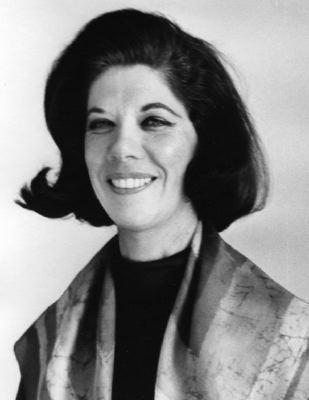 Mary Louise Boehm was born in Iowa on July 25, 1924 and enjoyed early recognition as a child prodigy. Her training included lessons with Louis Crowder at Iowa State Teachers College. Following studies at Northwestern University and the University of Nebraska, she took lessons with Robert Casadesus and Walter Gieseking.
Mary Louise Boehm was born in Iowa on July 25, 1924 and enjoyed early recognition as a child prodigy. Her training included lessons with Louis Crowder at Iowa State Teachers College. Following studies at Northwestern University and the University of Nebraska, she took lessons with Robert Casadesus and Walter Gieseking.
Boehm was noted for her pioneering recordings and performances of works by American composers such as Amy Beach and Ernest Schelling. She has also performed works by lesser-known early Romantic composers such as John Field, Johann Nepomuk Hummel, Johann Pixis, Ignaz Moscheles and Friedrich Kalkbrenner. In addition, Boehm has performed late Classical and early Romantic works on period instruments.
Boehm enjoyed a concert career of more than fifty years as a collaborative pianist with her violinist husband, Kees Kooper. They performed in the U.S., the Far East, extensively in South America, and in Kooper's native Holland. Mary Louise Boehm died in 2002.
SERIES DESCRIPTION
SERIES I - Performance Files
1944-1969 1970-1987 1988-2002 (Recordings)
Series II - Subject Files
Series III - Photographs
Series IV - Writings
Series V - Correspondence
Series VI - Scrapbook Materials
Series VII - Scores
Joseph Bloch Collection
Joseph Bloch was born in Indianapolis, Indiana, on November 6, 1917. He was best described by the New York Post as a musician who "has that rare trio: a head, a heart, and skill". Through high school, he studied with Bomar Cramer and then with Rudolph Ganz at the Chicago Musical College. After earning his Bachelor of Music degree, he enrolled at Harvard University for his Master's degree in Musicology. While in graduate school, Bloch commuted to New York in order to study with Olga Samaroff.
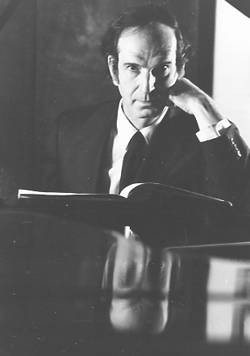 During World War II, Bloch was stationed at Lawry Field in Denver, Colorado, where he gave informal recitals and also appeared as a soloist with the Civic Symphony. He was in the Army Air Forces from 1941-1946 and discharged as captain.
During World War II, Bloch was stationed at Lawry Field in Denver, Colorado, where he gave informal recitals and also appeared as a soloist with the Civic Symphony. He was in the Army Air Forces from 1941-1946 and discharged as captain.
In 1946, he was appointed head of the piano department at the University of Denver and two years later, joined the faculty at Juilliard. He taught piano literature classes there and had a significant influence on accomplished pianists such as Garrick Ohlsson, Van Cliburn, Misha Dichter and John Browning.
In 1950, Bloch made his debut at Town Hall in New York City and since then, he has performed with numerous orchestras in the United States, Europe, and East Asia. He has travelled throughout the world, giving lecture-recitals and concerts in countries such as France, Japan, Belgium, Switzerland, and China. His recital programs included works by Scriabin, Honegger, Alkan, and by his life-long friend, Benjamin Lees. He has made recordings for Composers Recordings, Inc. of piano music by Robert Moevs, Jacques de Menasce, and Ruth Crawford Seeger. He has also written a monograph on Charles-Valentin Alkan.
Joseph Bloch died at his home in Larchmont, NY on March 4, 2009.
Jorge Bolet Collection
Jorge Bolet was born in Havana, Cuba on November 15, 1914, and began serious study of the piano at age five under the direction of his sister Maria. He played his first public recital at age nine and appeared as soloist with the Havana Sinfonica at age ten. In 1927, he was awarded a scholorship to The Curtis Institute of Music in Philadelphia, where he studied with David Saperton. During this period he also played often for, and received coaching from, Josef Hofmann and Leopold Godowsky. At sixteen, he appeared as a soloist with the Curtis Symphony Orchestra under Fritz Reiner in Carnegie Hall.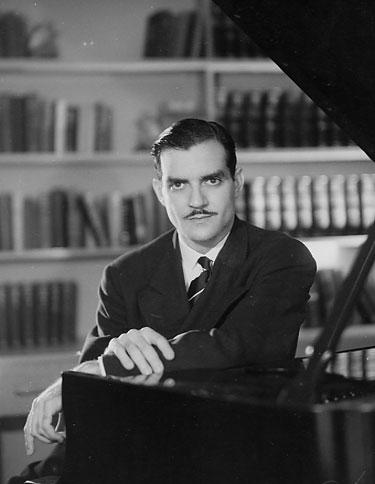
Upon his graduation in 1934, the Cuban government sent Bolet to Europe for further training under Moriz Rosenthal. While there, he began his concert career, appearing in Vienna, Berlin, Paris, London, The Hague, Amsterdam, Milan, and Madrid and other Spanish cities. Bolet's North American debut was in 1937, a performance with the Philadelphia Orchestra under Eugene Ormandy. This was followed by his New York recital debut at Town Hall in 1937 as winner of the Naumburg Award. He returned to Town Hall in 1940 as the first and only winner of the Josef Hofmann Award given by the Curtis Institute.
At the outbreak of World War II, Bolet joined the Cuban army and as a lieutenant served at the Cuban Embassy in Washington under regime of President Batista. After the Batista government fell, Bolet joined the United States Army and became an American citizen. While stationed in Tokyo with the Army of Occupation, Bolet conducted the Japanese premiere of "The Mikado" by Gilbert and Sullivan, and made several appearances as soloist with the Nippon Philharmonic Orchestra.
Following his separation from the service, Bolet resumed his interrupted career. As both recitalist and soloist with orchestra, Bolet toured extensively throughout the world. He performed with most of the major orchestras including Amsterdam, Berlin, Boston, Chicago, Cleveland, Copenhagen, Detroit, Los Angeles, Madrid, Minnesota, Oslo, Pittsburgh, and New York. He was known to an even wider audience through radio and television appearances on such programs as the Bell Telephone Hour. A leading interpreter of the music of Franz Liszt, Bolet recorded the soundtrack for "Song Without End," a 1961 film on the life of Liszt.
Bolet's first recordings appeared in the early 1950s on the Boston and Remington labels, and include a much-acclaimed performance of Prokofiev's Concerto No.2. Subsequently his playing was featured on releases from RCA Victor, Everest, Ensayo, Genesis, Opus, Columbia/CBS, Vox and most notably Decca/London, for whom he recorded an extensive cross-section of his repertoire during the last decade of his career.
Bolet taught for many years at The Curtis Institute in Philadelphia and at Indiana University in Bloomington, as well as conducting numerous master classes around the world. He died in San Mateo, California on October 16, 1990.
Alexander Borovsky Collection
Alexander Borovsky (1889-1968) was a Russian pianist, pedagogue, and prolific performer, giving over 2,500 concerts worldwide across 47 years. Borovsky was a child prodigy, studying with his mother Vera Vengerova—herself an accomplished pianist and student of Vasili Safonov—before enrolling in the St. Petersburg Conservatory in 1907, where he studied with Anna Essipova. Borovsky won Honorable Mention in the 1910 Anton Rubinstein Competition, and graduated from the St. Petersburg Conservatory in 1912 with a gold medal and the sought-after Rubinstein prize. Borovsky then taught at the Moscow Conservatory from 1915-1920, before launching a performance career and concertizing across Europe. He made his American debut at Carnegie Hall in 1923, and routinely performed in North and South America, Europe, and Asia throughout his lengthy public career.
Borovsky is renowned as a Bach interpreter, though he performed a wide and varied repertoire. Borovsky was amongst the first pianists to record the entirety of Liszt’s Hungarian Rhapsodies and Bach’s Inventions; he also performed the complete Well-Tempered Clavier in television broadcasts (1958-59). Reviews hail Borovsky for his technical command, good taste, and interpretive refinement. Borovsky also wrote extensively on Bach, in addition to a smaller number of pieces on Chopin, Debussy, and others.
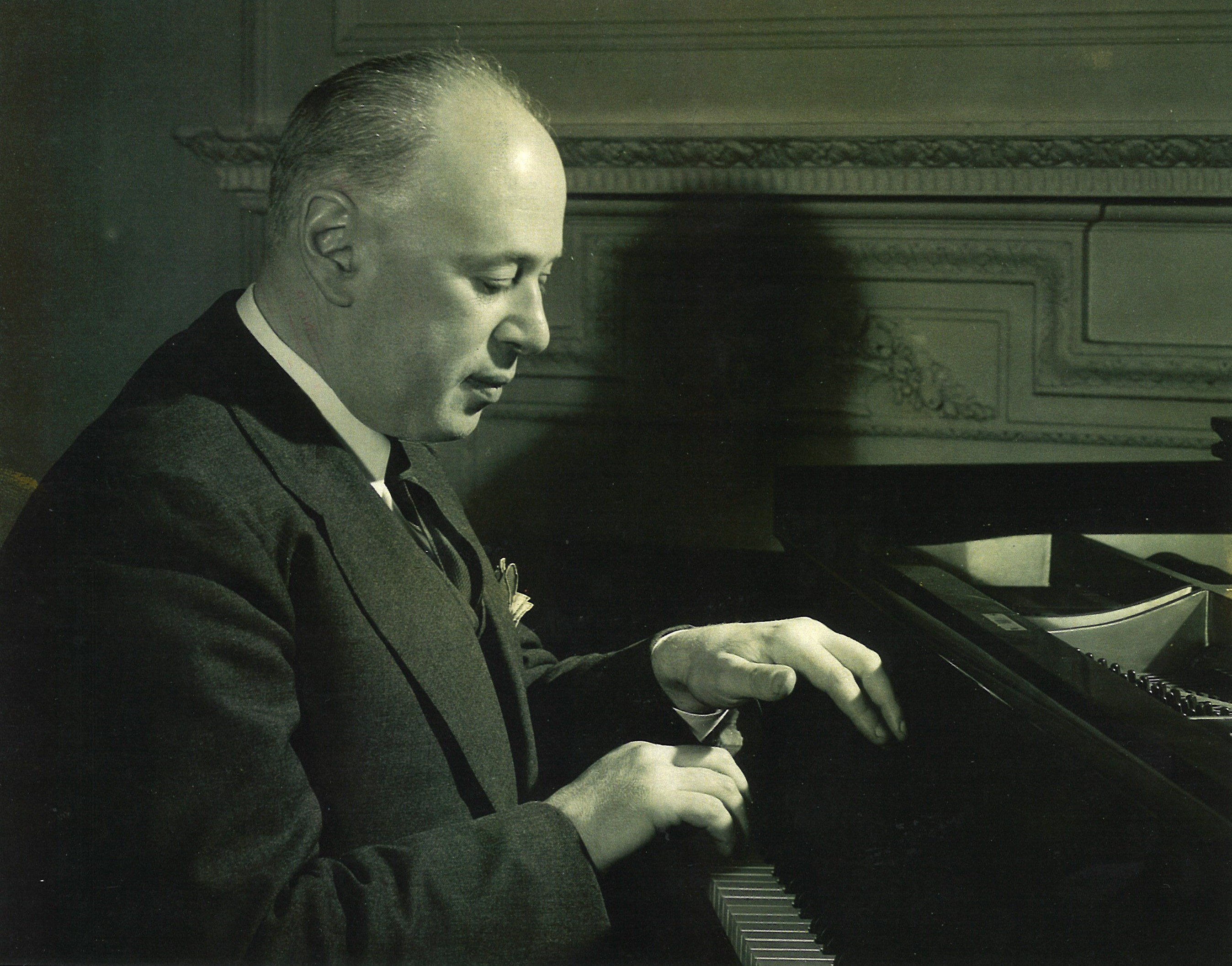
Borovsky collaborated with important conductors such as Serge Koussevitzky, Charles Munch, Leopold Stokowski, Wilhelm Furtwangler, Bruno Walter, and many others. He was a friend of Koussevitzky, performing with him a multitude of times, and premiering Roussel’s Concerto pour piano et orchestre under his baton in Paris in 1928. Borovsky was also a close personal friend and one-time roommate of Sergei Prokofiev, and was well-connected across much of the classical music scene throughout the 20th century.
Borovsky was also a dedicated pedagogue with a large number of students, including Winifred Atwell and Eugen Indjic. Borovsky was appointed to the piano faculty of Boston University in 1956, where he taught a thriving studio. Borovsky lived in Waban, Massachusetts, his home since 1941, until his death in 1968.
William Jones, a student and friend of Alexander Borovsky, compiled and donated the materials found within the Alexander Borovsky Collection.
SERIES DESCRIPTION
William Jones’ Research Materials
Includes resources from William Jones’ research on Alexander Borovsky, such as information on Borovsky’s genealogy, biography, performances, and recordings.
Concert Materials: Newspaper Clippings, Articles, and Reviews
Includes reviews, articles, and newspaper clippings predominately surrounding Alexander Borovsky’s concert appearances and performances; also includes information on Borovsky’s students, friends, and colleagues.
Concert Materials: Programs and Concert Listings
Includes programs, concert announcements, and concert advertisements, predominately surrounding Alexander Borovsky’s concert appearances from 1890-1962; also includes information on Borovsky’s students, friends, and colleagues.
Photographs, Memorabilia, and Other Writings
Includes Borovsky’s personal items, such as grade school report cards, passports, diplomas, etc. Also includes writings outside of the scope of reception history, such as lectures and articles written by Borovsky himself. Two scrapbooks of reviews and photographs are also included. Notable individuals depicted include Rachmaninoff, Scriabin, Glazunov, Wanda Landowska, Claudio Arrau, and more.
Correspondence to/from William Jones
Includes letters and emails to and from William Jones, mostly regarding his research on Alexander Borovsky. Amongst those corresponding with him, Lina Prokofiev, Mrs. Koussevitzky, Nicolas Slonimsky, Stephen Walsh, Paul Badura-Skoda are of wide interest. Other names that appear frequently include Henri Nijsten, Olga de Kort, Natasha Borovsky, Natalie King (Borovsky’s step-daughter, and Gregor Benko. The emails are helpful for understanding Mr. Jones’ research process, and they provide significant background information on Borovsky, his relationships, his performances, and his life.
Correspondence to/from Alexander Borovsky
Includes letters, post-cards, and mail to and from Alexander Borovsky, as well as a folder dedicated to miscellaneous correspondence. The Borovsky letters span many different languages, and include key figures like Abram Chasins, James Whaler, Serge Koussevitzky, Guillermo Espinosa, and Arthur Fiedler, amongst others.
Records and 78s
Includes many of Borovsky’s recordings, such as Liszt’s Hungarian Rhapsodies and Transcendental Etudes, as well as many Bach works.
Scores
Includes scores from Alexander Borovsky’s personal collection. Many of these scores have Borovsky’s markings on them, or inscriptions to Borovsky written by composers and friends.
Mario Braggiotti Collection
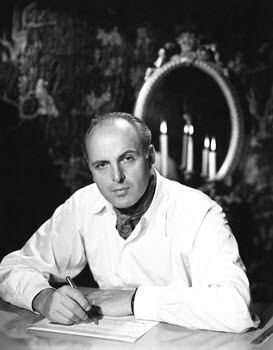 Mario Braggiotti, a pianist, composer, lecturer and linguist, was born in Florence, Italy. Braggiotti studied at the New England Conservatory of Music, as well as the Paris Conservatoire de Musique, where he studied under Nadia Boulanger and Isidor Philipp. With a fellow student, Jacques Fray, Braggiotti formed a piano duo that went on to create a catalog of more than two hundred original transcriptions. The duo were the first to play both classical and popular music on the same program and were known internationally. Braggiotti also founded the Braggiotti Music School in Italy. He died in 1996.
Mario Braggiotti, a pianist, composer, lecturer and linguist, was born in Florence, Italy. Braggiotti studied at the New England Conservatory of Music, as well as the Paris Conservatoire de Musique, where he studied under Nadia Boulanger and Isidor Philipp. With a fellow student, Jacques Fray, Braggiotti formed a piano duo that went on to create a catalog of more than two hundred original transcriptions. The duo were the first to play both classical and popular music on the same program and were known internationally. Braggiotti also founded the Braggiotti Music School in Italy. He died in 1996.
Richard Buhlig Collection
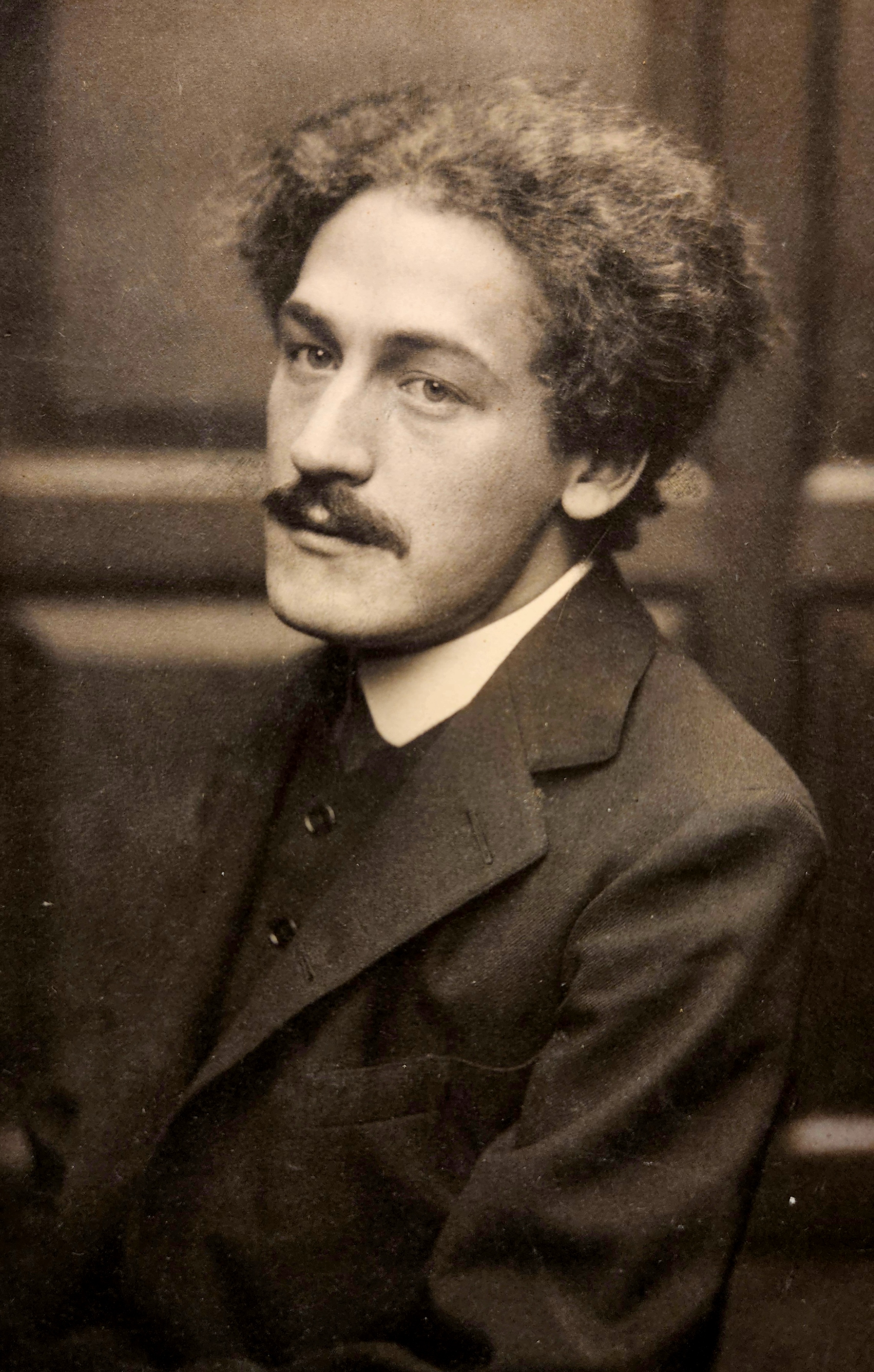
Richard Buhlig, an American pianist, was born in Chicago to German immigrants Moritz and Louise Buhlig. His early pianistic training was with August Hyllested, Margaret Cameron, Wilhelm Middelshulte, and Theodor Leschetizky. Buhlig maintained an active teaching and performing career, playing in recitals, concerts, and chamber performances across Europe and the United States. Buhlig was an intellectual pianist, hailed for his thoughtful interpretation and his programming of lesser-known piano repertoire—stylistically, he played a very large range of music, from Bach and Beethoven to Reger, Schoenberg, Debussy, and Bartók. He premiered Schoenberg’s op. 11 in England, to mixed reviews. Buhlig became a firm advocate for the contemporary music scene in the United States, working with renowned composers like Aaron Copland. He taught Henry Cowell, Grete Sultan, and John Cage, and he is responsible for getting Cage into contact with Arnold Schoenberg.
In addition to his commitment to contemporary music, Buhlig maintained an interest in the historical development of music and gave a number of lecture-recitals on music throughout the centuries. He lived in California for the later years of his life, and did not perform as widely, preferring to perform for small groups of connoisseurs who appreciated his modern programs. Buhlig was also involved in social issues, giving anti-Nazi speeches in Hollywood during the build-up to World War II.
The Richard Buhlig Collection was given to IPAM as part of the Harry L. Anderson collection. Anderson organized and translated much of the materials. The collection contains papers, books, and photographs relating to the life and career of Richard Buhlig, with a particular strength in performance files, photographs, and correspondence.
SERIES DESCRIPTION
Series I- Selected Performance Files
Series II- Books
Series III- Performance Files
Series IV- Photographs
Series V- Correspondence
Series VI- Miscellaneous
Jane Carlson Collection
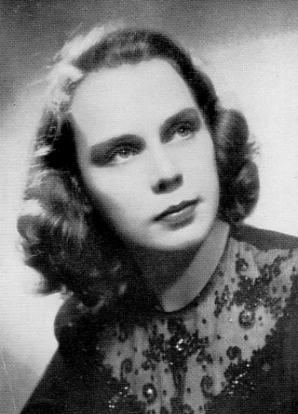 Jane Carlson was born in Hartford, Connecticut where she discovered a love for the piano at an early age. She took up formal piano lessons, which continued through her high school years and, upon graduation, was granted a regional scholarship to the Shenandoah Conservatory of Music in Virginia. Following her studies there, she moved on to the Juilliard School in New York. Carlson studied with both Carl Friedberg and Dame Myra Hess. She then joined the faculty of the Preparatory Division of the Juilliard School.
Jane Carlson was born in Hartford, Connecticut where she discovered a love for the piano at an early age. She took up formal piano lessons, which continued through her high school years and, upon graduation, was granted a regional scholarship to the Shenandoah Conservatory of Music in Virginia. Following her studies there, she moved on to the Juilliard School in New York. Carlson studied with both Carl Friedberg and Dame Myra Hess. She then joined the faculty of the Preparatory Division of the Juilliard School.
At various times, Carlson also taught at The University of California-Berkeley and at Dartmouth College. As a pianist, she toured throughout the world, from Iceland to Norway to Korea to England, performing both contemporary and standard works. She was particularly identified with the music of Paul Hindemith, performing his Ludus Tonalis on many occasions, and earning the esteem of the composer for her interpretation.
Robert and Gaby Casadesus Collection
Robert Casadesus was born in Paris, April 7, 1899. As the oldest in the second generation of a prestigious musical family, he inherited the tradition and the potential for an outstanding performance career. He did not follow the family tradition of playing stringed instruments but chose, instead, the piano. His Aunt Rose Casadesus, herself a pianist, instructed him until he entered the Paris Conservatory at the age of ten. At the Conservatory he studied solfege and piano with Louis Diémer, a pupil of Liszt, and with Antonin Emile Marmontel. He achieved the first prize in piano in 1913. From 1913 to 1917, he studied harmony with Xavier Leroux. During this period, he earned a livelihood by playing the celesta and extra percussion effects at the Opera Comique. In 1917, he made his debut as a concert pianist in Paris, with a recital at the Salle des Agriculteurs.
He was drafted into the army in 1918. After starting in the Artillery, he was transferred to the Engineers Corps band where he was a drummer. In 1919, he was awarded the first prize for harmony at the Paris Conservatory, having finished his study with Leroux. He received the Prix Diémer from the Conservatory the following year. 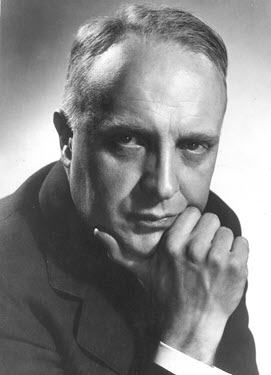
Two important events occurred for Casadesus in 1921: He married Gabrielle L'Hôte (Gaby Casadesus), and he became assistant to Isidor Philipp at the American Conservatory at Fontainebleau. The Fontainebleau School had been founded after World War I by Walter Damrosch and Francis Casadesus (Robert's uncle) as a summer school for American students in instrumental music and composition. At the end of the summer, he started his international career as a concert pianist by playing in major cities throughout Europe.
In 1922 Robert met Ravel and, as a result of this meeting, a strong working friendship developed between the two. Robert traveled and studied with Ravel and became a leading interpreter of his music.
In 1926 and 1927, he continued his tours to the capital cities of Europe, each year increasing the number of commitments for recitals and playing with the major orchestras. His first son, Jean, was born in 1927. The following year Robert was chosen to play the inaugural concert for the opening of the new Salle Pleyel. He also began playing recitals with Gaby, performing two-hand and four-hand pieces, some of which were his own transcriptions. In 1928, Robert made his first recording for Columbia in Paris, among which was Ravel's "Jeux d'eau." For the 1929 season, fifteen concerts in Moscow were added to his itinerary.
During the '30s, the scope of Casadesus's activities increased. The European concert tours were augmented in 1931 to include South America and, in 1933, Africa and the Middle East. In 1935, he made his first concert tour to the United States. While here, he was engaged by Arturo Toscanini to play the Brahms Second Piano Concerto with the New York Philharmonic the following season. In 1932 his second son, Guy, was born.
During 1930, Robert had made other recordings with Columbia, establishing a relationship that was to continue for the rest of his professional life. That same year his String Quartet, Op.13, was premiered in Paris. In 1934, in Warsaw, he and Gaby played the first performance of his Concerto for Two Pianos, Op.17. Durand, publisher of the music of Debussy and Ravel, issued Robert's Sonata for Flute and Piano, Op.18, in 1935. Also in 1935 he succeeded Isidor Philipp as head of the piano department of the American Conservatory at Fontainebleau. In 1939, Casadesus received the French Legion of Honor and the Belgian Order of Leopold.
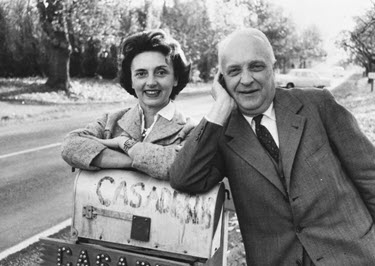 War breaks out! After the fall of France, he and Gaby established the Fontainebleau School at Newport, Rhode Island. In 1942 the Fontainebleau School was moved to Great Barrington, Massachusetts, in the Berkshires. The Casadesus' made their home with their sons in Princeton, New Jersey, which was convenient to Manhattan and Philadelphia and had an active European community. Here they lived during the was years, 1940 to 1946.
War breaks out! After the fall of France, he and Gaby established the Fontainebleau School at Newport, Rhode Island. In 1942 the Fontainebleau School was moved to Great Barrington, Massachusetts, in the Berkshires. The Casadesus' made their home with their sons in Princeton, New Jersey, which was convenient to Manhattan and Philadelphia and had an active European community. Here they lived during the was years, 1940 to 1946.
Throughout this period, Robert continued a varied and busy concert career, playing his first recital at New York's Carnegie Hall in 1941, and appearing with all the major American orchestras on a regular basis. In 1941, he began working with producer Goddard Lieberson at Columbia Records; they did many recordings over the years, including all of the piano music of Ravel and much of Debussy's. In 1942, Robert and Gaby's daughter Thérèse was born ("La naissance d'une dauphine!").
In the 1940's, his lifelong friendship and collaboration with Zino Francescatti, the great violinist, was begun. Robert continued to take time to compose, dedicating his Second Sonata for Piano and Violin, Op. 34, to Francescatti.
After the war, in 1946, Robert, now Director of the American Conservatory oversaw its return to Fontainebleau. He resumed his tours of the major European cities. From that time on, the Casadesus family established a pattern of spending summers in France and at least part of the winters in the U.S., making their home in Princeton. Casadesus's North American tour itinerary covered the U.S. and Canada from coast to coast with recitals in San Francisco, Vancouver, Houston, San Antonio, Cleveland, Minneapolis, Pittsburgh, Philadelphia, and New York, just to mention the larger cities.
Beginning in 1948, a number of his works were premiered by the New York Philharmonic. These included the Second Piano Concerto, Op.37, conducted by Leopold Stokowski (composer at the piano), the Suite for Orchestra, Op.47, conducted by Dimitri Mitropoulos, and the Three Dances, Op.54, commemorating the 25th anniversary of Casadesus's American debut. The Concerto for Three Pianos and String Orchestra, Op.65, was given its first performance by the Philharmonic under the baton of Lukas Foss. In 1969, he played his 100th concert with the New York Philharmonic.
Through these years, Robert received many honors from Europe and the United States. In 1949, he was asked by the Polish Government to give an all-Chopin recital in the Albert Hall, London, commemorating the centenary of the composer's death. In 1950, he was promoted to the rank of Officer in the French Legion of Honor in recognition of his outstanding musical career. Then in 1964 he became a Commander in the Legion of Honor. In 1968 he was awarded the Brahms medal in Hamburg as well as the gold medal of the city of Paris. He was asked to play the Beethoven Fourth Piano Concerto at the Bonn Festival during the Beethoven bicentenary in 1970.
During these busy years of concert tours and composing, Robert also continued to record extensively for Columbia. In 1946, be began making records with Francescatti: the ten sonatas for piano and violin of Beethoven, as well as works of Bach, Chausson, Debussy, Fauré, Franck, Mozart, and Casadesus's own Sonata No.2, Op.34. Casadesus was awarded the Grand Prix de l'Academie Charles Cros and the Grand Prix de l'Academie du Disque for the complete recording, on LP, of Ravel's piano music. With George Szell and the Cleveland Orchestra he recorded a number of Mozart piano concertos. In 1965 he was awarded the Netherlands' Edison award for his recordings.
In America, Casadesus was honored in the 1947 annual recorded music awards for his recording of the Debussy Preludes Book II (Columbia ML4019), and, in 1962, he and Gaby were nominated by the National Academy of Recording Arts and Sciences for best classical performance for "French Piano Music-Four Hands." (Columbia MS6323)
The Bell Telephone Hour produced a one hour television film, in 1967, on Robert, Gaby and Jean Casadesus, titled "The First Family of the Piano." Almost from the beginning of Casadesus's concert career, Gaby had joined him in many recitals for piano, four-hands, and two pianos. Beginning in 1950, Jean, their son, played many concerts with his parents. Both Gaby and Jean had successful careers of their own -- Jean until his death in a car accident in 1972. Gaby continued to teach master classes at Fontainebleau.
Robert Casadesus died in Paris, September 19, 1972, after a short illness. His Seventh Symphony, Op.68, with the chorus "Israel," was premiered at Alice Tully Hall at New York's Lincoln Center a few weeks later. Gaby Casadesus died in Paris on November 12, 1999.
Mes Noces Musicales, by Gaby Casadesus
"My Musical Notes" is an English translation (by Lawrence Lockwood in collaboration
with Therese Casadesus Rawson) of "Mes noces musicales," a memoir
by Gaby Casadesus. It is a September 2024 publication from Hamilton Books. Gaby
relates the history of her joint career with her husband as a piano duo, and her association
with many eminent French musical figures, among them Maurice Ravel. She also describes
how she balanced her career as pianist and teacher along with her husband's, all the while
raising three children.
Abram Chasins Collection
When the most versatile musicians in the history of American music are considered, Abram Chasins will surely find a prominent place on the roster. He has excelled as a composer, pianist, musicologist, author, teacher (in the both the studio and the classroom) and media administrator.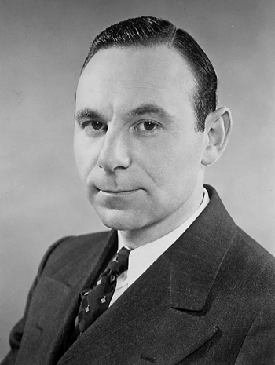
Abram Chasins was born in New York City on August 17, 1903, and studied at the Juilliard School, the Curtis Institute, and Columbia University. His major teachers included Ernest Hutcheson and Josef Hofmann. From 1926 to 1935, he taught at Curtis and, for a decade beginning in 1935, he was an outstanding pianist throughout the world, appearing in solo recitals and with leading orchestras everywhere. Besides his solo engagements and recordings, he also played and recorded duo-piano works with his wife, the pianist Constance Keene.
Chasins became famous for many other aspects of his musical career as well. More than one hundred of his compositions have been published, performed and recorded. As fortune would have it, he made his professional debut playing the solo part in his own Piano Concerto No. 1 in F Minor (1928) with the Philadelphia Orchestra under Ossip Gabrilowitsch at the Academy of Music in Philadelphia and, later, Carnegie Hall in New York. He also played his second Piano Concerto in F Sharp Minor, dating from 1931, with the Philadelphia Orchestra under Leopold Stokowski. He attained an international reputation in his early 20s as a protege of Josef Hofmann. Subsequently, he became the first American composer of the younger generation to be performed by Arturo Toscanini; the great maestro chose his "Parade" and "Flirtation in a Chinese Garden" for a concert with the New York Philharmonic. Chasins retired from the concert stage in 1946 to devote himself entirely to the musical directorship of radio station WQXR, the radio network of the New York Times with which he had been affiliated since 1943. His tenure established a nationwide standard for classical music programming which has never been surpassed.
"Speaking of Pianists" (Alfred Knopf, 1957; revised versions, 1961 and 1981) was Chasins' first published book; it has become an international source book. Other volumes from his hand, among them "The Van Cliburn Legend" (Doubleday, 1959), "The Appreciation of Music" (Crown, 1966), "Music at the Crossroads" (MacMillan, 1972) and "Leopold Stokowski, A Profile" (Hawthorne, 1979), also won wide attention.
As an adjudicator, Chasins served on jury panels for the Van Cliburn and National Federation of Music Clubs Competitions, the New York Philharmonic and the Metropolitan Opera auditions, the Chopin Prize and the Rachmaninoff and Leventritt Foundation awards.
Chasins was invited to become Musician-in-Residence at the University of Southern California, a post created specifically for him. In the course of his stay, he was honored by the City of Los Angeles for "distinguished service in transforming USC's campus 'rock station' into a strong cultural force and a nationally prominent broacasting entity" Previously, as a juror for the Cliburn Competition, he had been named an "Honorary Citizen of the State of Texas."
Chasins became especially well-known for his "Three Chinese Pieces" (A Shanghai Tragedy, Flirtation in a Chinese Garden, and Rush Hour in Hong Kong), originally published in 1926. A revised edition of these pieces was published by IPAM in 1990 with a preface by Constance Keene. Copies are available directly from IPAM; contact the Curator for details.
Abram Chasins died in New York City on June 21, 1987.
John and Richard Contiguglia Collection
John and Richard Contiguglia are identical twin concert pianists, born in the United States to Italian immigrant parents in 1937. The brothers were child prodigies, beginning piano lessons at the age of five and debuting publicly at six. The Contiguglias performed a recital of two-piano pieces by Percy Grainger at12-years old which garnered the notice of Grainger himself. The composer sent the twins much of his piano music, and they went on to become lifelong champions of Grainger’s work.
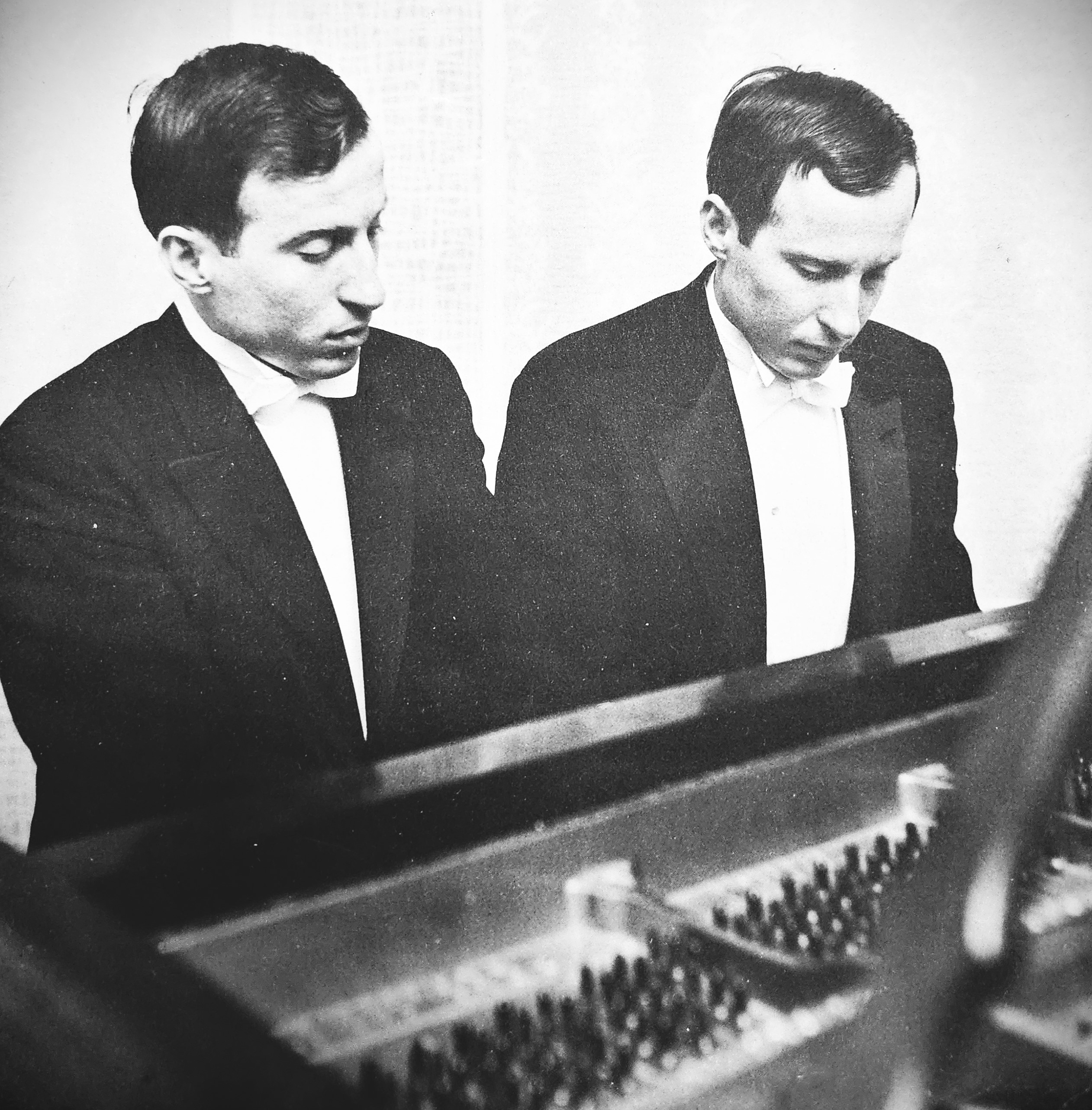
The Contiguglias were taught by Jean Wilder before attending Yale College and studying with Bruce Simonds. At Yale, they graduated summa cum laude with identical 4-year averages. The twins went on to earn MMus degrees from the Graduate School of Music at Yale, continuing their studies with Simonds. Following their graduation, the Contiguglias moved to London to study with Dame Myra Hess from 1961-1965. The twins made their debut at Wigmore Hall in 1962 before touring Europe and North America.
The Contiguglias are also esteemed educators, having taught at Syracuse University and the Horace Mann School in New York.
SERIES DESCRIPTION
Series I- Performance Files
Series II- Audio-Visual
Series III- Miscellaneous
Series IV- Scores
Louis Crowder Collection
Louis Crowder was born in Springfield, Illinois on July 5, 1907. He graduated from the School of Fine Arts of the Carnegie Institute of Technology with a major in piano under Selmar Janson, and was awarded several scholarships for study in Europe. He went on to study in Berlin with Eugen D'Albert, one of the greatest of Liszt's pupils, and with Egon Petri, equally famous as pianist and pedagogue. Robert Casadesus, then unknown in this country, drew him to Paris, where he began, under the guidance of the great Frenchman, studies that continued through the next two years and intermittently for several years thereafter. Extensive stays in Spain gained him an acquaintance with yet another musical culture.
Before returning from his European studies, Crowder played a series of concerts in European capitals, still in their pre-World War II artistic vitality. London, Paris, Vienna, Budapest, Berlin, Leipzig, and other received him with favor, as did many American pianists to perform in Europe. On invitation of the Norway America Association, he gave a series of concerts in a number of Norwegian cities, and in recognition was received by the late King Haakon.
Crowder's teaching career included appointments at Mount Union College at Alliance of Ohio, the Iowa State Teacher's College at Cedar Falls of Iowa, Northwestern University at Evanston of Illinois, University of Connecticut at Storrs. He had conducted conferences in piano pedagogy and piano workshops in various cities and colleges.
Emil Danenberg Collection
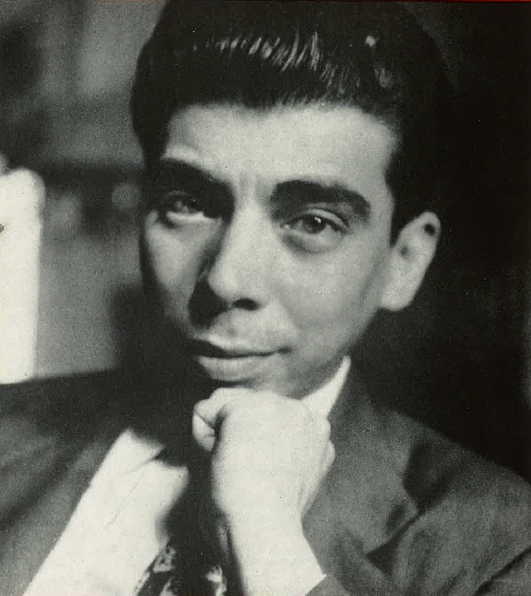 Emil Danenberg was born in Hong Kong in 1917. His initial studies were with his father, a graduate of the Leipzig Conservatory. After his family emigrated to Los Angeles in 1926, Danenberg continued his piano studies with Abby De Avirett and Edward Steuermann while also studying theory with Arnold Schoenberg. Danenberg received B.A. and A.M. degrees from UCLA and honorary degrees from Marietta College and Franklin College. He made his New York debut in 1950 followed by a Town Hall recital in 1953 in which he played a diverse program ranging from Bach to Kirchner. Concerts followed in Darmstadt, Salzburg, Vienna, Graz and throughout the United States and Canada. Danenberg maintained an active chamber music career, collaborating with violinists Matthew Raimondi, Stuart Canin and Andor Toth, and cellist Pierre Fournier.
Emil Danenberg was born in Hong Kong in 1917. His initial studies were with his father, a graduate of the Leipzig Conservatory. After his family emigrated to Los Angeles in 1926, Danenberg continued his piano studies with Abby De Avirett and Edward Steuermann while also studying theory with Arnold Schoenberg. Danenberg received B.A. and A.M. degrees from UCLA and honorary degrees from Marietta College and Franklin College. He made his New York debut in 1950 followed by a Town Hall recital in 1953 in which he played a diverse program ranging from Bach to Kirchner. Concerts followed in Darmstadt, Salzburg, Vienna, Graz and throughout the United States and Canada. Danenberg maintained an active chamber music career, collaborating with violinists Matthew Raimondi, Stuart Canin and Andor Toth, and cellist Pierre Fournier.
Danenberg commenced a long association with Oberlin College in 1944 by joining the piano faculty. He would serve as the Dean of the Conservatory of Music, and later was appointed President of Oberlin College. As an administrator, Danenberg was responsible for expanding and diversifying Oberlin’s curriculum to encompass new courses and majors in early music, jazz and ethonomusicology. Emil Danenberg died in 1982.
Bella Davidovich Collection
Bella Davidovich was born in Baku, Azerbaijan (at that time, the Azerbaijan Soviet Socialist Republic) on July 16, 1928. She began playing the piano by ear when she was three years old and began formal piano lessons when she was six. Her early concerts in Baku up until she was thirteen included performances of Concertos by Beethoven, Schumann and Grieg. She was sent to Moscow to study with Konstantin Igumnov, but her studies were interrupted by the outbreak of World War II. She resumed her studies with Igumnov in 1946 and continued with him until his death in 1948. She received additional coaching from Yakov Flier. 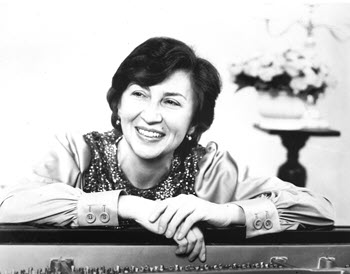
At the age of twenty one, Davidovich’s international career was launched when she won the 1949 Chopin Competition in Warsaw (sharing first place with Halina Czerny-Stefanska). The following year she performed with the Leningrad Philharmonic and toured extensively with that orchestra over the next twenty eight seasons. During that time she played as many as seventy concerts a year in the Soviet Union, in addition to concerts in Eastern Europe. In 1950 she married the acclaimed Soviet violinist Yulian Sitkovetsky, who died in 1958 at the age of 32. Their son, Dmitry Sitkovetsky (born 1954) is a world renowned violinist and conductor.
Davidovich was among the most highly regarded artists in the Soviet Union, but government restrictions prohibited her from performing in the West until 1967, when she gave concerts in Amsterdam. In 1978, she abandoned her engagements in Europe and applied to emigrate to the United States to be with her son, who had emigrated the previous year to study at the Juilliard School. Though she was not widely known in the West, she quickly established herself among the greatest of pianists beginning with her 1979 Carnegie Hall debut.
Davidovich’s repertoire is wide-ranging, with a particular emphasis on the Romantics. She has built a considerable reputation as a Chopin specialist. She has been soloist with the leading orchestras of the United States and throughout the world, and has performed frequently with her son, Dmitry Sitkovetsky. She has held teaching posts at the Moscow Conservatory and the Juilliard School and served on the juries of several international piano competitions, including the Chopin, Leeds and Queen Elisabeth competitions. Her many recordings have appeared on the Melodiya, Philips, Delos and Orfeo labels.
SERIES DESCRIPTION
Series I- Concert Programs (1965-2008)
Series II- Articles and Reviews
Series III- Biographical / Promotional Files
Series IV- Photographs and Scrapbook Materials
Series V- Adjudication
Series VI- Correspondence
Series VII- Awards and Memorabilia
Series IX- Recordings
Jed Distler Collection
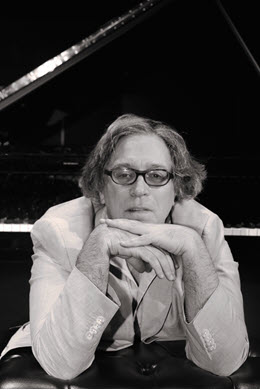 Jed Distler, composer, pianist, writer and radio host, was born on December 8, 1956 in West Orange, New Jersey. He studied piano and music theory with Vera Tisheff until age 14, then attended the Juilliard Pre-College, where he studied composition with Lawrence Widdoes and Andrew Thomas. At eight, Distler met pianist, composer and arranger Dick Hyman, who became a lifelong friend and mentor. As a Sarah Lawrence College undergraduate, Distler studied piano with Stanley Lock, composition with David Maslanka, and counterpoint with Joel Speigelman. Other important teenage influences included composer/pianists Robert Helps and Frederic Rzewski.
Jed Distler, composer, pianist, writer and radio host, was born on December 8, 1956 in West Orange, New Jersey. He studied piano and music theory with Vera Tisheff until age 14, then attended the Juilliard Pre-College, where he studied composition with Lawrence Widdoes and Andrew Thomas. At eight, Distler met pianist, composer and arranger Dick Hyman, who became a lifelong friend and mentor. As a Sarah Lawrence College undergraduate, Distler studied piano with Stanley Lock, composition with David Maslanka, and counterpoint with Joel Speigelman. Other important teenage influences included composer/pianists Robert Helps and Frederic Rzewski.
In 1980 the jazz pianist Bill Evans asked Distler to edit his improvised solos for publication; Distler had just edited and transcribed a book of Art Tatum solos, published by Consolidated Music. Later on, Distler transcribed and arranged Bill Evans’ music for Jean-Yves Thibaudet’s Decca release “Conversations with Bill Evans,” and was commissioned by Steven Mayer to transcribed further Tatum solos for concert and recording purposes.
After settling in New York City, Distler worked at Sarah Lawrence College as Music Director of the Theater Department from 1978 through 2002, and later as a guest faculty member, while pursuing an eclectic freelance career as composer and pianist. His diverse collaborations include many luminaries of opera, cabaret, dance, and new music. Andrew Thomas, William Schimmell, Andrew Violette, Alvin Curran and Frederic Rzewski are among the composers who have written works especially for Distler.
In 1987, Distler and his wife Célia Cooke (1948-2011) founded ComposersCollaborative, Inc., a not-for-profit organization devoted to presenting and producing new music. As artistic director, Distler created a number of innovative New York-based festivals and performance series.
He launched another career in 1992 as a professional freelance writer, contributing record reviews and articles to a number of publications (primarily Gramophone and Classicstoday.com), and annotating many box sets devoted to reissues of important pianists. In 2007, Distler helped to uncover the Joyce Hatto scandal, in which more than 100 CDs issued under her name turned out to have been stolen from recordings by other pianists.
In 2015 WWFM.Org The Classical Network chose Distler as the station’s first Artist-in-Residence, inviting him to create, produce and host “Between the Keys,” a weekly program encompassing a broad range of the piano world’s artists, styles, genres, repertoire and trends. The show received ASCAP’s 2017 Deems Taylor/Virgil Thomson Award for excellence in broadcasting.
After Célia Cooke’s death, Distler married the Italian painter and art conservator Maria Scarpini, with whom he collaborates on artistic projects, including a 2013 multi-keyboard event that won a Guinness Book world record, and the chamber opera Tools, with libretto by Luigi Ballerini.
Distler’s compositions, arrangements and piano performances are available on the Decca, Nonesuch, Point, Bridge, CRI, Musical Concepts and TNC labels. He also records for Steinway & Sons’ Spirio high definition player piano. Further information is available at www.jeddistler.com, and www.composerscollab.org.
The Jed Distler Collection consists of audio-visual materials, and papers related to the Composers Collaborative and other aspects of Distler's varied career. Future additions to the collection are anticipated.
Jacob Eisenberg Collection
Jacob Eisenberg was born in Alton, IL in 1898. As an author, teacher and lecturer, he focused on piano technique and articulated principles related to weight and relaxation. His writings on technique received the endorsement of many pianists, including Vladimir de Pachmann. Eisenberg died in 1964. 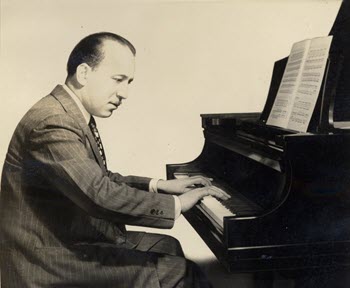
The Jacob Eisenberg Collection consists of over 40 bound volumes containing manuscripts, drafts and published works by Eisenberg.
I. Books on Piano Technique, including Weight and Relaxation in Piano Playing, Natural Technics in Piano Mastery, and Let Me Help You.
II. Piano Courses, including The Pianist, a standard Piano Course, Child Piano Course, Junior Piano Course and Adult Piano Course.
III. Articles and interviews published in Music in Your Home, Rockland County Evening Journal and various other publications.
IV. Piano Exercises based on scales, and The New Hanon, Eisenberg’s elaboration on the famous Hanon exercises.
Leonard Eisner Collection
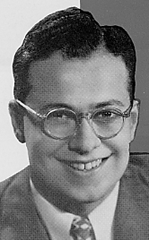 Leonard Eisner was born in Brooklyn, New York on June 29th, 1920. After graduating from Juilliard and a stint in the army, Eisner made his professional debut in 1946 at Town Hall in New York City. This led to an extensive touring career that took him all over North America, Europe and Japan. Aside from performing, Eisner was also an accomplished teacher. He was a faculty member at the Carnegie Institute of Technology and the Usdan Center for the Arts. He was also an affiliate teacher at SUNY-Purchase and had adjunct faculty appointments at Hunter College and Queens College. He was also a member of the piano faculty at Juilliard's Pre-College division, part of a 63-year association with the school. Eisner died in 1991.
Leonard Eisner was born in Brooklyn, New York on June 29th, 1920. After graduating from Juilliard and a stint in the army, Eisner made his professional debut in 1946 at Town Hall in New York City. This led to an extensive touring career that took him all over North America, Europe and Japan. Aside from performing, Eisner was also an accomplished teacher. He was a faculty member at the Carnegie Institute of Technology and the Usdan Center for the Arts. He was also an affiliate teacher at SUNY-Purchase and had adjunct faculty appointments at Hunter College and Queens College. He was also a member of the piano faculty at Juilliard's Pre-College division, part of a 63-year association with the school. Eisner died in 1991.
Philip Fowke Collection
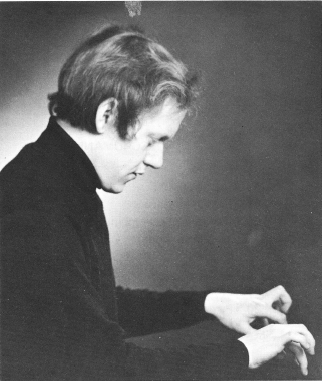 English pianist Philip Fowke was born in 1950. His primary studies were at the Royal Academy of Music with Gordon Green, a pupil of Egon Petri. After making his London debut at the Wigmore Hall in 1974, Fowke competed in international competitions such as the Sydney International Piano Competition, the Tchaikovsky Competition, and the BBC Piano Competition, where he shared 2nd place (1st place not being awarded). Fowke has appeared in concert with many of the world’s leading conductors, including Vladimir Ashkenazy, Sir Charles Groves, Neeme Järvi, Simon Rattle, Gennady Rozhdestvensky and Yuri Temirkanov. Fowke has a broad repertoire containing both standard works and numerous compositions by British composers such as Delius, Bliss and Britten. Fowke’s discography consists of recordings of piano concertos, solo works and chamber music along with diverse recording projects such as, “Virtuoso Piano Transcriptions” and “Piano Concertos from the Movies”. His CDs appear on the EMI, CRD, Lyrita, Naxos, Unicorn and Chandos labels. Fowke has held positions at the Royal Academy of Music and the Trinity College of Music. He regularly gives masterclasses worldwide and adjudicates at international competitions.
English pianist Philip Fowke was born in 1950. His primary studies were at the Royal Academy of Music with Gordon Green, a pupil of Egon Petri. After making his London debut at the Wigmore Hall in 1974, Fowke competed in international competitions such as the Sydney International Piano Competition, the Tchaikovsky Competition, and the BBC Piano Competition, where he shared 2nd place (1st place not being awarded). Fowke has appeared in concert with many of the world’s leading conductors, including Vladimir Ashkenazy, Sir Charles Groves, Neeme Järvi, Simon Rattle, Gennady Rozhdestvensky and Yuri Temirkanov. Fowke has a broad repertoire containing both standard works and numerous compositions by British composers such as Delius, Bliss and Britten. Fowke’s discography consists of recordings of piano concertos, solo works and chamber music along with diverse recording projects such as, “Virtuoso Piano Transcriptions” and “Piano Concertos from the Movies”. His CDs appear on the EMI, CRD, Lyrita, Naxos, Unicorn and Chandos labels. Fowke has held positions at the Royal Academy of Music and the Trinity College of Music. He regularly gives masterclasses worldwide and adjudicates at international competitions.
The Philip Fowke Collection consists of concert programs and articles documenting Fowke’s concert career from 1970-2003.
Claude Frank and Lilian Kallir Collection
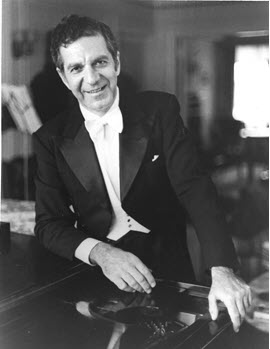 Claude Frank was born in Nurenberg, Germany on December 24, 1925. At age 12 he went to live in Brussels and then Paris, where he studied at the Paris Conservatoire. The German occupation forced him to leave France. He came to the U.S. in 1941 and studied at Columbia University in New York City. Frank also studied privately for nearly ten years with Artur Schnabel. He debuted with Leonard Bernstein and the New York Philharmonic in 1959 and began a touring career that covered six continents. A milestone of Frank’s career was RCA’s release of his recordings of the 32 Beethoven Sonatas to critical acclaim, and his worldwide performances of the cycle. Frank was also dedicated to the chamber music repertoire, and throughout his career he performed and taught at the Marlboro and Norfolk Music Festivals, in addition to his performances with the Boston Symphony Chamber Music Players, the Chamber Music Society of Lincoln Center, the Emerson, Juilliard and Tokyo Quartets, Alexander Schneider’s chamber ensembles and his collaborations with his daughter, violinist Pamela Frank (with whom he recorded Beethoven’s 10 Sonatas for Violin and Piano), and his wife, pianist Lilian Kallir. He also has had a successful career as an instructor, teaching at the Yale School of Music, the Curtis Institute of Music and the University of Kansas, among others. His recordings have appeared on the RCA Victor, Music & Arts, and MusicMasters labels. Claude Frank died in New York on December 27, 2014, at age 89.
Claude Frank was born in Nurenberg, Germany on December 24, 1925. At age 12 he went to live in Brussels and then Paris, where he studied at the Paris Conservatoire. The German occupation forced him to leave France. He came to the U.S. in 1941 and studied at Columbia University in New York City. Frank also studied privately for nearly ten years with Artur Schnabel. He debuted with Leonard Bernstein and the New York Philharmonic in 1959 and began a touring career that covered six continents. A milestone of Frank’s career was RCA’s release of his recordings of the 32 Beethoven Sonatas to critical acclaim, and his worldwide performances of the cycle. Frank was also dedicated to the chamber music repertoire, and throughout his career he performed and taught at the Marlboro and Norfolk Music Festivals, in addition to his performances with the Boston Symphony Chamber Music Players, the Chamber Music Society of Lincoln Center, the Emerson, Juilliard and Tokyo Quartets, Alexander Schneider’s chamber ensembles and his collaborations with his daughter, violinist Pamela Frank (with whom he recorded Beethoven’s 10 Sonatas for Violin and Piano), and his wife, pianist Lilian Kallir. He also has had a successful career as an instructor, teaching at the Yale School of Music, the Curtis Institute of Music and the University of Kansas, among others. His recordings have appeared on the RCA Victor, Music & Arts, and MusicMasters labels. Claude Frank died in New York on December 27, 2014, at age 89.
Lilian Kallir was born in Prague on May 6, 1931. After her arrival in New York in 1940 she studied with Herman de Grab and Isabelle Vengerova. Her professional career began at age 17, when she made her debut with Dimitri Mitropoulos and the New York Philharmonic. 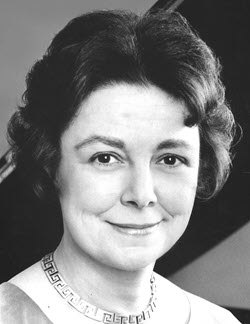 She performed as soloist with the major symphony orchestras of the world such as the Boston, Chicago, London, Leipzig Gewandhaus and Vienna Symphony Orchestras, and she appeared with many of the leading conductors of her time such as von Karajan, Giulini, Leinsdorf, Skrowaczewski and Jochum. A distinguished Mozart player, Kallir appeared frequently in the Mostly Mozart Festival of the Lincoln and Kennedy Centers, and the Midsummer Mozart Festival in San Francisco. She collaborated in chamber music concerts with Pinchas Zukerman, Yo-Yo Ma, Richard Stolzman, and the Cleveland, Emerson, Guarneri, Juilliard and Tokyo Quartets. She married Claude Frank in 1959, and the two appeared in concert regularly in recital and as soloists. Lilian Kallir died on October 25, 2004.
She performed as soloist with the major symphony orchestras of the world such as the Boston, Chicago, London, Leipzig Gewandhaus and Vienna Symphony Orchestras, and she appeared with many of the leading conductors of her time such as von Karajan, Giulini, Leinsdorf, Skrowaczewski and Jochum. A distinguished Mozart player, Kallir appeared frequently in the Mostly Mozart Festival of the Lincoln and Kennedy Centers, and the Midsummer Mozart Festival in San Francisco. She collaborated in chamber music concerts with Pinchas Zukerman, Yo-Yo Ma, Richard Stolzman, and the Cleveland, Emerson, Guarneri, Juilliard and Tokyo Quartets. She married Claude Frank in 1959, and the two appeared in concert regularly in recital and as soloists. Lilian Kallir died on October 25, 2004.
SERIES DESCRIPTION
Claude Frank Materials
I – Performance Files
II – Teacher/Adjudicator
III – Photographs
IV – Correspondence
Lilian Kallir Materials
I – Performance Files
II – Correspondence
III – Photographs
IV – Miscellaneous
Recordings
78rpm and 33rpm discs, cassettes and reel tapes of commercially issued and live performances by Claude Frank and Lilian Kallir
Irwin and Lillian Freundlich Collection
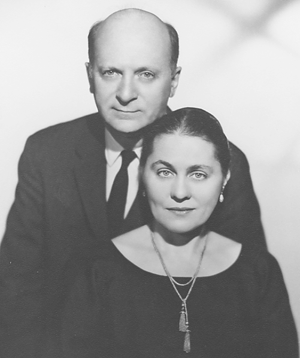 Irwin Freundlich (1908 - 1977) was an internationally recognized piano educator who taught at the Juilliard School in New York for more than 40 years.
Irwin Freundlich (1908 - 1977) was an internationally recognized piano educator who taught at the Juilliard School in New York for more than 40 years.
He studied piano with James Friskin and Edward Steuermann at the Institute of Musical Art (parent school of the present Juilliard), and took further studies in musicology with Paul Henry Lang and Erich Hertzmann at Columbia University.
In 1935, he became a member of the faculty at Juilliard and continued to maintain a heavy teaching schedule there in the piano department. He was the co-author with James Friskin of "Music For Piano: A Handbook of Teaching and Concert Material," published in 1954 and currently available from Dover Publications.
His students have concertized throughout the world and have been prize winners in numerous prestigious national and international competitions, such as the Naumberg and Leventritt in New York, the Van Cliburn in Texas, the Mozart in Austria, the Busoni in Italy, the Enescu in Romania, the Liszt-Bartok in Hungary, the J. S. Bach in Washington, D. C. and the Kosciuszko in New York, among many others.
For thirteen summers (1953 - 1965), Irwin Freundlich held master classes on the campus of Bennington College in Vermont. He also performed recitals and conducted master classes, seminars and workshops at many institutions of higher learning throughout the United States, as well as serving on important juries for national and international competitions. He appeared in many recitals of music for one piano four hands with his wife, Lillian Freundlich.
Lillian Freundlich was a distinguished member of the Piano Department at the Peabody Conservatory of Music and was also a member, at times, of the faculties at Juilliard Summer School, the Oberlin Conservatory of Music and the North Carolina School of the Arts. Aside from her performances with her husband, Lillian Freundlich also performed solo recitals in the U.S. and Europe.
SERIES DESCRIPTION
Series I - Performance Files
Here are found programs, reviews, advertisements, and promotional materials that are related to specific performances of the Freundlichs. The materials are organized chronologically by performance date, and span the period 1935 through 1984. The numbers in parentheses represent the number of copies in that subdivision. This series is located in box 1 and has been divided into the following subseries:
Subseries 1 - Irwin Freundlich (1945 - 1968)
Subseries 2 - Lillian Freundlich (1935 - 1984)
Subseries 3 - Irwin & Lillian Freundlich (1968 - 1972)
Series II - Irwin Freundlich Teaching Files
Here are found students' programs, reviews, advertisements and promotional materials that are related to Irwin's teaching. This series is located in box 1 and all subseries are organized chronologically by performance date, except subseries 2:
Subseries 1 - Juilliard studio recitals (1947 - 1960)
Subseries 2 - Juilliard student recitals (A - Y)
Subseries 3 - Bennington recitals (1953 - 1965)
Subseries 4 - Irwin master classes (1950 - 1976)
Series III - Lillian Freundlich Teaching Files
Here are found students' programs, reviews, advertisements and promotional materials related to Lillian's teaching. This series is located in box 1 and has been divided into the following four subseries. Subseries 1 & 3 are organized alphabetically by performer's name. Subseries 2 & 4 are organized chronologically by performance date .
Subseries 1 - Peabody student recitals (names in alphabetical order)
- 1st folder (A - H)
- 2nd folder (H - Z)
Subseries 2 - Peabody student recitals (1972 - 1989)
Subseries 3 - Private student recitals (F - W)
Subseries 4 - Lillian master classes (1968 - 1987)
Series IV - Student Activities
Here are found programs, reviews, and advertisements that are related to specific performances of the students. This series is located in boxes 2 and 3.
Subseries 1 - Names in chronological order (1953 - 1977)
Subseries 2 - Names in alphabetical order (B - W)
Series V - Program Files
Here are found duplicate programs that are related to specific performances by the Freundlichs and their students. This series is located in boxes 3 and 4.
Box 3 contains 12 folders. Box 4 contains 26 folders.
Series VI - Recording Files
Here are found reel-to-reel tapes containing performances of the Freundlichs and thei students. This series is located in boxes 5 through 7.
Subseries 1 - Irwin Freundlich (1954 - 1973)
Subseries 2 - Lillian Freundlich (1959 - 1976)
Subseries 3 - Juilliard student recitals (A - V)
Series VII - Correspondence
This series is located in boxes 8 through 9 and is divided into three categories:
Subseries 1 - Irwin Files
- Letters to Irwin
- Letters from Irwin
- Bennington Correspondence
- Irwin foreign Correspondence
- Correspondence File
Subseries 2 - Lillian Files
- Letters to Lillian
- Letters from Lillian
- Correspondence File
- Professional Correspondence File
Subseries 3 - Third-Party Correspondence
Series VIII - Subject Files
This series is located in box 9 and is divided into two categories:
Subseries 1 - Irwin Freundlich
- Biographical Notes
- Biographical Files
- Reviews
- Juilliard courses outline
Subseries 2 - Lillian Freundlich
- Biographical Files
- Reviews
Series IX - Additional Subject Files
This series is located in box 9 and is divided into four categories:
Subseries 1 - Competitions
Subseries 2 - Travel files
- Bennington Summer Program
- Travel Agency
Subseries 3 - Ralph Freundlich files
Subseries 4 - Friends' files
Series X - Irwin's Writings
This series is located in box 10 and is divided into three categories:
Subseries 1 - Articles, Lectures, Notes
Subseries 2 - Incomplete Score Samples
Subseries 3 - Publisher Correspondence
Series XI - Photographs
This series consists of 260 photographs and is located in box 10.
Subseries 1 - Family Photographs (126)
- Lillian (33)
- Irwin (25)
- Family (56)
- Friends (12)
Subseries 2 - Students photographs (112)
- Photographs with students (19)
- Bennington photographs (45)
- Student photographs (48)
Subseries 3 - Personal collections (22)
- Miscellaneous (14)
- Postcards (6)
- Photos with frame (2)
Series XII - Miscellaneous
This series is located in boxes 10 through 11 and is divided into two categories:
Subseries 1 - Journals, Magazines
Subseries 2 - Books, Programs
Subseries 3 - Other Materials (15 folders)
Carl Friedberg Collection
Carl Rudolph Hermann Friedberg was born September 18, 1872 in Bingen-am-Rhein, Germany. He began studying music in 1876 and then moved to Frankfurt in the early 1880s for further study, including occasional lessons from Clara Schumann. He was also coached by Johannes Brahms in the performance of Brahms' piano works. Soon after, Friedberg became self-sufficient as a teacher in his own right and, within a few years, began performing. 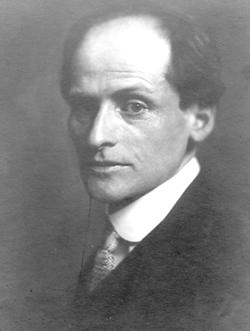
In 1891, he took the first of many international excursions when he toured Spain. This was followed by more European touring, as well as a fortuitous stint as a teacher at the Hoch Conservatory in Frankfurt. This position afforded him the chance to tour widely.
In 1914, Friedberg made his first appearance in the U.S. Soon thereafter, he joined the faculty of the Institute for Musical Arts, which later became the Juilliard School.
Friedberg's only studio recordings date from 1953 (two years before his death) and have now been reissued on CD by Marston Records together with additional live and studio performances.
Friedberg died on September 9th, 1955.
SERIES DESCRIPTION
Series I: Performance Files
This series comprises reviews, programs and publicity materials organized chronologically by performance date. The materials are located in Box 1 of the collection.
Series II: Photographs
This series comprises photographs that are organized into three sub-series: A. Photographs of Carl Friedberg alone; B. Photographs of Carl Friedberg and others; and C. Photographs used as illustrations for the Carl Friedberg book written by Julia Smith. These photographs are located in Box 1 of the collection.
Series III: Guest Book
This book appears to comprise names and possible appearance or performance dates of CF's students.
Series IV: Scrapbooks I and II
These scrapbooks are two blue-cloth loose-leaf notebooks that contain newspaper articles, biographical brochures, and descriptive materials pertaining to CF and his master classes, to the Carl Friedberg Alumni Association, and to the recording CF made in his later years. Scrapbook II also contains articles about the death of CF and the subsequent formation of the Carl Friedberg Music Foundation, Inc. These scrapbooks are located in Box 1 of the collection.
Series V: Subject Files
This series consists of additional newspaper articles, brochures, and correspondence pertaining to CF over and above what is included in Series I, II, III, and IV. Also included here are personal memorabilia, and materials pertaining to performances by the students of CF. These materials are located in Box 1 and Box 2 of the collection.
Series VI: Additional Materials
Here are found materials which were added to the collection at a later date. They are located in Box 3.
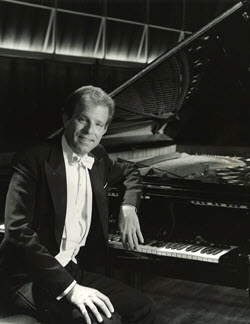 Irwin Gage Collection
Irwin Gage Collection
American pianist Irwin Gage was a renowned specialist in accompanying Lieder who collaborated with many of the greatest singers of his day. He was born in Cleveland, OH in 1939 to a Hungarian father and a Russian mother. After studying piano, musicology and literature at the University of Michigan and Yale University, he went on to study at the Vienna Music Academy with Erik Werba. He also received instruction in the French art song repertoire in Paris from French baritone Pierre Bernac. Among the many singers he performed with were Elly Ameling, Arleen Auger, Walter Berry, Brigitte Fassbaender, Dietrich Fischer-Dieskau, Gundula Janowitz, Rene Kollo, Tom Krause, Christa Ludwig, Edda Moser, Jessye Norman, Lucia Popp, Hermann Prey, Christine Schäfer, Peter Schreier, Cheryl Studer and Martti Talvela. Gage made recordings on such labels as Decca, Philips, Telefunken, Deutsche Grammophon, EMI and CBS Masterworks which garnered numerous awards, including the Grand Prix du Disques, the German Schallplattenprei and the Edison and Grammophone awards. As a teacher, Gage taught song interpretation classes at the Academy of Music and Theater in Zurich (now Zurich University of the Arts) from 1979 to 2005, and at the Saarbrücken Music Academy. Gage served on many juries for international music competitions and gave master classes in Europe, Japan and the United States. Gage died on April 12, 2018 in Zurich, where he resided for many years.
SERIES DESCRIPTION
Series I – Concert Programs
Series II – Articles / Reviews
Series III – Teaching / Adjudication
Series IV – Photographs
Series V – Correspondence
Series VI – Recordings
Series VII – Scores
Series VIII – Writings by Gage
Series IX - Miscellaneous
Donald Garvelmann Collection
Donald Garvelmann, a New York pianophile, collector, pianist and music publisher who died in 2001, was one of the great amateur enthusiasts of the keyboard. He amassed not only a remarkable collection of rare piano scores from the 19th and 20th centuries, but also a truly formidable knowledge of piano literature. He contributed liner notes to many recordings of rare repertoire (including Michael Ponti's complete Scriabin survey for Vox), and was instrumental in generating interest in the music of Kaikhosru Shapurji Sorabji. As a friend of Sorabji who both met and corresponded with him, Garvelmann obtained Sorabji's permission for pianist Michael Habermann to give many first performances and recordings of Sorabji's piano works.
Garvelmann's enthusiasm for unjustly neglected piano repertoire was channeled into Music Treasure Publications, of which he was the sole director. During its existence, MTP offered high-quality reprints, with extensive annotations, of concertos by Moscheles (No.3), Scharwenka (No.1), Litolff (No.3), and Henselt (F Minor), as well as solo pieces by Herz and Thalberg. IPAM houses the remaining MTP stock of these scores. Copies are now available through IPAM at reasonable cost. Specific details may be obtained by contacting the Curator.
Reginald Gerig Collection
Reginald R. Gerig is Professor Emeritus of Piano at Wheaton College (Wheaton, IL), where he served on the faculty from 1952 to 1987. Fourteen of those years were spent as chairman of the college's piano department. He is past president of Wheaton College Scholastic Honor Society and a member of the National Guild of Piano Teachers, the Illinois State Music Teachers Association, and the Music Teachers National Association.
Born in Fort Wayne, IN, Mr. Gerig won the state piano competition at Indiana University at the age of fifteen. He was granted a Bachelor of Music degree with highest honors from Wheaton College, and went on to The Juilliard School where he earned B.S. and M.S. degrees in piano. Before returning to Wheaton in 1952, he taught for two years on the piano faculty of the Eastman School of Music in Rochester, NY. He has appeared frequently as both pianist and lecturer.
Mr. Gerig has been widely praised for his 1974 book, Great Pianists and Their Technique, originally published by Robert B. Luce and now available in an expanded edition from Indiana University Press. This exhaustive study describes the history of various approaches to piano technique, from the era of C.P.E. Bach to present-day theorists and practitioners. The book has long been regarded as the standard reference on the topic and it continues to serve as a unique resource for students, teachers, and performers.
The Gerig Collection in IPAM consists of extensive files of articles, references, dissertations, research notes, correspondence and other materials used by Mr. Gerig during the preparation of his book.
Leopold Godowsky Collection
Leopold Godowsky, as both pianist and composer, ranks among the great geniuses in the annals of piano playing. He was born in the small town of Sozly, near Vilna (now Vilnius), at the confluence of the Polish, Russian, and Lithuanian borders, on February 13, 1870. There is little evidence that he underwent any kind of extensive formal musical education. Godowsky gave his first public performance at the age of 9. While in his teens he spent a brief period in Paris during which Camille Saint-Saëns offered him limited musical advice. Godowsky’s official American debut took place in 1890. His sensational Berlin debut in 1900 established his reputation as a formidable pianist in a wide repertoire, and as a composer of exceptional resource and imagination. Throughout his life, Godowsky would perform all over the world—from the major centers of Europe and the US to more exotic locales such as Java, Cuba, Japan and South America. 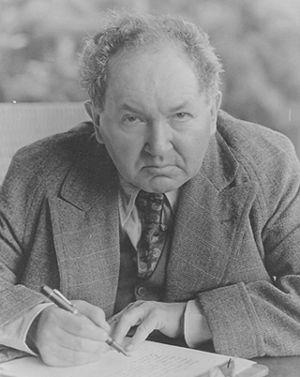
Nicknamed "The Brahma of the Keyboard" by Leon Saxe, Godowsky also held various prestigious teaching positions in Philadelphia, New York, and Chicago, later becoming director of the piano school of the Imperial Academy of Music in Vienna. With the outbreak of World War I, Godowsky moved permanently to the United States with his wife and four children, eventually settling in New York.
In the midst of his performing and teaching activity, Godowsky continued to compose a series of remarkable piano works in which he exploited the polyphonic resources of the instrument to an unprecedented degree. (Another major focus of his creativity was an expansion of the capabilities of the left hand.) Most notable among his output are the Studies on Chopin’s Etudes (54 altogether were published), as well as the four Symphonic Metamorphoses on Themes of Johann Strauss. His original piano compositions include the 24 Walzermasken, the 30 pieces in the collection titled Triakontameron, the Java Suite (the only completed portion of an ambitious project he called “Phonoramas,” intended to evoke the full range of world music), a large collection of Miniatures for four hands, a five-movement Sonata in E Minor, and the Passacaglia in B Minor, based on the opening measures of Schubert’s Unfinished Symphony.
Although most of Godowsky’s works went out of print after his death, the vast majority are now readily available in a handsome multi-volume reprint edition published by Carl Fischer of New York. This project coincided with a revival of interest in Godowsky’s compositions among pianists, and the current CD catalogues offer many acclaimed performances of most of his works.
Godowsky’s own 78rpm disc recordings, made for American Columbia, Brunswick, and English Columbia between 1913 and 1930, have been reissued in three volumes on the Marston label (seven CDs altogether) with extensive documentation. Marston’s transfer work supersedes several previous incomplete reissues of these recordings.
At a 1930 recording session in London, Godowsky suffered a stroke which effectively ended his public career as pianist. The final phase of Godowsky’s life was marked by disillusionment, owing to further personal tragedies. He died in New York on November 21, 1938.
At present there is only one published study of Godowsky’s life and career: Godowsky: The Pianists’ Pianist by Jeremy Nicholas (Appian Publications, 1989). An updated and revised edition was published by Travis & Emery (London) in 2014. It is available through Amazon and/or Abebooks.
IPAM's holdings of Godowsky materials represent the largest such collection in existence. It is particularly strong in original musical manuscripts, correspondence (over 700 letters from Godowsky to colleagues and family members), and photographs. Recently the IPAM Godowsky Collection was significantly augmented with the acquisition of many additional manuscripts and annotated first editions, won through successful bidding at Sotheby's June 2018 auction. It is expected that the majority of the Collection will become accessible online by late 2019.
SERIES DESCRIPTION
Series I- Correspondence
Series II- Biographical Sketch
Series III- Performance
Series IV- Compositions
Series V- Writings
Series VI- Miscellaneous Subject Files
Robert Goldsand Collection
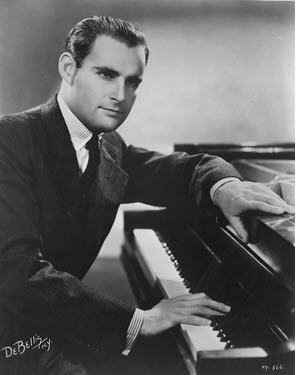
Robert Goldsand was born in Vienna, Austria on March 17, 1911. Goldsand studied under Camella Horn, Joseph Marx and Moriz Rosenthal. Goldsand began performing at the age of 10 and, around that time, toured Europe and South America. He made his American debut in 1927 at Carnegie Hall in New York City. Following a European tour, Goldsand settled in the U.S. in 1939 where he continued to make concert appearances. He also joined the faculty of the Manhattan School of Music. Goldsand made numerous recordings of works by Schubert, Schumann, Chopin, Liszt, Brahms and Rachmaninoff for the Concert Hall Society. Goldsand died in 1991.
The collection consists largely of private recordings of Goldsand's concert performances.
SERIES DESCRIPTION
Series I- Concert Materials
Series II- Articles/Undated Concert Materials
Series III- Correspondence
Series IV- Photographs
Series V- Awards
Series VI- Recordings
Ella Goldstein Collection
Ella Goldstein (later Ella Maxwell) was born in Harbin China in 1927. Her parents, the violinist and conductor Uriel Goldstein, and pianist Vera Dillon (Goldstein) had come from Russia, where they were members of the Moscow Trio. Ella Goldstein began her piano studies at age five, performed a Mozart Concerto with an orchestra conducted by her father at age seven, and made her recital debut at age nine. Concerts throughout China and Japan followed. At age 11 she traveled with her parents to Palestine for highly acclaimed concerts, and then to Holland, where she studied with Alexander Borovsky and graduated from the Amsterdam Academy of Music.
Goldstein returned to Palestine after the start of the Second World War, where she became a leading soloist with the Palestine Orchestra, performing with them on some 70 occasions in tours of Palestine, Egypt, Lebanon and Jordan. From 1944 to 1945 she embarked upon a highly successful nine month tour of South Africa. 1947 saw her New York Town Hall debut, along with performances with conductors Serge Koussevitzky, Artur Rodzinski and Leonard Bernstein the same year. In 1953 she won first prize in the 5th International Busoni Competition held in Bolzano, Italy, which brought numerous concert engagements in Italy. Goldstein made recordings of repertoire by Beethoven, Brahms, Schumann and Mussorgsky for Concert Hall Society and Musical Masterworks Society in the early LP era. She greatly curtailed her concert activity after her marriage in 1962 before reviving her performing career in the late 1970s.
SERIES DESCRIPTION
The Goldstein Collection consists of a series of scrapbooks containing programs, articles, reviews, publicity flyers and photographs which chronicle her performing career from her earliest performances to her return to concertizing from the 1970s to the 1990s. Particularly well represented are Russian language articles from Goldstein's earliest performances and concert material from her performances in Palestine, South Africa, Italy, and collaborations with Serge Koussevitzky and Leonard Bernstein. Also included are her recordings for Concert Hall Society and Musical Masterworks Society, along with transcription discs of live performances.
Gary Graffman Collection
"One of the greatest living pianists." So stated Newsweek about Gary Graffman. Accolades such as this have followed Graffman throughout his professional career, a career that has encompassed over 30 years and made him a worldwide celebrity.
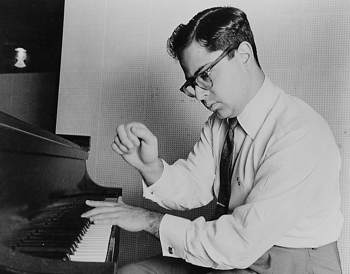 Born in New York City on October 14, 1928, Graffman showed a natural talent for the piano, beginning lessons at age three. When he was seven, Graffman was accepted by the all-scholarship Curtis Institute of Music in Philadelphia. For the next 10 years, he studied with the well-known pedagogue Madame Isabelle Vengerova. Following his graduation from Curtis, he studied for several years with Vladimir Horowitz and, during summers, with Rudolf Serkin. In 1947, Graffman made his debut with the Philadelphia Symphony Orchestra under Eugene Ormandy. Two years later, he won the prestigious Leventritt Award, which led to his debut with the New York Philharmonic, directed by Leonard Bernstein. During 1950, he studied in Europe as a Fulbright Scholar.
Born in New York City on October 14, 1928, Graffman showed a natural talent for the piano, beginning lessons at age three. When he was seven, Graffman was accepted by the all-scholarship Curtis Institute of Music in Philadelphia. For the next 10 years, he studied with the well-known pedagogue Madame Isabelle Vengerova. Following his graduation from Curtis, he studied for several years with Vladimir Horowitz and, during summers, with Rudolf Serkin. In 1947, Graffman made his debut with the Philadelphia Symphony Orchestra under Eugene Ormandy. Two years later, he won the prestigious Leventritt Award, which led to his debut with the New York Philharmonic, directed by Leonard Bernstein. During 1950, he studied in Europe as a Fulbright Scholar.
Until 1979, Gary Graffman maintained a professional career as a concert pianist, appearing with every major orchestra in the United States and recording for RCA and Columbia. His schedule of concerts and recitals, which numbered as many as 100 per year, found him not only crisscrossing North America but also the Atlantic and Pacific, highlighted by numerous tours of Central and South America, Europe, the U.S.S.R., Australia and Asia.
In 1979, an ailment to his right hand interrupted Graffman's intense performance schedule. He has subsequently limited his performing to repertoire composed exclusively for the left hand. In addition, he has written his autobiography, "I Really Should Be Practicing" (1981, Doubleday).
During the summer of 1986, Graffman became the Artistic Director of the Curtis Institute of Music in Philadelphia. Prior to this appointment, he was on the Curtis faculty as well as that of the Manhattan School of Music in New York.
Gary and Naomi Graffman were married in 1952. In addition to music, the Graffmans share an avid interest in antique Chinese ceramics.
SERIES DESCRIPTION
SERIES I - PERFORMANCE FILES
Here are found programs, reviews, advertisements, promotional materials and like documents that are related to specific performances of Graffman. The materials are organized chronologically by performance date, and span from 1934 to the present. This series is located in boxes 1 through 26 (10 linear feet).
SERIES II - RECORDING FILES
Here are found reviews, advertisements and promotional materials that are related to commercial sound recordings made by Graffman from 1956 to 1976. This series also includes material of a general nature (newspaper clippings and promotional packages) relating to Graffman's recordings.
This series has been divided into three subseries:
Subseries 1: RCA Victor Recordings (1956-1961) and Victrola Reissues
Subseries 2: Columbia Recordings (1962-1976)
Subseries 3: Miscellaneous Material
In subseries 1 and 2, the materials are arranged chronologically by record issue number.
This series is located in box 27 and consists of approximately 200 items.
SERIES III - CORRESPONDENCE
This series comprises 22 items:
- 10 pieces of incoming correspondence
- 2 pieces of outgoing correspondence
- 10 pieces of correspondence written by persons other than Graffman.
The correspondence is located in box 28.
SERIES IV - SUBJECT FILES
Here are found various documents that have been divided into the following subseries:
Subseries 1: Education - including reports cards from Curtis Institute and material relating Graffman's Fulbright Scholarship
Subseries 2: Awards - including material relating to the Rachmaninoff Fund and Leventritt competitions
Subseries 3: Graffman as Clinician, Adjudicator, Teacher, and Administrator
Subseries 4: Press Materials
Subseries 5: Professional Engagement Books from 1958 to 1979
Subseries 6: Contracts and related documents, including correspondence
Subseries 7: General/Biographical Newspaper and Magazine Articles
Subseries 8: Graffman as author
This series is located in boxes 29 through 32 (2 linear feet).
SERIES V - PHOTOGRAPHS
Here are found photographs and negatives that have been divided into the following subseries:
Subseries 1: Publicity Photographs and Portraits
Subseries 2: Graffman Performing
Subseries 3: Colleagues and Friends
Subseries 4: Snapshots and Slides
Subseries 5: Casual Photographs
Subseries 6: Miscellaneous Photographs
Subseries 7: Photographs of people other than Graffman
This series is located in boxes 33 and 34 (1 linear foot).
Mark Hambourg Collection
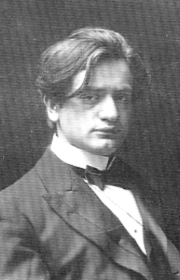
Mark Hambourg was born in Boguchar on May 31, 1879. He commenced performing in 1888, in Moscow, and soon began performing throughout the major cities of Europe. His principal piano studies were in Vienna with Theodor Leschetizky. Eventually Hambourg settled in London, England and, along with occasional orchestral engagements, he primarily focused on recital-giving. Between about 1909 and 1933, Hambourg recorded copiously for the Gramophone Company (HMV). Reissues of some of Hambourg's recordings have appeared on compact discs from Pearl and from Arbiter. Hambourg died in Cambridge, England on August 26, 1960.
SERIES DESCRIPTION
Series I - Scrapbooks and Miscellaneous Items
Walter Hautzig Collection
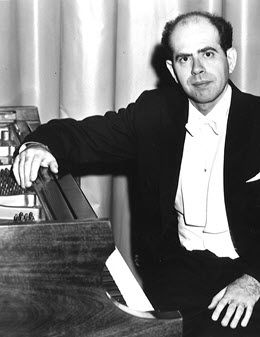 Walter Hautzig was born in Vienna on September 28, 1921. He was able to escape Nazi-occupied Vienna in 1938 when an audition won him a fellowship grant to study at the Jerusalem Conservatory. He immigrated to the United States in 1939, where he studied at the Curtis Institute of Music. His principal teachers were Mieczyslaw Munz and Artur Schnabel. He has played concerts in more than 50 countries worldwide, earning particular acclaim in Japan, where he has also recorded extensively.
Walter Hautzig was born in Vienna on September 28, 1921. He was able to escape Nazi-occupied Vienna in 1938 when an audition won him a fellowship grant to study at the Jerusalem Conservatory. He immigrated to the United States in 1939, where he studied at the Curtis Institute of Music. His principal teachers were Mieczyslaw Munz and Artur Schnabel. He has played concerts in more than 50 countries worldwide, earning particular acclaim in Japan, where he has also recorded extensively.
In 1979 he was chosen by the State Department to be the first concert artist from the United States to perform in the People's Republic of China after the normalization of relations between the two countries. His recitals in Peking were heard by approximately 900 million people via radio and television. His playing is known to American record collectors through discs issued by Haydn Society, United Artists, Vox, Monitor, Connoisseur Society and Americus. Hautzig's extensive repertoire has emphasized the Viennese classicists as well as Chopin, Schumann, Brahms and various Russian and Latin-American composers.
For many years, Hautzig was a faculty member at the Peabody Conservatory. He also formed a long-term musical partnership with cellist Paul Olefsky, with whom he has often played sonatas of Beethoven, Brahms and Schubert. Walter Hautzig died on January 30, 2017.
SERIES DESCRIPTION
I – Performance Files
- Scrapbooks
- Programs, Reviews
II – Biographical Files
III – Teaching and Adjudication
IV – Photographs
V – Correspondence
VI – Miscellaneous
VII – Mieczyslaw Munz Materials
VIII – Scores
IX – Audio-Visual
Joanna Hodges Collection
Joanna Hodges was born on October 28, 1932 in San Pedro, CA. She studied with Mae Gilbert Reese at the Los Angeles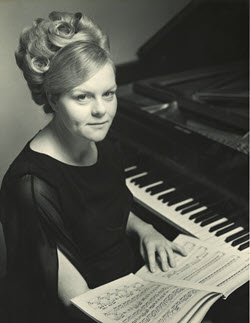 Conservatory of Music (California Institute of Arts), and with John Crown at the University of Southern California. Additional studies were with Rudolf Firkusny at the Aspen School of Music and with Bruno Seidlhofer at the University of Vienna. Performances in Vienna, London, Amsterdam, Berlin and other European cities were followed by a New York debut at Town Hall in 1959. In addition to regular concert appearances in her native California, Hodges performed extensively in European countries such as England, Austria, Germany, Greece, Holland, Switzerland and Sweden, along with performances in Taiwan, India, Hong Kong and Russia. Hodges received the distinction of being the first American woman pianist to be invited to do a major tour of Romania (1961-1962).
Conservatory of Music (California Institute of Arts), and with John Crown at the University of Southern California. Additional studies were with Rudolf Firkusny at the Aspen School of Music and with Bruno Seidlhofer at the University of Vienna. Performances in Vienna, London, Amsterdam, Berlin and other European cities were followed by a New York debut at Town Hall in 1959. In addition to regular concert appearances in her native California, Hodges performed extensively in European countries such as England, Austria, Germany, Greece, Holland, Switzerland and Sweden, along with performances in Taiwan, India, Hong Kong and Russia. Hodges received the distinction of being the first American woman pianist to be invited to do a major tour of Romania (1961-1962).
As a teacher, Joanna Hodges established an international reputation, with many of her students winning awards in major competitions throughout the United States and Europe. She held faculty positions at California State University at Long Beach, Long Beach City College, and College of the Desert in Palm Desert, CA, along with maintaining a highly regarded private piano studio in Long Beach, CA, and later in Vancouver, WA. Hodges was also an active presenter of seminars, lecture-recitals and master classes.
In 1979 Joanna Hodges founded the Joanna Hodges International Piano Competition, held at College of the Desert, Palm Desert, CA. In 2002 the Hodges Competition became the Virginia Waring Competition. Joanna Hodges died in Vancouver, WA on January 8, 2016.
SERIES DESCRIPTION
I - Biographical Files
II - Performance Files
III - Teaching and Adjudication
IV - Photographs
V - Letters
VI - Scores
VII - Miscellaneous
Josef Hofmann Collection
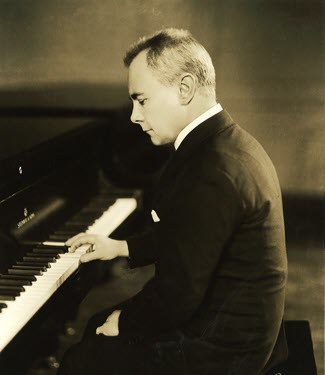
Josef Hofmann was born in Podgorze, Poland on January 20, 1876. Instructed solely by his father until the age of 10, Hofmann began performing at the age of six. His touring years began then as well, leading him through major European cities with great success and frequent comparisons to a young Mozart. Hofmann's main teachers were Moritz Moszkowski and Anton Rubinstein. In 1887, Hofmann made his first appearences in the U.S. Hofmann then settled in this country and became the first Director of the newly opened Curtis Institute of Music in Philadelphia. Hofmann wrote primarily for the piano, but also composed for the piano and orchestra. Hofmann died in Los Angeles on February 16, 1957. Hofmann's recorded legacy is available on compact discs issued by VAI Audio and by Marston Records. IPAM currently holds a representative selection of Hofmann materials and documents.
SERIES DESCRIPTION
Series I - Concert Materials
Series II - Correspondence
Series III - Photographs
Series IV - Scores
- Works by Hofmann
- Works by Other Composers
Series V - Books/Miscellaneous Memorabilia
Jan Holcman Collection
Jan Holcman (pronounced HOLTZ-man) was born in Lodz, Poland in 1922. His piano studies at the Lodz Conservatory were brutally interrupted by the German invasion of Poland in September 1939. He narrowly escaped from the Nazis (who, he later discovered, had executed his family) and made his way to Moscow, where he was accepted at the conservatory and spent a year studying with Grigory Ginsburg. He also began researching the many recordings of pianists that he found in the conservatory's library.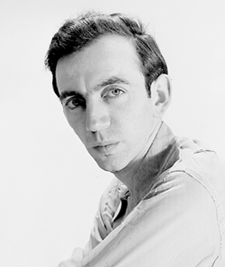
The havoc of World War II, however, forced Holcman to move to Tashkent where he endured a period of privation and uncertainty. He then attached himself to General Anders's Polish Army and eventually arrived in Palestine, where he taught and performed until 1947. At that point Holcman emigrated to the United States and enrolled in the diploma program of the Juilliard School. He then began to focus on private teaching and on research into the elements of piano technique and interpretation, especially as revealed on rare recordings by pianists of an earlier era. His first book, "The Legacy of Chopin", was published in 1954. Holcman's articles about many pianistic topics began appearing in various periodicals, notably Saturday Review and Musical Courier.
During this period, Holcman built an elaborate sound system designed to examine and compare recorded piano performances down to the most minute detail. Some of the results of his investigations appeared in his published survey of Soviet vs. Western pianists and in his critical explorations of nearly all existing recordings of Chopin, Liszt, and Debussy. In April 1963, Holcman, plagued with fragile health and the residue of his wartime experiences, either jumped or fell (accounts differ) from the window of his fifth-floor New York studio.
In 2000 IPAM published a collection of 30 of Holcman's essays on pianists and their recordings. Edited by IPAM curator Donald Manildi with extensive supplementary material, this critically-acclaimed 255-page paperback volume, "Pianists: On and Off the Record", is available directly from IPAM.
IPAM's Holcman Collection includes many of the rare recordings and scores that Holcman used in his research, as well as initial drafts of his articles, an extensive body of correspondence with fellow collector/discographer Harry L. Anderson, and files containing notes and unpublished material.
In 2021, the Holcman Collection was significantly augmented by a donation from Dahlan Foah and the family of Vivana Brodey. It contains extensive correspondence, numerous photographs, and other materials.
Barbara Holmquest Collection
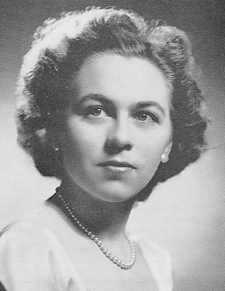
Barbara Holmquest, a native of Brooklyn, New York, began her studies at the Institute of Musical Art in New York City. Her principal teachers were Lonny Epstein and Carl Friedberg. Holmquest was the recipient of numerous awards, including a fellowship in the Juilliard Graduate School. This led to a career as a performer throughout the U.S. Holmquest was also known as a strong supporter of educational broadcasting, presenting recitals and commentaries for the University of Michigan Broadcasting Service. Recordings by Barbara Holmquest have been issued on the Oryx label. Barbara Holmquest died on July 24, 2010. She is represented in IPAM by recordings of her concert performances as well as materials relating to her studies with Friedberg and her teaching activity.
Mieczyslaw Horszowski Collection
Mieczyslaw Horszowski was born in Lvov, Poland on June 23, 1892, and received his first piano lessons from his mother, a student of Karol Mikuli, who had been a pupil of Chopin. He went on to study in Vienna with Theodor Leschetizky, who was a pupil of Beethoven's protege Carl Czerny and the most important piano teacher next to Franz Liszt. In 1905, the young pianist played for Gabriel Faure and met Camille Saint-Saens in Nice. The following year, he met Arturo Toscanini and Pablo Casals, both of whom later became close musical associated and personal friends.
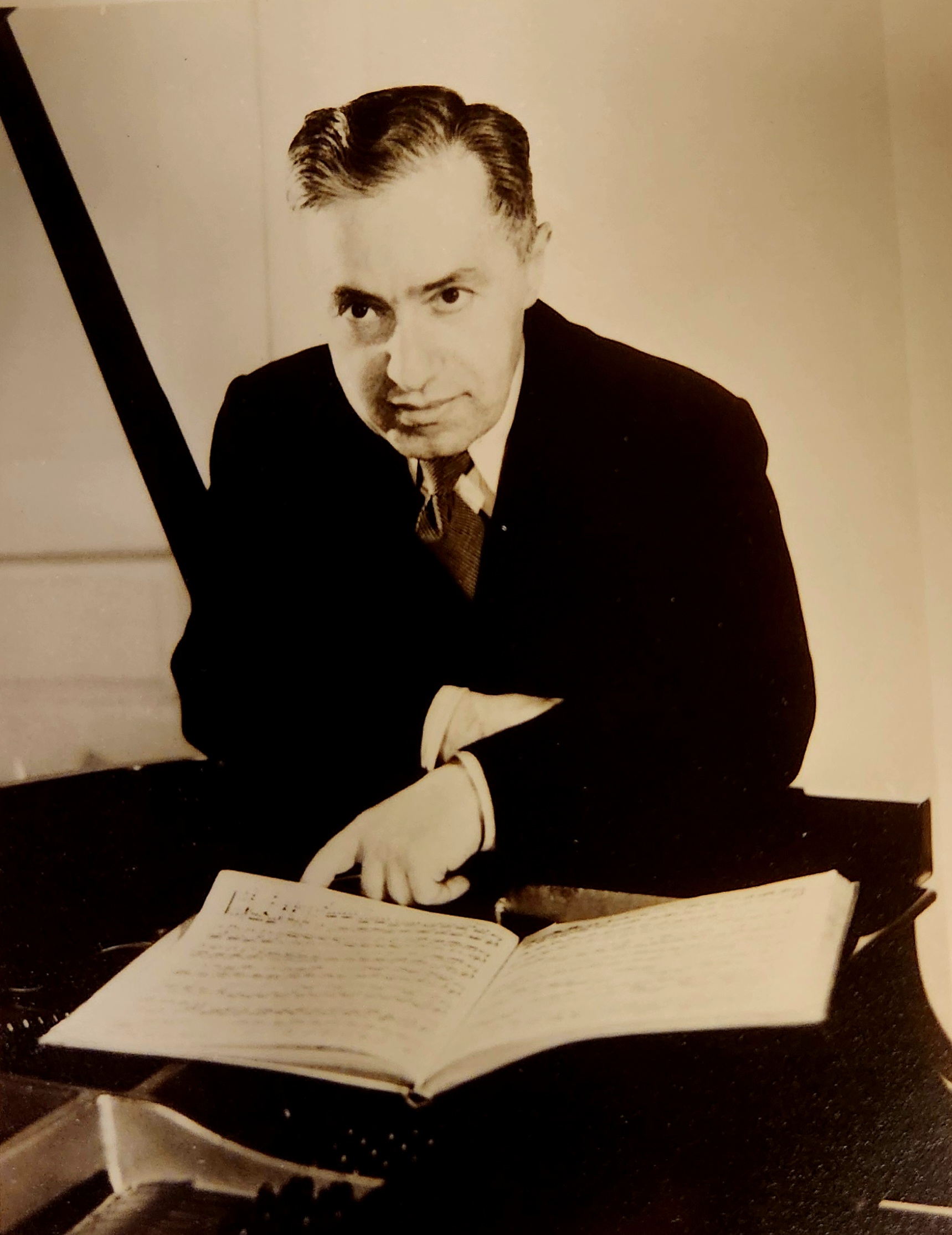
Horszowski began concertizing throughout Europe in 1900 as an eight-year-old prodigy. At 10, he gave his first recital in Vienna. Within five years he was touring North and South America. In 1911, Horszowski interrupted his career to devote himself to the study of literature, philosophy, and the history of art at the Sorbonne in Paris. Upon Casals' insistence, he returned to the concert stage and, after World War I, settled in Milan. At the outbreak of World War II, he was on a tour of Brazil; rather than returning to Europe, he came to the United States, in which he made his home until his death.
Though he initially established his reputation as a young soloist, Horszowski subsequently devoted much of his adult career to chamber music. His longstanding collaboration with Casals is well known, and he took a major role in many of the prestigious chamber music festivals around the world, such as the Prades Festival, Casals Festival, Marlboro Festival, etc. Among the many famous musicians with whom he collaborated were Joseph Szigeti, Alexander Schneider, Walter Trampler, and the Budapest Quartet.
Other highlights of his performing career include appearances with Arturo Toscanini and the NBC Symphony; a cycle of Beethoven's entire solo piano works, presented in twelve New York recitals in 1957; a similar cycle, also in New York, of all of Mozart's piano sonatas in 1960; and a series of ten Mozart concertos two years later at the Metropolitan Museum of Art in New York. He performed at the White House for Presidents Kennedy and Carter, and participated in a unique concert at the American Museum-Hayden Planetarium commemorating the 500th anniversary of the birth of the great Polish astronomer, Nicholas Copernicus. He also recorded for the first time in history on the earliest surviving piano--an instrument built in 1720 by its inventor, Bartolomeo Cristofori. On this occasion Horszowski played sonatas by D. Ludovico Giustini di Pistoia, which were commissioned by Cristofori and are the first known compositions written for the pianoforte. Contemporary music also occupied a part of his repertory. He performed works by Honegger, d'Indy, Martinu, Villa-Lobos, Stravinsky, Szymanowski, and Joonas Kokkonen.
Horszowski made numerous recordings, beginning with his mid-1930s HMV discs with Casals, and continuing with solo, chamber, and concerto releases for Columbia/CBS/Sony, Mercury, Vox, RCA Victor, Vanguard, Deutsche Grammophon, and Nonesuch. Many are now available on compact disc, and newly-discovered live Horszowski performances have continued to appear after his death.
As a link between the great musicians of the past and the young artists of the future, Horszowski provided an inestimable contribution to the world of music through his teaching, as well as through his performing and recording. For many years, he was a distinguished faculty member at the Curtis Institute of Music in Philadelphia. Among his more famous students are Seymour Lipkin, Anton Kuerti, Peter Serkin, Murray Perahia, and Richard Goode. Horsowski died in Philadelphia on May 22, 1993, at the age of 100.
SERIES DESCRIPTION
The collection is arranged into five series:
Series l(a) - Performance Files
Includes programs, reviews, advertisements, promotional materials and like documents that are related to specific performances of Horszowski. The materials are organized chronologically by performance date, and span the period 1898 through 1991. This series is located in boxes 1 through 9. Additional materials are found in the Series l(b); Festival Files.
Series l(b) - Festival Files
Horszowski maintained lifelong associations with some of the well-known summer music festivals. Boxes 10 to 13 contain materials related to each of these festivals. They are;
Prades Festival in Prades, France Casals Festival in San Juan, Puerto Rico Marlboro Festival in Marlboro, VT, and International Festival of Music in Lucerne, Switzerland.
Each of these is organized into Performance Files (programs, reviews, advertisements, promotional materials, etc.), Subject Files (articles, correspondence, schedules, contracts, etc.), and other categories if applicable.
Series II - Recording Activity
Includes royalty statements, contracts, correspondence regarding recordings, and reviews of commercial sound recordings made by Horszowski. The materials are organized alphabetically by recording company and are located in boxes 14 and 15.
Series III - Colbert Management
This series contains materials related to Colbert Artists Management, Inc. which was Horszowski's agent in US. Materials such as contracts, lists of engagements, itineraries, statements, publicity materials, correspondence, & etc. are listed chronologically and found in box 16.
Series IV - Correspondence
All of the letters here - boxes 17 to 19 - are incoming correspondence, including the ones written to/via Mrs. Horszowski or Colbert Management and their agents. Often Horszowski's replies are jotted down on blank space or on a small piece of paper and attached. This series is divided into three categories according to the contents of each item: Foreign Business Correspondence and Other Papers, Domestic Business Correspondence, and Personal Correspondence.
Series V - Subject Files
Contains files relating to Horszowski as an adjudicator (documents related to competitions at which Horszowski participated in some way, as a jurist, as a member of board, etc., listed in chronological order), magazine & newspaper articles (newspaper and magazine articles about Horszowski, about other people such as Casals, and other general clippings), and other documents (biographical materials, Horszowski memorials, photographs, master classes, recommendations, oversized materials, etc.).
Stanley Hummel Collection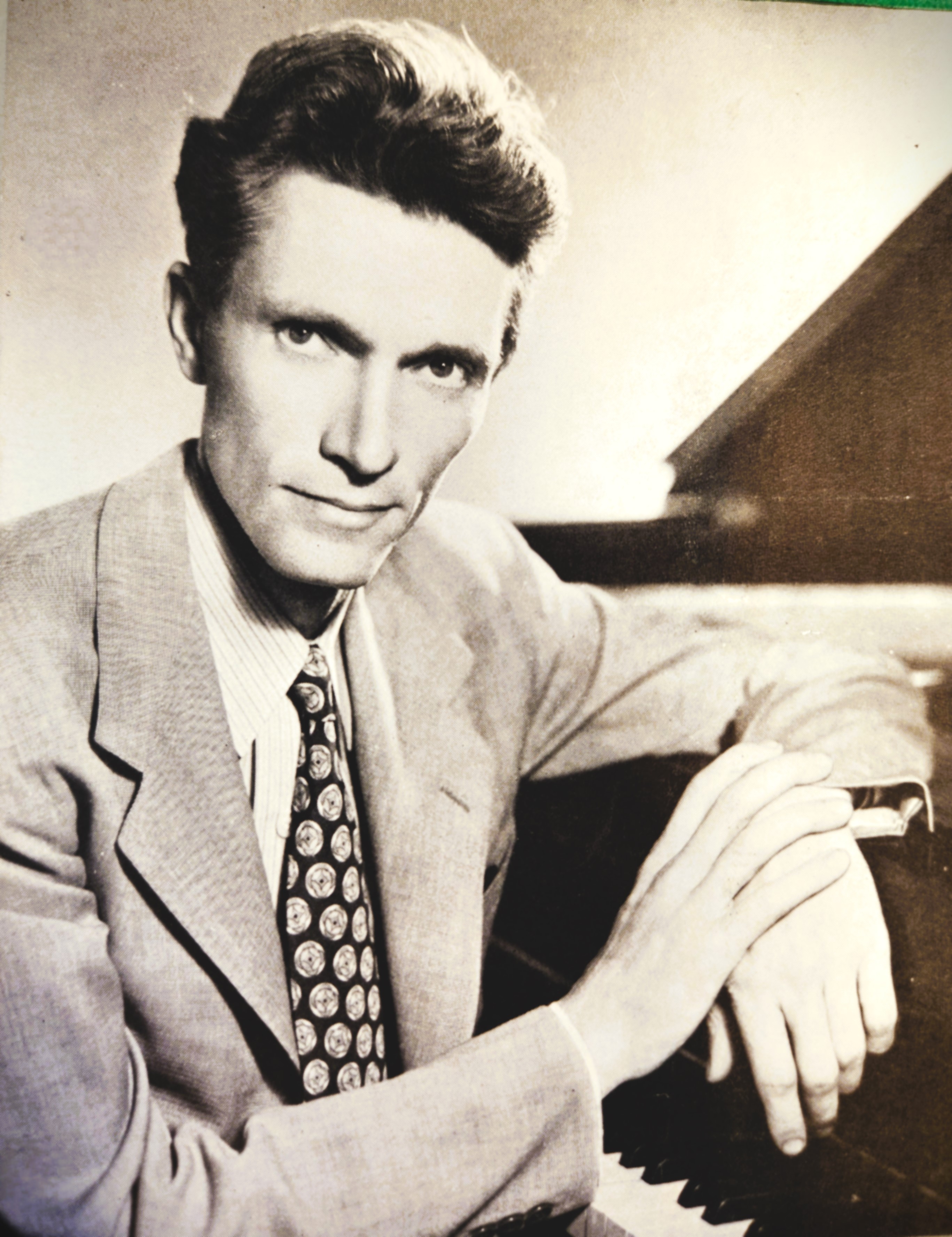
Stanley Hummel (1908-2005) was an acclaimed pianist and teacher, central to the musical arts scene in Albany, New York for over 70 years. Hummel began his career in a piano-violin duo with his brother, Earle, who went on to become the concert master of the Metropolitan Opera Orchestra and the Schenectady Symphony. Photograph of Stanley Hummel. The brothers toured upstate New York when Hummel was only 17, and began performing weekly radio broadcasts for WGY. Following this success, Hummel’s piano teacher, Edward Morris, encouraged Hummel to play for Josef Lhevinne. Lhevinne, impressed, arranged for Hummel to join him for lessons and concerts in Salzburg that summer.
The following fall, Lhevinne and his wife, Rosina, established a place at Juilliard for Hummel to continue his studies. Hummel’s daughter, Gail, stated that her father met Rachmaninoff during his time at Juilliard, and was invited by the composer to perform his Piano Concerto no. 3. Hummel continued to perform regularly throughout his career, mainly at New York venues such as Carnegie Hall, Town Hall, the Saratoga Performing Arts Center, and the Albany Institute of History and Art. He made several international tours as well. Hummel was also a dedicated teacher; his daughter remembers him teaching as many as 90 students per week, and he continued teaching into his 90s. Hummel died in California, at the age of 97.
SERIES DESCRIPTION
The Stanley Hummel collection at IPAM contains approximately 110 reel tapes of Hummel’s live performances.
The Australian pianist Bruce Hungerford was born in Korumburra, Victoria, November 24, 1922. He received his initial education in Melbourne, and later studied piano with Ignaz Friedman in Sydney in 1944. During the same year, Hungerford insisted on playing for conductor Eugene Ormandy, while Ormandy was on a tour in Melbourne.
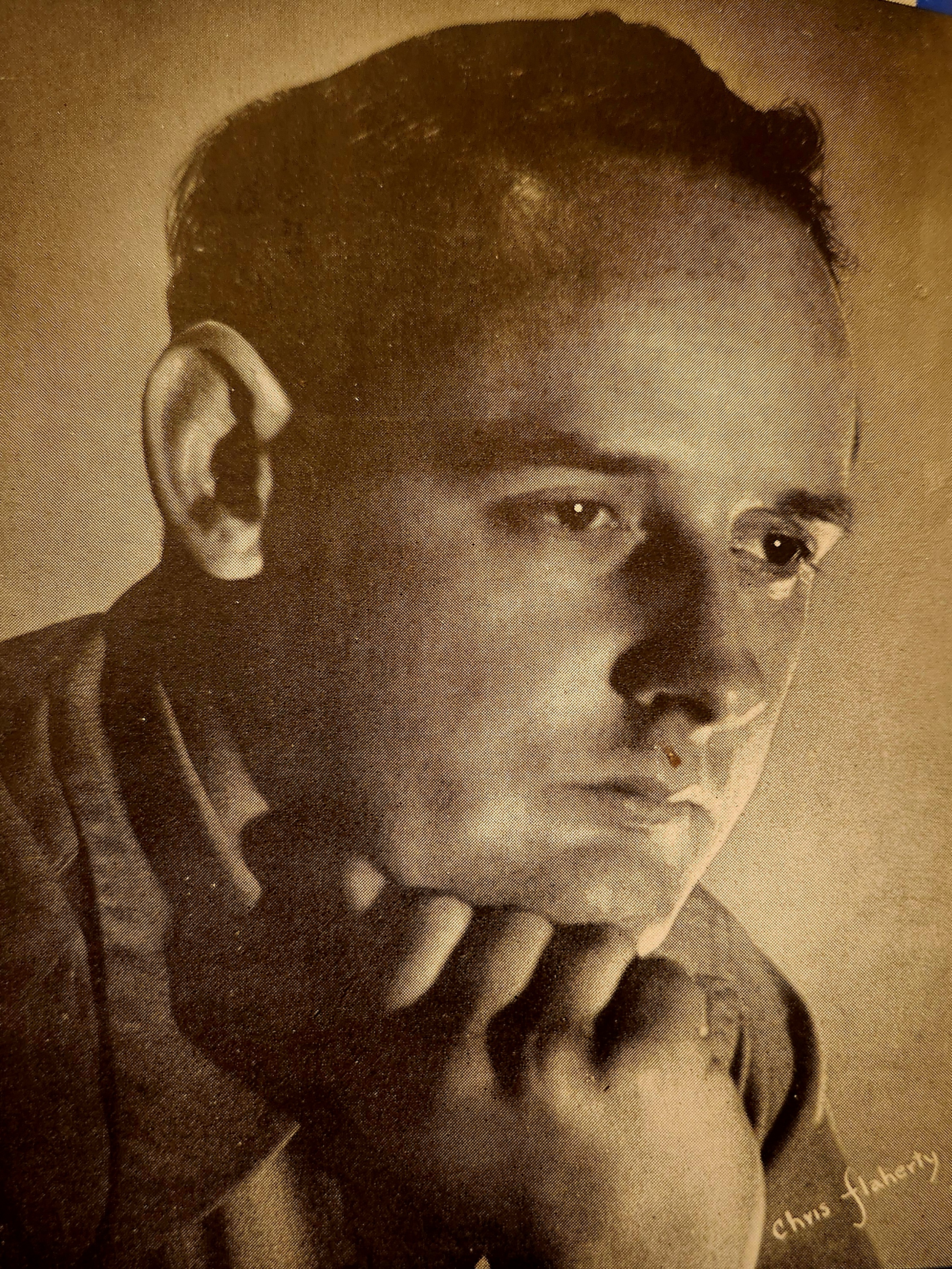
Ormandy eventually arranged for Hungerford to go to America in 1945 and study with Ernest Hutcheson at the Juilliard School of Music in New York. After two years, Hungerford felt that he needed to move on and again sought Ormandy's advice. He suggested going to see Olga Samaroff, who offered to take Hungerford on as a student in Philadelphia. In October of 1947, Hungerford moved to Philadelphia and began working with Samaroff, but continued to look for a mentor. Hungerford was deeply disappointed with his lessons with Samaroff, and approached Dame Myra Hess early in 1948 for advice. He received coaching and lessons from Hess during each of her visits to the United States and maintained a close personal relationship with her until her death in 1965. It was Hess who suggested that Hungerford study with Carl Friedberg, and she recommended Hungerford as a student. This began a long and fruitful relationship that lasted until Friedberg's death. Hungerford studied intermittently with Friedberg for about eighteen months and was then selected in the Fall of 1950 as the recipient of the first annual Carl Friedberg Alumni Association Scholarship, providing him with tuition for 25 lessons with Friedberg. At the first scholarship lesson Friedberg "talked for quite a while first and said that he had given me this scholarship as he is convinced I have the goods. I am no longer a student but a master, and I am to converse with him now with that understanding."
In 1947 Olga Samaroff suggested that Hungerford either try to establish himself in Europe as a concert pianist or move back to Australia and become a piano teacher. Although Hungerford continued to perform in the United States for the next ten years, he felt that he needed to conquer Europe in order to launch a major career, so he moved to Germany in 1958 and began concertizing all over the continent.
In 1958 Hungerford changed his name from Leonard to Bruce and described this decision in an unpublished, undated three-page manuscript, apparently the beginning of a memoir which was never finished: "When it came to naming me my parents were tom between 'Bruce' and 'Leonard.' I think they really wanted Bruce, but I was such a puny specimen that they hardly felt I fitted the name of the Warrior King of Scotland. Then a day or two before I was to be christened, my grandfather journeyed down to see me. He was a Scotsman to the backbone and after taking one look at me said sadly, "This is no 'Bruce', and so the die was cast, at any rate for my first 35 years." Thus, Hungerford was christened 'Leonard', and he used that first name until 1958 when, on the eve of his first concert tour of Europe, he formally changed it to "Bruce" for reasons both personal and professional.
Building on a childhood interest in nature and natural history, Hungerford studied vertebrate paleontology at Columbia University and at the Museum of Natural History in New York in the 1950s and achieved a level of expertise sufficient to gain him admission into some of the inner circles of working paleontologists. One of his favorite pastimes was digging for dinosaur footprints in the Connecticut River valley. The results of his labors were displayed in his home,. which was dubbed "Dinosaur Haven" by his friends. Hungerford combined interests in archaeology and ancient Egypt with his highly refined skills as a photographer to forge a career, pursued simultaneously with his career in music, as an Egyptologist. Hungerford made six research trips to Egypt during his lifetime, the first in 1961 as still photographer on the NBC River Nile Expedition and the others under the auspices of the American Research Center in Egypt and the American University in Cairo. He lectured frequently on Egypt, sometimes combining lecture tours with his concert tours. In 1971 he wrote and recorded "The Heritage of Ancient Egypt," a 17-part audio-visual series illustrated with 1200 of his own color transparencies, which was sold to museums and universities across the United States.
In 1967 Maynard and Seymour Solomon, the founders and directors of the Vanguard Recording Society, signed Hungerford to record all of the piano works of Beethoven. Hungerford moved from Germany to the United States, maintained a reduced concert schedule and joined the faculty of the Mannes College of Music.
Hungerford was killed in an automobile accident January 26, 1977 in New York City at the age of 54. He left a legacy of nine all-Beethoven records and one record each of works by Brahms, Chopin, and Schubert on the Vanguard label.
SERIES DESCRIPTION
Series I: Correspondence
This series contains approximately 950 letters, and comprises the bulk of the Bruce Hungerford Collection. The letters are divided into four groups: FAML, LIPT, MISC, and PROF. The FAML letters are those written by Hungerford to his family (mother, father, sister Paulina, and niece Katrina). The LIPT letters consist of correspondence between Hungerford and his friend Thomas Lipton and wife Sylvia. There are a small number of MISC letters which contain correspondence of a miscellaneous nature. Finally, the PROF letters concern correspondence between Hungerford and professional musicians. Most of these letters comprise correspondence with Dame Myra Hess. The PROF letters are in box 11 and have been retained in the notebook in which they were donated.
Series II: Recordings
Here are found a large number of reel-to-reel tapes of Hungerford recordings. The 100 series contains recordings on small reels, the 200 series contains copies of the Vanguard Masters, and the 300 series contains recordings found on large reels. Following the numerical inventory of the tapes, there is a listing of the tapes by composer. This series also contains an inventory of Hungerford's LP and acetate recordings found in the collection. As with the tape inventory, this inventory is followed by a composer listing of all of Hungerford's LP and acetate recordings.
Series III: Scrapbooks
The performance files of the Bruce Hungerford Collection are found in the carefully prepared scrapbooks of the Hungerford family. The eleven scrapbooks contain reviews of concerts and recordings, programs, publicity brochures, photographs, articles about Hungerford's interest in paleontology, archaeology, and Egyptology, human interest stories about Hungerford, obituaries of famous musicians, articles about famous pianists and conductors, and a number of other miscellaneous items. This series comprises a general inventory of the scrapbooks as they were presented to the International Piano Archives at Maryland.
Series IV: Hungerford's lessons with Carl Friedberg
On July 18, 1948, Hungerford wrote to his mother that a day earlier he had just begun lessons with Carl Friedberg. It was Dame Myra Hess who suggested that Hungerford study with Friedberg and she was the catalyst for their first telephone call. After taking infrequent
lessons with Friedberg for about eighteen months, Hungerford was selected in the Fall of 1950 as the recipient of the first annual Carl Friedberg Alumni Association scholarship, which provided him with tuition for 25 lessons with Friedberg. Some twenty hours of these lessons, covering a wide range of music but focusing largely on the great piano works of Beethoven and Brahms, were recorded on tape by Hungerford.
Series V: Artwork
Includes pencil and/or ink drawings by Hungerford of famous musicians, a self-portrait, several portraits of non-musicians, animals, dinosaurs, Walt Disney characters, Egyptian subjects, and architecture. Many of the drawings are autographed, and some include inscriptions. The artwork dates from 1935-1945.
Series VI: Bruce Hungerford's Death
Contains newspaper articles reporting Hungerford's death, as well as obituaries.
Series VII: Miscellaneous
Includes miscellaneous articles, press releases, postcards, writings by Hungerford, etc.
William Kapell Collection
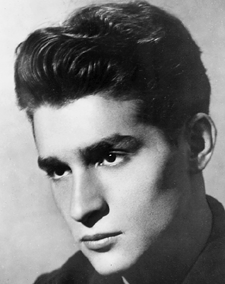 William Kapell was a brilliant American pianist whose life and career were cut short by the crash of an airplane on which he was returning from an overseas tour in October 1953. He was barely 31, but was already acknowledged as the leading American pianist of his generation; some have said he would have been the greatest pianist of the 20th century.
William Kapell was a brilliant American pianist whose life and career were cut short by the crash of an airplane on which he was returning from an overseas tour in October 1953. He was barely 31, but was already acknowledged as the leading American pianist of his generation; some have said he would have been the greatest pianist of the 20th century.
Born in 1922, Kapell studied piano with Dorothea Anderson LaFollette at the Yorkville Settlement School in New York and with Olga Samaroff at the Philadelphia Conservatory and, later, at the Juilliard School. In 1941, he won both a Naumburg Award and the Philadelphia Orchestra Youth Concert competition. This gave him opportunities for major debuts both as a recitalist and as a player of concerti. In 1942, he was given the Town Hall Endowment Series Award, providing him with yet another Town Hall recital during the 1942-43 season. He then signed a contract with RCA Victor and recorded a wide variety of repertoire for that company. (All of Kapell's RCA recordings have been reissued in compact disc format.)
He toured North America annually thereafter, performing both with major orchestras and as a recitalist. He became an advocate of contemporary American piano music, and seems to have been especially prized by American composers. In 1945, he played a series of concerts in Australia, beginning to build an international reputation. He toured South America three times (1946, 1948, and 1951). He seemed to have a particular affection for music of South America that is reflected in his personal collection of piano music. He first played in Europe in 1947. In mid-1953 he performed in Tel Aviv, played at Casals's Prades Festival, and gave his final series of performances during the course of a three-month Australian tour. Returning from Australia, his plane crashed into a mountain moments before its scheduled landing in San Francisco.
Elisabeth Katzenellenbogen Collection
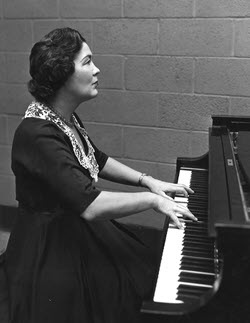 Elisabeth Katzenellenbogen was born in Zurich, Switzerland, where she studied at the Zurich Conservatory. Her post-graduate studies were with Robert Casadesus in Paris and Robert Teichmüller in Leipzig. A successful European concert career was interrupted by the outbreak of World War II. She emigrated to the United States in 1941 and would go on to hold teaching positions at Vassar College, Goucher College, and the Peabody Conservatory of Music. Katzenellenbogen was a lifetime advocate of the music of C.P.E. Bach. She regularly programmed entire recitals of C.P.E. Bach’s music and recorded The Six Essay Sonatas for Lyrichord records.
Elisabeth Katzenellenbogen was born in Zurich, Switzerland, where she studied at the Zurich Conservatory. Her post-graduate studies were with Robert Casadesus in Paris and Robert Teichmüller in Leipzig. A successful European concert career was interrupted by the outbreak of World War II. She emigrated to the United States in 1941 and would go on to hold teaching positions at Vassar College, Goucher College, and the Peabody Conservatory of Music. Katzenellenbogen was a lifetime advocate of the music of C.P.E. Bach. She regularly programmed entire recitals of C.P.E. Bach’s music and recorded The Six Essay Sonatas for Lyrichord records.
The Katzenellebogen Collection consists of concert programs, and a large number of recordings of concert and studio performances of works by C.P.E. Bach, W.F. Bach, Mozart, Haydn, and 20th century composers such as Bartók, Fortner, Berg and Krenek.
Constance Keene Collection
The distinguished American pianist and teacher Constance Keene was born in Brooklyn, New York on February 9, 1921. Her early piano studies were with Kathryn Makin. At the age of 13, three years after her formal recital debut, she began working with Abram Chasins (1903-1987), the well-known pianist, composer and broadcaster, whose influence on the young pianist was decisive. Through Chasins's influence, Constance played privately for, and received encouragement from, such eminent figures of the day as Leopold Godowsky and Josef Hofmann. In 1943 she was named winner of the Naumberg Competition, appearing in her Town Hall debut recital later that year.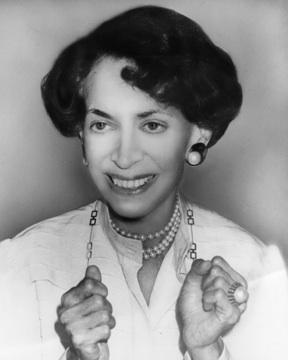
Chasins and Keene were married in 1949 and made a number of acclaimed recordings of duo-piano repertoire as well as performing together with the Boston Symphony under Serge Koussevitzky. On her own, Ms. Keene appeared as concerto soloist with major orchestras in the US and Europe, including the Philadelphia Orchestra, Chicago Symphony, New York Philharmonic, the Hallé Orchestra of Manchester, and the Berlin Philharmonic.
In 1946, Constance Keene replaced the indisposed Vladimir Horowitz at a recital before an audience of 4000 in Springfield, MA. She became the only woman pianist to have substituted for Horowitz at any of his frequent cancellations. In addition to her concert activity during the 1940s, Ms. Keene embarked on a second career as a teacher. Among her private pupils at the time were the two older children of Artur Rubinstein. In 1963, shortly after Ms. Keene's recording of the complete Rachmaninoff Preludes was released, Rubinstein warmly praised her interpretations: "I cannot imagine anybody, including Rachmaninoff himself, playing [the Preludes] as beautifully."
In 1969 Constance Keene joined the faculty of the Manhattan School of Music, eventually serving as chair of the school's piano department and becoming one of New York's most sought-after teachers. In 1997 she was named to the school's board of trustees, and in 2004 the MSM awarded her an honorary Doctor of Musical Arts degree. Ms. Keene gave master classes on many occasions in Europe, Asia and South Africa. In addition, she was in frequent demand as a judge for piano competitions, serving on the juries of the Cliburn and Naumberg competitions, among others.
Constance Keene was a fairly prolific recording artist whose first solo discs appeared on the Mercury label in the early 1950s. A number of compact discs on the Protone and Newport labels reflect the breadth of her repertoire, containing not only familiar works of Bach, Chopin, Mendelssohn and Rachmaninoff, but also rarely-played sonatas by Dussek, Hummel, Weber, and MacDowell.
Constance Keene died in New York on December 24, 2005 and was survived by her second husband, the attorney Milton Kean.
The Constance Keene Collection in IPAM contains a number of scrapbooks documenting her career as both performer and teacher. IPAM also holds Ms. Keene's personal score collection containing many comments and notations.
Edward Kilenyi Collection
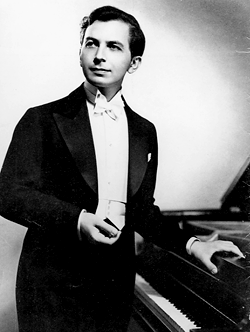
Edward Kilenyi was born in Philadelphia, PA. on May 7, 1910. By the age of four, Kilenyi was already displaying notable pianistic talents and soon travelled to Europe for more intensive instruction. He enrolled at the Franz Liszt Royal Hungarian Conservatory of Music at Budapest around 1922 and graduated in 1930. His principal teacher there was Ernst von Dohnanyi. Kilenyi's professional career began with a performance in Amsterdam with the Concertgebouw Orchestra in 1929. He made his debut in England in 1935 and then in the United States in 1940. Kilenyi proceeded to perform on several continents and made more than one hundred recordings (for Pathe, Columbia, and Remington) during his lifetime. Kilenyi went on to be a Professor of Music at Florida State University. He died on January 6, 2000.
IPAM's Kilenyi Collection consists mainly of live performance tapes of Kilenyi's recitals at Florida State University and elsewhere. A detailed inventory of these tapes is in preparation.
George Kochevitsky Collection
George Kochevitsky was trained in pre-Revolutionary Russia. Later, he was intermittently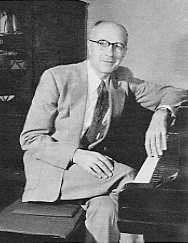 active in the USSR as a performer and teacher. He then made his way to the U.S., living in New York, where he continued his serious research into piano methodology, frequently contributing articles to various journals. His book, "The Art of Piano Playing: A Scientific Approach," was first published in 1967. Another publication, the 168-page "Performing Bach's Keyboard Music," was issued posthumously. It offered the results of Kochevitsky's extensive investigations into Baroque performance practices.
active in the USSR as a performer and teacher. He then made his way to the U.S., living in New York, where he continued his serious research into piano methodology, frequently contributing articles to various journals. His book, "The Art of Piano Playing: A Scientific Approach," was first published in 1967. Another publication, the 168-page "Performing Bach's Keyboard Music," was issued posthumously. It offered the results of Kochevitsky's extensive investigations into Baroque performance practices.
SERIES DESCRIPTION
Series I- Material Related to Physiology
Series II- Bibliographical References
Series III- Kochevitsky’s Writings
Series IV- Collected Book and Record Reviews
Series V- Collected Concert Programs and Fliers
Series VI- Correspondence
Series VII- Collected Published Material on Different Topics
Series VIII- Collected Articles/Reviews/Obituaries About Other Performers
Series IX- Miscellaneous Kochevitsky Materials
Series X- Collected Magazines
Series XI- Miscellaneous
Anne Koscielny Collection
Anne Koscielny was born in Tallahassee, FL on May 12, 1936. The daughter of a German violinist who emigrated to the United States in 1929, she began her studies at age six, working with W. James Crosland and then Hans Barth in Jacksonville, Florida, the latter being a student of Josef Lhévinne. At 17, she performed with the Jacksonville Symphony. Koscielny trained at the Eastman School of Music with Cecile Genhart for four years, also working in the summers with Frank Mannheimer. While still a student, Koscielny won the Kosciuszko Chopin Competition in 1957. After graduating in 1958, she won a Fulbright grant to study in Vienna with Władysław Kędra. Kędra prepared her for the 1960 Chopin competition, in which Koscielny was a semifinalist. While living in Europe, Koscielny performed in Poland, Austria, and Italy. 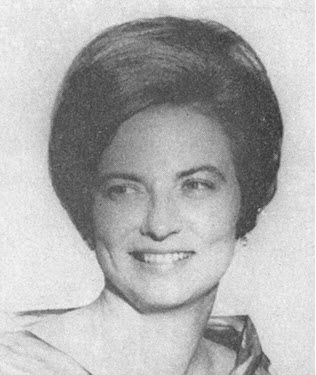
After a series of complicated family events, Koscielny decided to return to school for a graduate degree in order to later find a permanent teaching position. She was awarded a full-tuition scholarship to work with Robert Goldsand at the Manhattan School of Music and completed a master’s degree in one year. Her teaching responsibilities combined with marriage and family meant that her concert career remained primarily localized. She played throughout the state of Connecticut, and after a successful initial performance at the Matthay Festival at the University of Maryland in 1967, was repeatedly invited back to the Washington D.C. area. Koscielny occasionally performed abroad, in particular giving a successful recital at Wigmore Hall in London in 1972.
Koscielny held faculty positions at the Hartt School of Music, the University of Maryland College Park, the Eastman School and the Peabody Institute. She maintained a repertoire that embraced the range of the piano literature, which she played with a high degree of technical command. Koscielny had a particular affinity for the Beethoven Piano Sonatas, presenting the entire cycle of Sonatas at various times in her career. Koscielny died in 2015.
The Anne Koscielny Collection consists of a large number of recordings, with an emphasis on her Beethoven performances. These recordings are made up of unissued studio recordings along with live performances and span much of Koscielny’s performing career. Koscielny’s papers documenting her performing and teaching career are expected to be added to the collection at a later date.
Louise Kupelian Collection
Louise Kupelian, a graduate of Philadelphia Conservatory of Music, studied for three years with Madame Olga Samaroff-Stokowski. She also studied harmony and counterpoint under Vincent Persichetti and later attended the Cleveland Institute of Music, where she studied piano with Leonard Shure and continued her work in composition with Herbert Elwell. Kupelian furthered her graduate studies at Columbia University in New York, where she specialized in piano pedagogy under Robert Pace.
Kupelian concertized widely in the East and Midwest, both as a soloist and as a member of a two-piano team, and was a performing artist member of the Friday Morning Music Club and the Arts Club of Washington, D.C. for many years.
A member of the Washington Music Teachers' Association and the Maryland State Music Teachers' Association, Kupelian was certified in 1987 as a Master Teacher - the highest award given by the Music Teachers' National Association to its members. As a member of the Honor Society of Phi Kappa Phi and a consultant for the International Piano Teaching Foundation, she presented numerous pedagogy and master classes for piano teachers in the Washington, D.C. area.
Kupelian pursued an intensive study of jazz improvisation at the University of Maryland graduate school, studying with Ron Elliston, and became a member of the International Association of Jazz Educators. She published in the field of jazz education ("What's So Great About Jazz?" - Keys Magazine, 1989), and her composition, "Theme and Variations on Happy Birthday," (Warner Bros. 1995) represents a marriage of classical and jazz styles. She enjoys the creative challenge which is at the heart of jazz, and her greatest joy is in teaching teachers the art of jazz.
The Kupelian Collection in IPAM contains documents relating to her own career, as well as memorabilia pertaining to her studies with Olga Samaroff, including highly detailed notebooks documenting lessons.
Louise Kupelian died on October 18, 2011 at age 89.
Ruth Laredo Collection
Ruth Meckler Laredo was born on November 20, 1937 in Detroit, Michigan. Following early piano studies with her mother, she continued her training with Rudolf Serkin at the Curtis Institute of Music in Philadelphia. Laredo graduated in 1960 with a Bachelor of Music degree. The same year she married Bolivian violinist Jaime Laredo. [The couple was divorced in 1974.] During the next several years both musicians made numerous joint appearances throughout the world.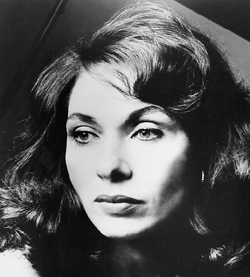
In 1962 Ruth Laredo made her debut in New York with the American Symphony Orchestra conducted by Leopold Stokowski. Since then she has played all over the United States with many orchestras including the National Symphony, Boston Symphony, Cleveland Orchestra and the Indianapolis Symphony. She has also played in many foreign countries, giving tours in Japan, Holland, and Germany, among others. Ruth Laredo has been a regular participant at the Marlboro Festival in Vermont, collaborating with numerous colleagues in virtually all major chamber works involving the piano.
Laredo has been particularly identified with the music of Sergei Rachmaninoff and Alexander Scriabin. She has recorded the complete solo piano works of Rachmaninoff for Columbia/CBS/Sony. As a result of these recordings, she was commissioned by C. F. Peters to edit an edition of the twenty four Rachmaninoff Preludes. She has also earned a reputation as a specialist in Scriabin, having recorded all ten of his sonatas (for Connoisseur Society) along with other smaller works, and including this music frequently on her recital programs. In addition, Ms. Laredo has made recordings of works by Ravel, Debussy, Barber, Chopin, Beethoven, Tchaikovsky and many other composers.
Laredo won several awards throughout her career including a Grammy nomination, and was chosen as one of five pianists to perform at Carnegie Hall for its 90th anniversary celebration.
Laredo died on May 25, 2005.
SERIES DESCRIPTION
Series I - Performance Files
Here are found programs, reviews, advertisements, promotional materials and like documents that are related to specific performances of Ruth Laredo. The materials are organized chronologically by date, and span the period 1960 through 1990. This series is located in boxes 1 through 10.
Series II - Recording Files
Here are found reviews, advertisements and promotional materials that are related to commercial sound recordings made by Ms. Laredo. The materials are organized alphabetically by composer and are located in box 1 I.
Series III - Correspondence
This series consists of 119 items and is divided into three categories:
- correspondence to Ms. Laredo
- outgoing correspondence from Ms. Laredo
- miscellaneous correspondence
This series is located in box 12.
Series IV - Subject Files
Here are found various documents that have been divided into the following subseries:
- Subseries 1: Festivals
- Subseries 2: Radio and Television
- Subseries 3: Laredo's Professional Activity
- Subseries 4: Laredo's Writings
- Subseries 5: Laredo's Academic Affiliations
- Subseries 6: Unrelated Articles
This series is located in boxes 13 through 16.
Ethel Leginska Collection
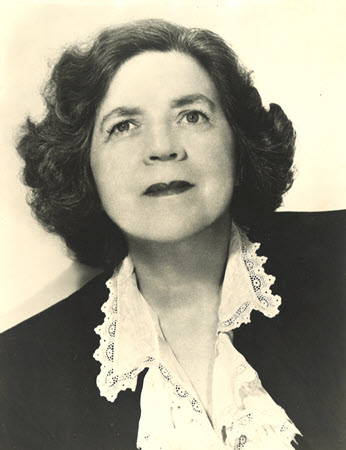 Ethel Leginska (Ethel Liggins) was born in Hull, Yorkshire, England on April 13th, 1886. Her early performances as a child prodigy garnered attention and lead to her being sponsored to study at the Hoch Conservatory of Music in Frankfurt, Germany. Her subsequent piano studies were with Leschetizky in Vienna. In keeping with other artists of her time who adopted Russian or Polish sounding names to advance their careers, she adopted the name Leginska. After her studies, her concert activities took her throughout Europe, and then to the United States, where she made her New York debut in 1913. Her many recital appearances over the next decade included numerous appearances at Carnegie and Aeolian Halls where she presented an eclectic repertoire. After studies in music theory and composition with Rubin Goldmark and Ernest Bloch, she composed chamber and orchestral works in the 1920s and 1930s that were performed by leading chamber and symphonic ensembles at a time when works by female composers were rarely performed. Her trailblazing career as a conductor began with a debut with the New York Symphony Orchestra in 1925, followed by engagements as a guest conductor with many of the world’s most important orchestras. In addition to her engagements conducting symphonic repertoire, she was the first female conductor to establish a significant career conducting opera. Her career as a teacher began in New York City and continued after she moved to Los Angeles in 1939, where she established an important piano studio. Her students were presented in recital series that encompassed the major works of the piano repertoire, such as the complete Well-Tempered Clavier of Bach, the 32 Beethoven Sonatas, and the complete works of Chopin. Ethel Leginska died in Los Angeles on February 20th, 1970.
Ethel Leginska (Ethel Liggins) was born in Hull, Yorkshire, England on April 13th, 1886. Her early performances as a child prodigy garnered attention and lead to her being sponsored to study at the Hoch Conservatory of Music in Frankfurt, Germany. Her subsequent piano studies were with Leschetizky in Vienna. In keeping with other artists of her time who adopted Russian or Polish sounding names to advance their careers, she adopted the name Leginska. After her studies, her concert activities took her throughout Europe, and then to the United States, where she made her New York debut in 1913. Her many recital appearances over the next decade included numerous appearances at Carnegie and Aeolian Halls where she presented an eclectic repertoire. After studies in music theory and composition with Rubin Goldmark and Ernest Bloch, she composed chamber and orchestral works in the 1920s and 1930s that were performed by leading chamber and symphonic ensembles at a time when works by female composers were rarely performed. Her trailblazing career as a conductor began with a debut with the New York Symphony Orchestra in 1925, followed by engagements as a guest conductor with many of the world’s most important orchestras. In addition to her engagements conducting symphonic repertoire, she was the first female conductor to establish a significant career conducting opera. Her career as a teacher began in New York City and continued after she moved to Los Angeles in 1939, where she established an important piano studio. Her students were presented in recital series that encompassed the major works of the piano repertoire, such as the complete Well-Tempered Clavier of Bach, the 32 Beethoven Sonatas, and the complete works of Chopin. Ethel Leginska died in Los Angeles on February 20th, 1970.
The Leginska Collection is a gift of Barbara Hodges Warren and consists of photographs, articles, correspondence, and most significantly, scrapbook materials documenting her career as pianist and conductor. A large amount of scrapbook material also features publicity for Leginska’s pupils.
Theodore Lettvin Collection
Theodore Lettvin was born in Chicago on October 29, 1926. From 1930 to 1935 he studied piano with Howard Wells in Chicago, and he continued his studies with Leon Rosenbloom from 1935 to 1941. Lettvin made his debut as soloist with the Chicago Symphony Orchestra on March 15, 1939. Frederick Stock, who conducted the concert, forecast a notable future for the boy. At the age of fifteen, the young pianist won a scholarship to the Curtis Institute in Philadelphia, where for the next seven years he studied with Rudolf Serkin and Mieczyslaw Horszowski. His career was briefly interrupted for service with the United States Navy in 1945.
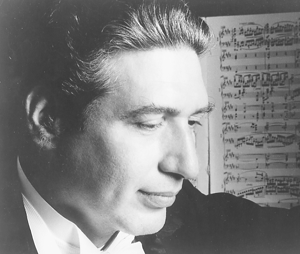 After resuming his career, Lettvin soon became recognized as one of the leading American pianists of his generation. He was the recipient of several prizes including the Naumberg Award in 1948, and the Michaels Award in 1950. While touring Europe and North Africa in 1952, he was called to Brussels to take part in the Queen Elisabeth of Belgium International Competition. There he gained international honor as a laureate (leading prizewinner).
After resuming his career, Lettvin soon became recognized as one of the leading American pianists of his generation. He was the recipient of several prizes including the Naumberg Award in 1948, and the Michaels Award in 1950. While touring Europe and North Africa in 1952, he was called to Brussels to take part in the Queen Elisabeth of Belgium International Competition. There he gained international honor as a laureate (leading prizewinner).
As a recitalist, Lettvin performed at London's Wigmore Hall, the National Gallery of Art in Washington DC, and New York's Town Hall. In addition to his recital tours, Lettvin also appeared regularly with the major orchestras of the United States. Among them are the New York Philharmonic and the orchestras of Cleveland, Chicago, Boston, Dallas, Cincinnati, Buffalo, Baltimore, Omaha, Seattle, New Orleans, Pittsburgh, Minneapolis, Saint Paul, and Atlanta. He appeared at the inauguration of the New York Philharmonic Promenades in the summer of 1964 with Andre Kostelanetz, who invited him to return the following season. He also appeared with the New York Philharmonic under William Steinberg, playing the American premiere of the Bartok Scherzo for Piano and Orchestra. On television he has been seen on The Voice of Firestone, the Chicago Theatre of the Air, with the Boston Symphony, and on educational TV. His recordings have been issued on the HMV and Columbia labels.
Lettvin held numerous positions as a teacher including visiting lecturer at the University of Colorado (1956-1957), head of the piano department at the Cleveland Music School Settlement (1956-1968), professor of piano at the New England Conservatory of Music (1968-1977), the University of Michigan (1977-1987), and Rutgers (from 1987). Lettvin's teaching activities included summer festivals at Marlboro, Tanglewood, Ravinia, Saratoga, and Salzburg.
Theodore Lettvin died on August 24, 2003. A detailed listing of Mr. Lettvin's private recordings held by IPAM will be supplied upon request. Please contact the curator.
Joseph Levine Collection
Joseph Levine, an American pianist and conductor (not to be confused with the Russian-born Josef Lhevinne--see below), studied at the Curtis Institute of Music in Philadelphia, PA., where he was a student of Josef Hofmann. At Curtis, he also studied conducting with Fritz Reiner and Arthur Rodzinski.
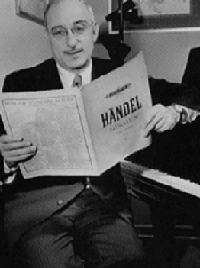 Besides playing numerous concerts and making recordings with violinist Joseph Szigeti, Levine spent many years as music director of New York's American Ballet Theatre. He recorded several significant ballet scores with the ABT Orchestra for Capitol Records. Later, he became music director of the Omaha Symphony and Omaha Opera, as well as the Bremerton (Washington) Symphony. He was appointed Associate Conductor of the Seattle Symphony, the Honolulu Symphony and the Hawaii Opera Theatre. In 1976, he joined the musical faculty of Cornish Institute of Allied Arts in Seattle. Levine also contributed many articles to music magazines describing various facets of his professional activity.
Besides playing numerous concerts and making recordings with violinist Joseph Szigeti, Levine spent many years as music director of New York's American Ballet Theatre. He recorded several significant ballet scores with the ABT Orchestra for Capitol Records. Later, he became music director of the Omaha Symphony and Omaha Opera, as well as the Bremerton (Washington) Symphony. He was appointed Associate Conductor of the Seattle Symphony, the Honolulu Symphony and the Hawaii Opera Theatre. In 1976, he joined the musical faculty of Cornish Institute of Allied Arts in Seattle. Levine also contributed many articles to music magazines describing various facets of his professional activity.
Levine's formative years coincided with the the preeminence of such "golden age" pianists as Hofmann, Rachmaninoff, Paderewski and Rosenthal. It was thus inevitable that the music-loving public occasionally mistook him for his near-namesake, the Russian-born virtuoso Josef Lhevinne. After several performances on the Curtis Institute's radio broadcasts, Levine heard from Hofmann in a letter -- now part of the IPAM collection -- applauding Levine's temporary decision to add the middle initial "S" to his name: "This will greatly please the other Josef Lhevinne because, as his wife (Rosina) told me, very often when you have played during our broadcasts, he has received letters of congratulations which, of course, greatly annoyed him. For the sake of identity, it is better for you, as well as for him, that you decided to alter your name slightly."
SERIES DESCRIPTION
Series I - Scores
Series II - Scrapbooks
- Photo Albums
Series III - Recordings
Ernst Levy Collection
Born in Basel, Switzerland on November 18, 1895, Ernst Levy's early training included studies with French virtuoso Raoul Pugno and with Egon Petri. Composer Hans Huber was also an important early influence. By 1916, Levy was teaching at the Basel Conservatory alongside Huber.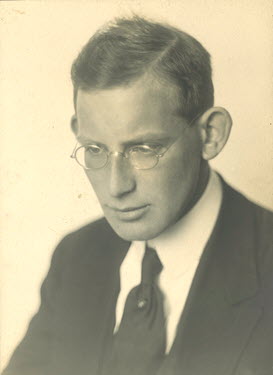
Four years later, Levy set up residence in Paris and, after spending some time as a pianist and teacher, he founded the Choeur Philharmonique in 1928. Among the works given their Paris permieres under Levy's direction were Brahms' "Ein Deutsches Requiem" and Liszt's oratorio "Christus." In 1935, Levy and Choeur Philharmonique recorded Liszt's "Missa Choralis" for the Polydor label, the first recording ever made of one of Liszt's sacred choral works.
Political conditions in Europe during the 1930s brought Levy, a Jew, to the U.S., where he held professorships at several major institutions, including the New England Conservatory, Bennington College, the University of Chicago, the Massachusetts Institute of Technology, and Brooklyn College. Levy's teaching of piano and composition, and his abilities as a choral and orchestral conductor, kept him fully occupied during his American years; this period also saw a remarkable output of works that ultimately embraced fifteen symphonies and an impressive quantity of chamber and choral music. It was during this time that Levy presented occasional recitals as pianist and made a series of recordings on the U.S. Unicorn label. Most of Levy's recordings are now available on compact discs issued by Marston Records. He retired from academia in 1966 and spent his remaining fifteen years in Switzerland.
As a composer, Levy's idiom was not identifiable with any school or tradition. He was a firm believer in the viability of tonality (as opposed to dodecaphony), and he constantly sought new vistas within the parameters of tonal music. He went so far as to study the writings of Pythagoras and the mathematical similarities between musical scales and star distances explored by Keppler. Levy measured the south tower of the Chartres cathedral to determine the relative proportions of the tower's architectural elements and published his findings on the subject as an appendix to the book, "The Gothic Cathedral: Origins of Gothic Architecture and the Medieval Concept of Order," by Otto Georg Von Simson in 1956. Levy concluded that the entire cathedral was a fully calculated, deliberate representation, "full of symbols, and full of musicality." Levy died in 1981.
SERIES DESCRIPTION
Series I - Concert Programs
Series II - Photographs
Series III - Correspondence
Series IV - Academic (Non-Musical)
Series V - Recordings
Raymond Lewenthal Collection
Raymond Lewenthal was born in San Antonio. Texas, of Russian-French parentage in 1923 (although some erroneous references to a birth year of 1926 can be found). After spending several years as a child movie actor in Hollywood, Lewenthal studied the piano there with Lydia Cherkassky, mother and teacher of the renowned pianist Shura Cherkassky. In 1945 he won all three of the major competitions then being held in California: The Young Artist Competition at UCLA (judged by Bruno Walter), the Young Artist Contest of Occidental College, and the Gainsborough Award in San Francisco. He continued his studies at Juilliard as a full scholarship student of Olga Samaroff-Stokowski. Later Lewenthal worked in Europe with Alfred Cortot and with Guido Agosti.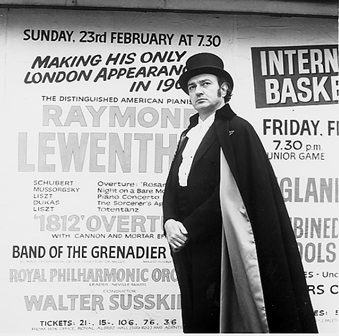
Lewenthal made his debut in 1948 with Dimitri Mitropoulos and the Philadelphia Orchestra. The occasion marked the first time a soloist had been invited to play the Prokofiev Third Concerto under Mitropoulos's direction, that being a work which the conductor was famous for playing himself. The success of this performance was followed a few weeks later by Lewenthal's New York recital debut. These events launched his North American career, which flourished until it came to a sudden halt in 1953; while walking through New York's Central Park, Lewenthal was attacked by a gang of hoodlums and suffered broken bones in his hands and arms. After a slow physical and psychological recovery, Lewenthal moved abroad and withdrew from the concert stage except for occasional touring and recording in Europe and South America. During this time he began his research on the mysterious French Romantic composer, Charles-Valentin Alkan, with the intention of writing an exhaustive study of Alkan's life and music. (Lewenthal's Alkan book remained unpublished at the time of his death.)
His first return to the public was through a two-hour broadcast for WBAI in New York, on which he played Alkan's works and discussed his life. The response to this program was overwhelming and brought a request from G. Schirmer to prepare an edition of Alkan's piano music. Encouraged by the reception, Lewenthal played a recital including Alkan's music in Town Hall, New York, in September 1964 - his first public appearance there in 12 years. This led to an RCA recording of Alkan's music which was met with critical raves, and then a three-concert Liszt Cycle in New York and London, among many other performances. Lewenthal came to be considered the leader of the "Romantic Revival, " reintroducing solo and chamber works by many important but neglected 19th-century composers such as Moscheles, Goetz, Herz, Hummel, Henselt, Scharwenka, Rubinstein, Reubke, Field, Dussek, et al, as well as reviving unjustly slighted works by famous composers. He also took an active role in such events as the Romantic Festival at Butler University (Indianapolis) and The Newport (Rhode Island) Music Festival. Lewenthal taught at the Mannes College of Music and The Tanglewood Summer Festival, and was a faculty member of the Manhattan School of Music for number of years beginning in the mid-1970s.
Lewenthal's recordings include releases for Westminster, Reader's Digest, RCA Victor, Columbia/CBS, and Angel. In addition to his Schirmer edition of selected Alkan piano works. Lewenthal also prepared for the same publisher an anthology called Piano Music for One Hand and another collection of Encores of Famous Pianists, both containing extensive notes and commentary.
After living for many years in a small apartment at 51 East 78th Street in Manhattan, Lewenthal moved to Hudson, NY, where he spent his last years in semi-seclusion, his concert activity significantly reduced owing to a chronic heart condition. He died on November 21, 1988, at the age of 65.
SERIES DESCRIPTION
Series I - Performance Files (Boxes 1 - 8)
Here are found programs, reviews, advertisements, promotional materials and like documents that are related to specific performances of Lewenthal. Consistent with the filing system used by Lewenthal himself, the materials are grouped geographically by state within the US and by country outside of the US; each of these two files is arranged in alphabetical order. As a cross-reference, a chronological table of the concerts has been compiled, and this is appended to the aforementioned listings. Additional materials are found in Series II - Scrapbooks and Series VI - Festival Files.
Series II - Scrapbooks (Boxes 9 & 10)
This series consists of ten scrapbooks and loose pages compiled by Lewenthal.
Series III - Photographs (Boxes 10 - 12)
Here are found two photo albums, compiled by Lewenthal, and other photographs.
Series IV - Recording Files (Box 13)
This series consists of reviews, advertisements and promotional materials that are related to commercial sound recordings made by Lewenthal. No Lewenthal recordings, as such, are included in this series.
Series V - Correspondence (Box 14 & 15)
This series is divided into two categories:
- General correspondence, including business, social and fan letters
- Olga Samaroff-Stokowski correspondence
Series VI - Festival Files (Box 15)
This series consists of brochures, programs, correspondence, and similar materials pertaining to (1) The Newport Music Festival in Newport, RI, and (2) the Romantic Festivals at Butler University in Indianapolis, IN.
Series VII - Miscellaneous
Here are found various documents that have been divided into the following subseries:
Subseries 1: Alkan Research (Boxes 16 & 17)
- These are materials related to Lewenthal's research on Charles-Valentin Alkan; generally correspondence with various institutions, libraries and individuals in order to gather information. Also included are letters concerning Olivier Yovtchev and the dispute between him and Lewenthal.
Subseries 2: Various Projects (Box 17)
Here are found materials related to various projects Lewenthal had taken up. They are:
- Franz Liszt
- Paderewski, a chapter of a planned book
- William Kapell, unpublished article
- Manuscripts, correspondence, clippings, etc.
Subseries 3: Other Writings by Lewenthal (Boxes 18 & 19)
This subseries consists of miscellaneous writings by Lewenthal, such as program notes, record liner notes, articles, radio scripts, etc.
Subseries 4: Articles (Box 20)
Here are found newspaper and magazine articles about Lewenthal, about other people, and other general clippings.
Subseries 5: Concert Managements (Boxes 21 & 22)
This subseries contains materials related to the management of Lewenthal's concerts. They are organized chronologically by agent.
Subseries 6: Other Documents (Boxes 22 & 23) Here are found documents that have been divided into the following categories: Samaroff-Related Materials, Teaching, Adjudication, Radio/TV Broadcasts, Published Music Editions, Regarding Other Artists, Oversized Materials, etc.
Series VIII - Microfilms (Box 24)
These are microfilms of music manuscripts, correspondence, etc.
Series IX - Tapes (Boxes 25-31)
This series is divided into three categories:
- Lewenthal's concert and recital tapes
- Lewenthal's rehearsal tapes
- Tapes of Lewenthal's lessons & classes
Series X - Scores (Boxes 32-45)
This series consists of published scores and music manuscripts (or photocopies thereof) owned by Lewenthal. Scores listed in this Finding Aid are divided into the following groups:
- Solo piano music (containing Lewenthal's own annotations/fingerings) [FA p. 81]
- Piano concertos (also with Lewenthal's markings) [FA p.87]
- Multiple hands music [FA p. 89]
- Two piano music [FA p. 93]
- Violin & piano music [FA p. 96]
- Cello & piano music [FA p. 103]
- Other chamber music [FA p. 105]
- Music of Alkan [FA p. 116]
Further scores are located in the IPAM Score Collection. The latter is accessible via a separate card catalog, and all Lewenthal scores therein are identified by the designation "From the Raymond Lewenthal Collection."
Series XI - Books (Boxes 46-49)
Located here are books on music (in English, French, German, Italian, and Russian) which belonged to Lewenthal.
Seymour Lipkin Collection
Born in Detroit in 1927, Seymour Lipkin studied in Philadelphia at the Curtis Institute during the 1940s; his principal teachers there were Rudolf Serkin and Mieczyslaw Horszowski. In 1948, he captured the Rachmaninoff Award, which led to numerous orchestral and recital engagements.
Lipkin has appeared as soloist with most major American orchestras, including those of Boston, New York, Chicago, Philadelphia, Cleveland, Los Angeles, Pittsburgh and St. Louis, with conductors such as Munch, Reiner, Steinberg, Dohnanyi, Ormandy and Bernstein.
He recorded the Stravinsky Piano Concerto with Leonard Bernstein for Columbia Records. A conducting student of Koussevitsky at Tanglewood, he has served as Associate Conductor of the New York Philharmonic, and Music Director of the Joffrey Ballet. As a chamber musician he has participated with such distinguished artists as Heifetz, Ricci, Tortelier, Zimbalist, Primrose and the Guarneri Quartet. At various times, Lipkin has served on the faculties of the Curtis Institute, the Juilliard School, the Manhattan School of Music and New York University.
Lipkin has been the Artistic Director of the Kniesel Hall Chamber Music Festival in Blue Hill, Maine. He also served as Artistic Director of the University of Maryland International Piano Festival and William Kapell Piano Competition.
He has performed virtually all of Beethoven's major works for the piano, including complete cycles of the 32 Sonatas, the 5 Concertos, the 10 Violin Sonatas and the Cello Sonatas. His recent CD recording of three Beethoven Sonatas is available on the Audiofon label. Between 2000 and 2003, he presented a series of New York recitals devoted to the major piano works of Schubert.
At the present time, IPAM's Lipkin Collection consists of selected private recordings of Mr. Lipkin's concert and recital performances.
Alexander Lipsky Collection
Alexander Lipsky, pianist, composer and teacher, was born in Poland in 1901. He came to the US and graduated from Columbia University. He undertook further studies in Berlin where he worked with Franz Schreker in composition and Leonid Kreutzer in piano. Lipsky's name is known to many pianists for his translations into English of Hans Bischoff's notes to the latter's scholarly edition of the keyboard works of J.S. Bach, reprinted in this country by Kalmus and still available.
Many of Lipsky's students praised his remarkable ability to devise comfortable and musically logical fingerings for the standard piano literature. A gift from Lipsky's pupil Richard Land, MD, consists of photocopies of Dr. Land's scores to numerous works of Beethoven, Chopin and others with extensive, detailed fingerings and pedallings from Lipsky. Copies of these Lipsky-annotated scores may be obtained from IPAM on request. Contact the Curator for complete details.
Arthur Loesser Collection
Arthur Loesser was born in New York on August 26, 1894 and is of German descent. He attended the New York public schools, College of the City of New York, and Columbia University. His formal musical education was acquired, for the most part, at the Institute of Musical Art in New York, where he studied with Sigismund Stojowski and Percy Goetschius, and from which he graduated in 1912 with highest honors.
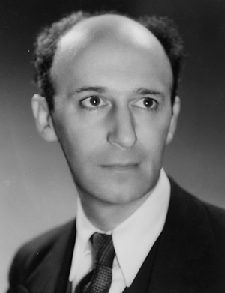 He was a concert pianist, a devotee of chamber music, a teacher, and a writer on musical and other subjects. He made numerous tours throughout the United States and Australia with Maud Powell (1914-1919), to Japan, China, and the Philippines with Mischa Elman (1920-1921), and again the United States with Ernestine Schumann-Heink (1921-1922).
He was a concert pianist, a devotee of chamber music, a teacher, and a writer on musical and other subjects. He made numerous tours throughout the United States and Australia with Maud Powell (1914-1919), to Japan, China, and the Philippines with Mischa Elman (1920-1921), and again the United States with Ernestine Schumann-Heink (1921-1922).
Mr. Loesser moved to Cleveland in 1926, joining the Cleveland Institute of Music faculty. In 1953, he became Head of the Piano Department at that institution.
During World War II, Mr. Loesser served in the Army as a Japanese language officer, retiring with the rank of major. He was ordered to Tokyo during the early months of the occupation, in the fall and winter of 1945-46. During that time he was soloist with the Nippon Philharmonic at Hibiya Hall, playing the Chopin Concerto in E minor, thus becoming the first American after the war, and while still in uniform, to perform music before a large Japanese audience.
Arthur Loesser was an active writer. From 1936 to 1941, he was editor of the program books of the Cleveland Orchestra. His book Men Women and Pianos: A Social History was published by Simon and Schuster in 1954. It became a standard work among literature written about the piano. Another book, Humor in American Song, was published in 1943.
An active recitalist and lecturer until his death (January 4, 1969), Arthur Loesser also was Cofounder and First President of the International Piano Library [which later became IPAM]. His brother, Frank Loesser, is the well-known Broadway composer.
SERIES DESCRIPTION
Series I - PERFORMANCE FILES
- Publicity articles
- Fliers
- Programs
- Reviews of performances involving Loesser
Series II - LOESSER AS TEACHER
- Master Classes
- Lectures
- Articles
Series III - CORRESPONDENCE
- Dated correspondence
- Undated correspondence
Series IV - LOESSER'S WRITINGS
- Miscellaneous Articles and papers concerning musical subjects except the piano
- Writings concerning the piano
- Book, concert, music and record reviews by Loesser
- Program and record notes by Loesser
- Miscellaneous writings by Loesser, including subjects not related to music
Series V - PHOTOGRAPHS
- Candid, publicity and portrait photographs
- Photographs of Loesser while teaching and performing
- Photographs of colleagues, family and friends of Loesser
- Miscellaneous photographs and negatives
Series VI - MISCELLANEOUS CLIPPINGS
Series VII - TAPES
- Dated 7-inch Reels
- Undated 7-inch Reels
- Five-Inch Reels
Series VIII - SUBJECT FILES
- Loesser's Life in Retrospect
- Loesser's Personal Life
- Loesser's Career
- Loesser's Colleagues
- Awards, Honors and Medals
- Loesser's Academic Records and Schoolbooks
- Biography in Progress
Series IX - MISCELLANEOUS
- Miscellameous Untranslated Materials
- Miscellaneous Materials
- Oversize Materials
Series X - MUSIC
- Catalogued Printed Music
- Non-catalogued Printed Music
- Manuscript by Loesser - Titled
- Manuscripts by Others
- Miscellaneous Manuscript
- Loesser Music Library at CIM
Series XI - SCRAPBOOKS
Jerome Lowenthal Collection
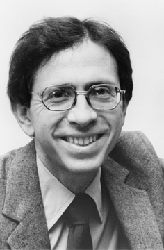
Jerome Lowenthal was born in Philadelphia, PA. in 1932. He made his debut with the Philadelphia Orchestra at the age of 13. He went on to study with William Kapell, Edward Steuermann and Alfred Cortot. He studied and performed in Europe before moving to Jerusalem, where he was a concert-lecturer at the Jerusalem Academy and an annual performer with the Israel Philharmonic. In 1961, Lowenthal returned to the U.S. and appeared with virtually every major orchestra in the country. For many years, he has been a faculty member at the Juilliard School in New York. Recordings by Jerome Lowenthal have been issued on the Vanguard, RCA and Arabesque labels.
Lee Luvisi Collection
Lee Luvisi was born on December 12, 1937, in Louisville, Kentucky. His principal studies there were with Dwight Anderson, a pupil of Isidore Philipp. At 14, he was admitted to the Curtis Institute of Music in Philadelphia where he became a student of Rudolf Serkin and Mieczyslaw Horszowski. Upon his graduation there in 1957 he was appointed to the major piano faculty.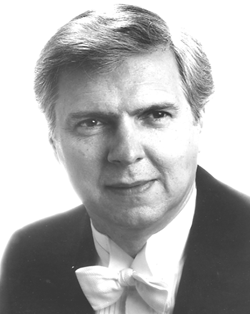
Luvisi made his Carnegie Hall recital debut in 1957, followed two years later by his first appearance with the New York Philharmonic. In 1960, he was a bronze medalist in the Queen Elisabeth of Belgium competition in Brussels.
In 1959, Luvisi married Nina Hussey. Their son, Brian, was born the following year. Luvisi moved with his family back to Louisville in 1963 when he was invited to become Artist in Residence at the University of Louisville School of Music, a position he held until his retirement in 2001.
Luvisi's performance activities through the years have included a formidable array of engagements across all of the fifty states, as well as in Canada, Mexico, Australia and Europe. He has been soloist with nearly every important orchestra in North America and under such distinguished conductors as Leonard Bernstein, Eugene Ormandy, William Steinberg, Stanislaw Skrowaczewski, Sir Neville Marriner and Robert Shaw. His brief European career in the late 60s and early 70s saw numerous highly-acclaimed appearances in London, Vienna, Berlin and other major capitals.
As a chamber pianist, Luvisi has collaborated with many of the world's foremost musicians and ensembles. Included amongst these have been the Juilliard, Guarneri, Cleveland and Emerson Quartets, and eminent artists such as Itzhak Perlman, Pinchas Zukerman, Alexander Schneider, Leonard Rose, Richard Stoltzman, Jan DeGaetani, Frederica von Stade, Benita Valente and Dawn Upshaw to name a few. For two decades, until 2003, he was an Artist Member of the Chamber Music Society of Lincoln Center.
Luvisi has participated in the Marlboro, Aspen, Casals, Mostly Mozart, Chamber Music Northwest, Chautauqua and Tanglewood summer festivals, among many others. He can be heard on the Delos, Bridge, Arabesque and Louisville Orchestra First Edition recording labels.
During the 2000/01 season Mr. Luvisi presented the complete solo piano works of Beethoven in a twelve-concert series in his native city where, a decade earlier, he had undertaken a similar marathon encompassing Mozart's complete solo keyboard compositions to celebrate that composer's bicentennial.
The Luvisi Collection contains Mr. Luvisi's meticulous documentation of his concert activity and his extensive repertoire of solos, concertos and chamber music. It also includes numerous privately-made recordings of his concerts and recitals.
Moura Lympany Collection
Mary Johnstone (Moura Lympany) was born in Cornwall, England on August 18, 1916. She received her first piano lessons from her mother at age 3. At 7, she was sent to school in Belgium, where she studied piano, violin and voice before proceeding to the Liège Conservatory of Music. She made her debut at age 12 in Harrogate, England, performing the Mendelssohn G Minor Piano Concerto. Her subsequent studies were with Paul Weingarten in Vienna, and with Mathilde Verne and Tobias Matthay in England.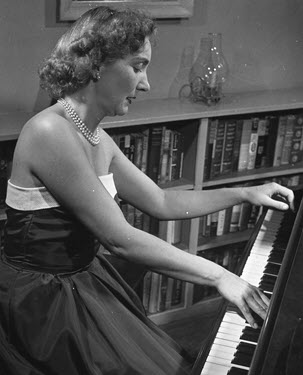
Lympany's concert career was firmly established in 1938, when she won Second Prize at the Ysaye Piano Competition, Emil Gilels being the First Prize winner. Moura Lympany enjoyed a career as a recitalist and soloist for over 60 years. She performed regularly in her native England, in Scotland and the United States, and she made several tours of Australia, New Zealand and South Africa. Moura Lympany was one of several pianists (including Myra Hess and Benno Moiseiwitsch) who performed frequently in England during WWII, and after celebrating 50 years on the concert platform in 1979, she was awarded the CBE (Commander of the British Empire) in 1980. Lympany had a large repertoire which featured standard works, but also included Concertos by contemporary British composers such as Richard Arnell, Cyril Scott, Alan Rawsthorne and John Ireland. She was the first western pianist to tour the Soviet Union after WWII, and she earned a reputation as an interpreter of Russian music. She performed Khachaturian's Concerto under his baton, and she was the first pianist to record the complete Rachmaninoff Preludes.
Her extensive discography consists of recordings for British Decca, HMV, and Erato. Later in life, Lympany curtailed her concert engagements to oversee her wine vineyards in Rasiguères, France, where she also established a festival of music and wine. She gave her last public concerts in 1996, and she died in France on March 28, 2005.
SERIES DESCRIPTION
Series I - Performance Files
Series II - Subject Files
Series III - Correspondence
Series IV - Photographs
Series V - Scores
Series VI - Audio / Visual
Solveig Lunde Madsen Collection
Solveig Lunde Madsen (originally Dorothy Lunde) was born in Vallejo, California on February 23, 1920. She began taking piano lessons at age 4 and demonstrated great precocity, excelling in music and academics. After graduating high school at age 15, Lunde studied with the renowned Danish pianist Gunnar Johansen, and with Harold Logan, both of whom were pupils of Egon Petri. In 1940 she received a four year fellowship for study at the Juilliard School of Music in New York City where her teacher was Olga Samaroff-Stokowski. Madame Samaroff considered Lunde to be one of the most promising students she had encountered and forecast a brilliant career for her. Lunde's talented classmates included William Kapell and Joseph Battista.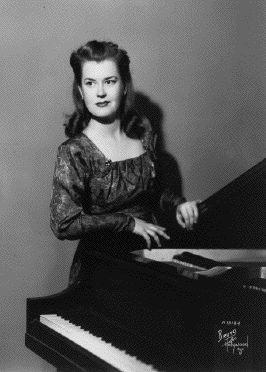
Lunde's critically acclaimed New York debut at Town Hall on December 6, 1944 was followed by tours of The U.S., Canada, Mexico and Scandinavia under Columbia Artists management. Her highly developed pianism was complimented by her titian red-gold hair, which made for a striking stage appearance. Lunde performed a varied repertoire, and her concert resumé includes first New York performances of works by Fartein Valen and William Bergsma. She also gave the first public performance of Prokofiev's 8th Piano Sonata, and her performance of Prokofiev's 7th Sonata in the U.S. was preceded only by that of Horowitz.
After six years of concertizing, Lunde married Lynn Madsen, a Civil Engineer with Arabian American Oil Company in 1950. Lunde greatly curtailed her concert activities while living in Rome, New York, Washington D.C. and Saudi Arabia from 1951 to 1971. She settled in Salt Lake City with her husband and two sons in 1971, and gradually resumed an active career as a performer, teacher, lecturer and adjudicator. Lunde has held teaching positions at Brigham Young University and the University of Utah, while maintaining a private studio. She is listed in the "International Who's Who in Music" and in "The World's Who's Who of Women". Solveig Lunde Madsen died on June 13, 2011 in Salt Lake City.
The Solveig Lunde Madsen Collection contains concert material pertaining to Lunde's career along with correspondence and other writings concerning her famous teacher Olga Samaroff Stokowski. Also significant to the collection are approximately 150 letters to Lunde from fellow Samaroff pupil William Kapell. These letters, written between 1941 and 1947, provide important insight into the early portion of Kapell's career.
William Masselos Collection
William Masselos was born on August 11, 1920 in Niagara Falls to a Dutch mother and a Greek father. Weeks after his birth, the family moved to Colorado Springs, where they remained until Billy was nine, two years after his first public recital. In New York, Billy played for conductor and music educator Frank Damrosch who prescribed a musical education. An educational career of 14 years commenced at the Juilliard School of Music where he studied with Nelly Reuschel and Clara Schumann disciple, Carl Friedberg. Masselos made his Town Hall debut at the age of 18.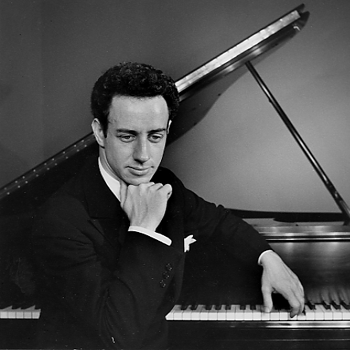
On April 5, 1952, Masselos played the Brahms Piano Concerto in D minor in his first appearance with the New York Philharmonic Orchestra, led by Dimitri Mitropoulos. This impressive debut was the first in a long line of appearances with major orchestras which also included the New York Philharmonic under Monteux and Bernstein, the Montreal Symphony under Klemperer, the London Philharmonic under Haitink, the American Symphony under Stokowski, the Philadelphia Orchestra under Ormandy, and numerous others.
A momentous occasion in Masselos's career occurred on December 11, 1969, with the presentation of a "marathon recital" at Carnegie Hall. The concert started at 7:OOpm and ended at 11:00pm, beginning with contemporary music, and then regressing through time as the night wore on, ending with the Chopin F minor Concerto led by Max Wilcox. Reviewer Harris Goldsmith described the marathon as being "of heavenly length," and his review continued:
"Until his recent Carnegie Hall triumph, greeted by a chorus of kudos from both critics and audience, Masselos could have been described as dwelling in a self-imposed exile from a fame easily within his reach. As his performance of the Chopin Concerto at the concert's end clearly showed, he could have followed the path of the Cliburns, the Brownings, or the Ashkenazys through the potboilers of Liszt, Tchaikovsky, and Rachmaninoff in order to court public adulation. He has more than enough tone, technique, and flair to have gone that route, and to have come out, indeed at the summit. Only an artistic conscience that would not be denied has kept him to his lonely course as a crusader for the forgotten, the neglected, the strange, and the new." (Jan 11, 1970)
Known as a champion of contemporary music, Masselos has premiered many works including the Charles Ives Piano Sonata No.1, the Piano Fantasy by Aaron Copland, most of the piano literature by Ben Weber, including the Concerto for Piano and Orchestra and the Fantasy (Variations), Op.25. He can also be credited with first performances of concertos by Alan Hovhaness, Johan Franco, Marga Richter, Carlos Surinach, and William Mayer, in addition to solo pieces by John Cage, Dane Rudhyar, Robert Helps, Carlos Chavez, and many others.
Masselos died on October 23rd, 1992.
Tobias Matthay Collection
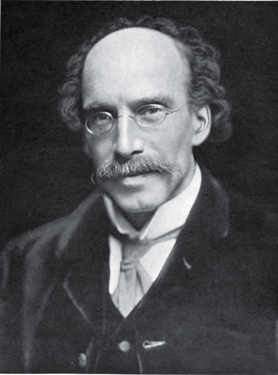 Tobias Matthay (1858-1945) was an eminent British piano pedagogue, pianist, and composer. Born in London, his early studies took place at the Royal Academy of Music. He joined the faculty of that school in 1880, continuing there until 1925. He also opened his own school which attracted hundreds students from throughout the United Kingdom and beyond. Matthay’s reputation was based partly on his extensive publications dealing with aspects of piano technique and interpretation. His most famous work was titled The Act of Touch in All Its Diversity; its first edition appeared in 1903. Matthay’s preoccupation with the physical and anatomical elements of piano playing generated much positive interest as well as considerable controversy. Not least of his accomplishments was the caliber of players whom he guided toward successful careers: Dame Myra Hess, Irene Scharrer, Harriet Cohen, Dame Moura Lympany, Denise Lassimonne, Eileen Joyce, York Bowen and Sir Clifford Curzon among them.
Tobias Matthay (1858-1945) was an eminent British piano pedagogue, pianist, and composer. Born in London, his early studies took place at the Royal Academy of Music. He joined the faculty of that school in 1880, continuing there until 1925. He also opened his own school which attracted hundreds students from throughout the United Kingdom and beyond. Matthay’s reputation was based partly on his extensive publications dealing with aspects of piano technique and interpretation. His most famous work was titled The Act of Touch in All Its Diversity; its first edition appeared in 1903. Matthay’s preoccupation with the physical and anatomical elements of piano playing generated much positive interest as well as considerable controversy. Not least of his accomplishments was the caliber of players whom he guided toward successful careers: Dame Myra Hess, Irene Scharrer, Harriet Cohen, Dame Moura Lympany, Denise Lassimonne, Eileen Joyce, York Bowen and Sir Clifford Curzon among them.
Matthay was also active as an occasional performer in public and as a composer with many published works. His output is chiefly for the piano. A detailed, scholarly study of Matthay’s life and career appeared in 2011: England’s Piano Sage by Stephen Siek (Scarecrow Press).
IPAM’s Matthay Collection consists of a nearly-complete assemblage of his published piano works, five songs for voice and piano, and copies of his pedagogical publications. These materials were donated by the late James Matthew Holloway through the good offices of Theodore Guerrant, and were originally in the possession of Denise Lassimonne. Of particular interest is the fact that many of the scores contain corrections, editorial markings and comments by Matthay himself.
Helen McGraw Collection
Helen McGraw was born in the Washington D.C. suburbs on December 23, 1905. She grew up in the Maryland countryside as one of four children of parents of modest means, descendants of families of British origin who had resided in the United States from colonial times.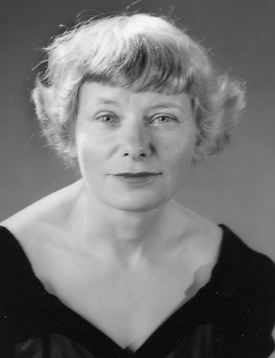
She showed unmistakable musical gifts as a child, and gained local attention for her playing of the violin and piano. The family recognized her talents, but never realized her full possibilities, so it was some time before she was presented for admission to the Peabody Institute in Baltimore. The Peabody gave her a scholarship which she held until she graduated in 1930 with its highest honor, the Artists Diploma.
Her teacher was Alexander Sklarevski, a refugee from Communist Russia, and at one time the head of a music conservatory in Czarist Russia. He had formerly worked and socialized with many of the great composers and performers and had become familiar with a wide repertoire.
The year of her graduation in 1930, Helen McGraw won the prestigious Walter W. Naumburg Musical Foundation competition. The Foundation launched her professionally with a New York concert.
For further seasoning, she spent a year in Europe playing in London, Paris and other musical centers. She participated in the Master Classes of renowned concert pianist Alfred Cortot and pursued studies at the Ecole Normale de Musique in Paris. Helen coached in chamber music with Jacques Gordon, the Concertmaster of the Chicago Symphony. Later, she collaborated with Gordon in concerts.
There was a growing movement among music lovers to hear a wider field of modern and sometimes older but seldom performed compositions. From the beginning, Helen McGraw broadened her programs to include many unfamiliar works. She often played first local performances, and always tried to make the new pieces understandable and easy to enjoy.
After a rewarding concert career, Helen McGraw passed away September 18, 1999.
Harold Morris Collection
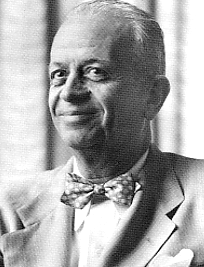
Harold Morris was born in San Antonio, TX. on March 17, 1890. He attended the University of Texas and later graduated with honors from the Cincinnati Conservatory of Music. Following graduation, Morris relocated to New York City and was a performer as well as a piano teacher. He began composing around this time and also made his debut as a concert pianist at Aeolian Hall in 1921. He went on to compose symphonies, sonatas and chamber music, among other compositions. Aside from extensive touring and annual recitals in New York City, Morris taught at Juilliard School of Music, Columbia University, Castle School, Duke University, Rice Institute and, his alma mater, the University of Texas. He died on May 6, 1964 in New York City.
SERIES DESCRIPTION
Series I - Published Scores by Morris
- Piano/Piano and Orchestra
- Chamber/Orchestral
Series II - Unpublished Scores by Morris
- Piano solo/Piano and Orchestra
- Instrumental music with Piano
- Songs with Piano Accompaniment
- Works for Orchestra
Series III - Other Files
Series IV - Commercially Issued Recordings
Series V - Private Transcription Discs
Series VI - Reel Tapes
Series VII - Published Scores by Other Composers
Series VIII - Unpublished Scores by Other Composers
Series IX - Autographed Scores by Other Composers to Harold Morris
Series X - Books
Mieczyslaw Munz Collection
Mieczyslaw Munz, born in Krakow on October 31, 1900, was hailed by audiences and critics during the 1920s and 30s as an interpreter of the highest caliber. Yet, he left only one commercial recording and had the misfortune of suffering an untreatable disorder of his right hand that effectively curtailed his performing career when he was in his early forties.
Nonetheless, Munz's artistic legacy is still with us today thanks to an impressive number of pupils whose own playing and teaching reflect the noble pianistic traditions that Munz represented. As far as recordings are concerned we are now able to hear two recently-discovered broadcasts of Munz in major works for piano and orchestra, owing to the efforts of the directors of the Mieczyslaw Munz Scholarship Fund. These valuable performances are now available on an Americus CD and partially compensate for the absence of additional studio recordings.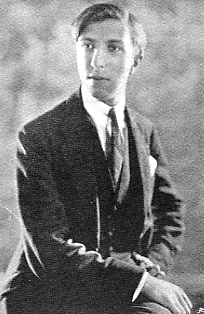
Entering the Krakow Conservatory at the age of nine, Munz worked under the tutelage of Jerzy Lalewicz (1877-1951), who had studied in St. Petersburg with Leschetizky's assistant (and second wife) Annette Essipova. Three years later, Munz made his debut in his native city playing the Tchaikovsky Concerto No.1. His teenage years were spent mostly in Vienna (where Lalewicz held a post at the Vienna Academy), and included a brief period of military service. The next stop was Berlin, home of Ferruccio Busoni. Munz soon became part of the famed Busoni "circle" and at the age of 20 he impressed the local audience by playing three concertos (the Liszt First, the Brahms First, and Franck's Symphonic Variations) in one evening with the Berlin Symphony Orchestra. Two years later he crossed the Atlantic for the first time to play his New York recital debut. "Pianoforte playing of a higher order than that disclosed at Aeolian Hall last night will probably be heard at some time, but not in many concerts this season," reported The New York Tribune. "It will come from not more than a half dozen men who have long been acclaimed as master musicians as well as virtuosos."
Munz soon decided to make his home in the United States, and the next two decades of his career were devoted to extensive touring. His concert itinerary took him throughout Europe and to Scandinavia, the Far East, and South America. In the U.S. he appeared with the orchestras of New York, Boston, Philadelphia, Saint Louis, Cincinnati and many other cities, and he collaborated with conductors like Reiner, Koussevitzky, de Sabata, Mengelberg and Gabrilowitsch. Munz's recital repertoire was comprehensive and it included all the standard masterworks (including Bach's Goldberg Variations), an impressive array of transcriptions (by Liszt, Busoni, Tausig, Godowsky, Dohnanyi and others), and vignettes by such composers as Liadov, Poulenc, and Rodrigo. Fortunately for posterity Munz kept extensive files of his concert programs and reviews from which he created a series of scrapbooks. Thanks to the generosity of Walter Hautzig, these are now part of the Munz Collection housed at the International Piano Archives, University of Maryland (College Park).
One of the more unusual events of Munz's career occurred quite unexpectedly on January 26, 1925. An audience had assembled in Carnegie Hall to hear a recital of Chopin and Liszt played by Ethel Leginska. Munz had just returned to New York from a concert tour and, having the evening free, decided to sit in on his colleague's performance. By 9:00, however, there was no sign of Ms. Leginska (who was later found wandering about the city in a "disoriented" state), so Munz gallantly volunteered to play in her stead. A slight rearrangement of the printed program was necessary, but Munz quickly earned repeated ovations from the audience and was recalled for many encores. The Musical America critic noted that "his style is sober and sonorous, and technically is often of great deftness" while also praising the "precision, grace and flexibility" of Munz's approach.
In 1925 Munz began what would become an impressive series of teaching positions at leading American conservatories: first in Cincinnati, then five years later in Philadelphia at the Curtis Institute (at the invitation of its director Josef Hofmann, a steadfast admirer of Munz's abilities). He also accepted a limited number of students at the Peabody Conservatory in Baltimore. After the second world war and until 1963 Munz directed much of his energy to his work on Peabody's piano faculty, and this was followed by twelve years of teaching at the Juilliard School in New York. Munz also had a devoted following in Japan, where he regularly offered master classes during the summer months at Gedai University in Tokyo.
Among the numerous pianists who studied with Munz at various times are Emanuel Ax, Antonio Barbosa, Felicja Blumenthal, Sara Davis Buechner, Alan Feinberg, Walter Hautzig, Hidemitsu Hayashi, Eugene Indjic, Jahja Ling, Charles Milgrim, David Oei, Reynaldo Reyes, Harold Rubens, Ann Schein, Ilana Vered, and Susan Popkin Wadsworth. "For me, simply no other teacher was necessary," said Emanuel Ax, while Susan Wadsworth recalled that Munz "was able, with the subtlest of suggestions, to guide each student to develop their own talent and musicianship. Technically, he gave his students the key to his own relaxed, flexible and swift technique. He delighted in seeing his students' amazement as a fingering suggestion, or a technical exercise for a tricky passage, led to an almost immediate solution of a problem."
Although Munz continued his extensive concertizing throughout the 1930s, that decade marked the less fortunate period of his career. Around 1930 Munz was briefly married to Aniela Mlynarska (the daughter of an eminent Polish conductor), but the relationship was dissolved and soon thereafter Aniela became the wife of Arthur Rubinstein. A few years later the atrocities of the Nazi party brought about the loss of Munz's family in Europe, and in the early 1940s Munz developed a severe medical problem in his right hand which resulted in an end to his public performances. At that point Munz re-dedicated himself to teaching and he carried out his responsibilities with great distinction until his death on August 25, 1976.
SERIES DESCRIPTION
Series I- Scrapbooks
Alice and Arthur Nagle Collection
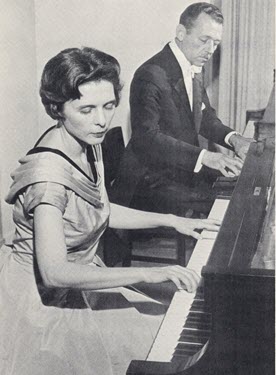
The husband and wife team of Alice and Arthur Nagle performed duo piano concerts in the Washington DC area and throughout the United States for almost 50 years. They met while studying with Edwin Hughes at the Washington College of Music. The two joined the faculty at the Washington College of Music and played their first duo piano concert together in 1943 before Arthur Nagle joined the army. They received coaching as a duo piano team from Nadia Boulanger and duo-pianists Gold and Fizdale. The Nagles performed in recital, lecture recitals and on radio and television. They were advocates for twentieth century music and had duo piano works written for them by several composers including Richard Bales, Esther Ballou, Robert Evett, Mary Howe and Malcolm Williamson.
The Nagle Collection consists of a large number of published and unpublished scores of duo piano works, as well as concert programs, articles and unpublished acetate discs of performances by the Nagles.
Arthur Newstead Collection
Arthur Newstead was born in London August 4, 1881 and studied piano at the Royal Academy of Music under Oscar Beringer and later with Harold Bauer. Months after his graduation from the Royal Academy, his distinction, earned from many masterful concert performances, promoted him to Professor of that institution at the young age of 21 years. After two years, Newstead was forced to resign his position due to numerous public engagements following his tremendous success at an orchestral concert in which he played three concertos by Beethoven, Liszt, and Saint-Saëns.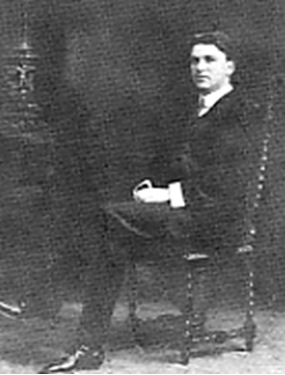
By the time he was 27, Newstead had already visited and performed in 17 different countries, playing more than 200 concerts. After a tour of the British Isles during 1904-1905, he traversed the Western Hemisphere, starting with South America, then Mexico, and finally the West Indies. His success in Buenos Aires demanded eleven concerts before the final farewell concert and a contract was made to return the following August. A similar success in Mexico City resulted in twelve concerts given during the span of a month at which Newstead played over 100 works.
During the winter of 1906-1907, Newstead toured Norway, Sweden, Denmark, Finland, Switzerland and Germany at which time he had the opportunity to play before the Royal Family in Sweden three times and was received with high praise. Upon hearing Newstead's performance of one of his own works, Edvard Grieg exclaimed that Newstead's interpretation of the work coincided very nearly with his own. At the close of his third tour of South America in 1913, Newstead was invited to join the piano faculty of the Peabody Conservatory in Baltimore, Maryland. Soon thereafter, his former pupil, Katherine Bacon sailed to America to resume her study with Mr. Newstead. On May 29, 1916, three days after her graduation from Peabody, Bacon and Newstead were married. The following year, a daughter, Joan, was born.
Next, Newstead accepted a teaching position at the Institute of Musical Art (now the Juilliard School) in New York City and for a short while he taught both in Baltimore and New York. Finally, the family settled permanently in NYC, and Arthur Newstead remained on the Juilliard faculty for 35 years.
Arthur Newstead died in his home in New York City on April 1, 1952.
SERIES DESCRIPTION
Series I - Performance Files
Here are found programs and promotional fliers related to specific performances by Arthur Newstead. The files are arranged chronologically and span the period May 15, 1908 through July 28, 1937. This series is located in Box 3.
Series II - Correspondence Files
This file contains two letters and is located in Box 3.
Series III - Photographs
Located in Box 3 are eight photographs that are divided into two subseries:
1. Formal Portraits
2. Miscellaneous Photographs
Series IV - Subject Files
Here are found documents relating to Arthur Newstead's personal and professional life. This series is located in Box 3 and is divided into 4 categories:
File 1 - Publicity
File 2 - Biographical Articles
File 3 - Obituary
File 4 - Legal Documents
Newstead's materials are found within the Katherine Bacon Collection, and as such are included in the Katherine Bacon Collection Finding Aid.
Leonard Pennario Collection
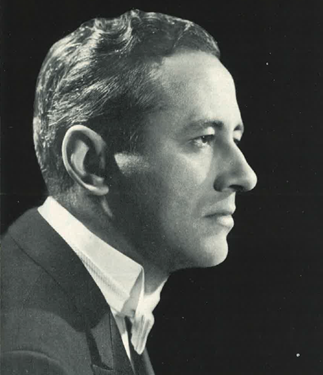
Born in Buffalo, NY (July 9, 1924), Pennario enjoyed a long and distinguished career in the United States and Europe, playing a wide repertoire (over 40 concertos) with most of the major orchestras, and countless recital appearances as well. Beginning in 1961 he collaborated with violinist Jascha Heifetz, cellist Gregor Piatigorsky, and several of their colleagues in a series of chamber music concerts and recordings. He gave the premiere of Miklos Rozsa's piano concerto (written for Pennario). Pennario was acclaimed for his high level of professionalism, consistency, stylistic versatility and impeccable command of the instrument.
Pennario's recorded legacy, mainly for Capitol, RCA Victor, and Angel/EMI, is extensive, and much of his discography remains available on those labels as well as on MSR Classics. Some of his early discs represent first recordings of works by Prokofiev and Ravel.
Pennario died in La Jolla, California on June 27, 2008.
Thanks to a generous donation from Mr. Greg Morse, IPAM now houses digital copies of all of Pennario's recordings as well as digital files containing thorough coverage of Pennario's career. In 2021, the Pennario Collection was significantly augmented by a donation from Dr. Aimee Pearson, containing numerous programs, reviews, and correspondence relating to Pennario's concert and recording activity in the US and abroad.
Much additional documentation is now available at www.pennario.org.
Sylvia Rabinof Collection
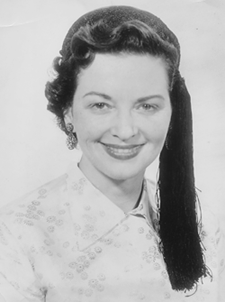
Sylvia Rabinof was born Sylvia Smith in New York on October 10, 1913. She died in Florida on January 20, 2001. Along with her husband, violinist Benno Rabinof, Sylvia Rabinof formed one of the more popular duos of her era. They extensively toured the U.S., Europe, Asia and Africa throughout their career together. The duo performed a mix of classical and contemporary pieces. Sylvia Rabinof was also an author ("Musicianship Through Improvisation" and "The Improviser"), composer and teacher. She was a member of the faculties at SUNY Fredonia and Brevard Music Center.
The Sylvia Rabinof Collection contains concert programs, reviews and scrapbooks documenting Sylvia Rabinof’s concert career as a piano soloist along with her extensive concert activities with her husband, Benno Rabinof. Also contained are manuscripts, proofs and published scores of Sylvia Rabinof’s numerous arrangements and original compositions, along with various drafts and notebooks for her workshops on Musicianship Through Improvisation. The Sylvia Rabinof Collection also contains recordings of many live performances by the Rabinofs.
Nadia Reisenberg Collection
"Soloist, chamber musician and teacher" describe Nadia Reisenberg, whose studies with Leonid Nikolayev (St. Petersburg Conservatory), with Alexander Lambert (a Liszt pupil) and with Josef Hofmann provided her with the musical judgment and technical skills with which to build a career. The excitement of her early concert appearances in New York in the 1920s attracted much attention, and she became an important concert artist. As a concerto soloist, she appeared with Barbirolli, Rodzinski, Bodanzky, Koussevitsky, and others. Her performances of all twenty-seven of the Mozart concertos, played in consecutive weekly broadcasts with Alfred Wallenstein and the WOR Mutual Radio Symphony Orchestra in the 1939-40 season, are now legendary. (The Mozart broadcasts have been digitized and transferred to CD-Rs; copies of these recordings are available. Contact the Curator for details.) 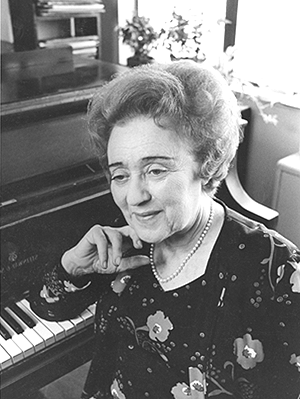
After about 1947 she chose to concentrate on small ensemble work and teaching. She performed with the Budapest and Juilliard String Quartets and with a variety of instrumentalists, including Joseph Schuster, William Kroll, Erick Friedman, Simeon Bellison, Alexander Schneider, Benny Goodman and with her sister, noted thereminist Clara Rockmore. She was associated with the Mannes College of Music and the Juilliard School but also taught at the Curtis Institute of Music, the University of Southern California, the Rubin Academy of Music in Jerusalem and at other schools.
Reisenberg's repertory was extremely varied, but she was noted especially for her presentations of nineteenth and twentieth-century Russian piano works. She gave the New York premiere of the Rimsky-Korsakov Piano Concerto and played the first American performance of Vincent d'Indy's Symphony on a French Mountain Air, both with the New York Philharmonic.
Aside from her teaching, Reisenberg's principal legacy is her recordings. In addition to her commercial issues, there are approximately two hundred acetate transcription discs which include her performances of the Mozart concertos with Wallenstein, her repertory of solo and chamber music, and radio interviews.
The International Piano Archives at Maryland has published a book about Nadia Reisenberg and issued a double-compact disc record album as follows:
Robert Sherman and Alexander Sherman. "Nadia Reisenberg: A Musician's Scrapbook." College Park: International Piano Archives at Maryland, 1986. 192 p.
NADIA REISENBERG: An Album of Chamber Music. College Park: IPAM Records, 1989. (IPAM 1201 A-B). Includes performances with Alexander Lambert, Simeon Bellison, Joseph Schuster, Benny Goodman, Leonard Rose, Erick Friedman, Clara Rockmore, and members of the Juilliard Quartet.
SERIES DESCRIPTION
Series I - Performance Files
Here are found programs, advertising, reviews and like documents that are related to specific performances. The materials are organized chronologically by performance date.
Series II - Correspondence
Here are found letters to and from Nadia Reisenberg as well as letters written to other persons concerning her. There are 307 items in this series, separated into seven sub-series covering letters to Reisenberg, letters to her son Bob Sherman, and correspondence concerning Reisenberg but not addressed to her. Of particular interest are the letters she received from John Barbirolli, Abram Chasins, Walter Damrosch, Josef Hofmann, Aram Khatchaturian, Gregor Piatigorsky, Artur Rodzinski, William Schuman, Rudolf Serkin, Albert Spalding, Deems Taylor, Carl Tollefsen, Karl Weigl, and Efrem Zimbalist. Letters serving as contracts are included in the legal documents of Series III.
Series III - Subject Files
Here are found writings and publications of Reisenberg, records of her performing and recording career, documents related to her teaching and adjudication work, contracts (some in the form of letters) and other legal documents, and other written materials concerning her life and work. These materials are in twenty-eight sub-series covering her articles and other writings, her personal management and career promotion, her recording contracts, her repertoire, honors she received, passports for her and her family, materials concerning her family life, materials concerning her work as a teacher, clinican and adjudicator, miscellaneous biographical materials, two autograph books, a drawing, and several items, as yet untranslated, in Russian.
Series IV - Related Materials
Here are found four items given to Reisenberg by friends:
- an autobiography of Sophie Satin
- a biography of Wassily Safonoff
- two printed musical scores
Series V - Photographs
Here are found publicity and personal photographs (including photographic portraits) of Reisenberg, her friends and colleagues, her students, and her family as well as snapshots of places she visited. These are organized into seven sub-series:
- publicity and portrait photographs
- snapshots, Reisenberg teaching and performing
- colleagues and friends
- other materials related to Reisenberg
- family photographs
- miscellaneous photographs
Series VI - Audio Materials
Here are found 524 phonograph discs, 86 tapes (reel-to-reel and cassette), and 10 Duo-Art piano rolls. These recordings are mostly Reisenberg performances but also include radio interviews with and about Reisenberg. Many of the discs represent unique transcription recordings and out-of-print commercial recordings.
Series VII - Films
Here is found a single reel of film entitled "1930-31 - Nadia's Parties and Hofmann."
Ada Richter Collection
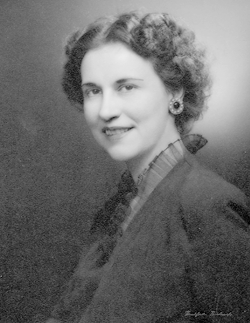 Ada Richter was born August 10, 1900. She began studying piano at age five. Her first teacher was "a young girl who played very little but taught Ada the notes."* After one year, she could play everything the teacher could play and she became a class accompanist in grade school.
Ada Richter was born August 10, 1900. She began studying piano at age five. Her first teacher was "a young girl who played very little but taught Ada the notes."* After one year, she could play everything the teacher could play and she became a class accompanist in grade school.
Upon graduation from high school at age fifteen, she attended Camden (N.J.) Normal School to become an elementary school teacher. For the next nine years, Richter taught oversized classes of disadvantaged children in a poor area of New Jersey. At this time, she also studied piano with Camille Zeckwer and Leo Ornstein at the Zeckwer-Hahn Musical Adademy in Philadelphia (now the Philadelphia College of Music and Arts).
In 1921, she married her first husband, with whom she had two children. Her brother Dick was a very big influence in her life. He would sing show-tunes to her accompaniment. This introduced her to a world of new music, and was directly responsible for her arrangements for Warner Brothers and others.
Later, she began study with Alfred Richter, whom she married in 1932. He encouraged her to compose and to get her music published. Her first publication was for Schirmer and her first songbook was published by Presser. She was so prolific a writer that she was advised to take on a nom de plume. In addition to Ada Richter she became "Hugh Arnold," "Wilma Moore," and "Eileen Gail." She even wrote words to her own music under her pen names.
Her lecture years began in the early 1940s. For some time she lectured alone. Alfred and Ada began duo lectures in the 1950s. Together, they made five transcontinental tours. This ended in 1976 with Alfred's death. Toward the end of Ada's career, she met with music teachers privately who wanted to become acquainted with her method. She taught only one pupil personally, her great-grandson. Ada Richter died in 1988.
* Boutwell, Florence. "The Richters: Ada and Alfred." (unpublished)
Sviatoslav Richter Collection
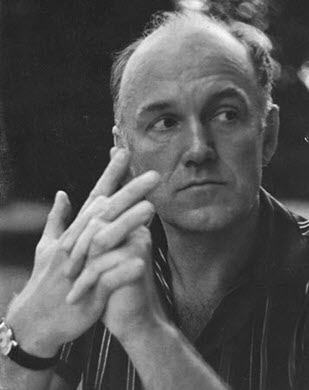
Sviatoslav Richter (1915-1997), one of the supreme pianists of the 20th century, is also one of the best-known, most extensively recorded, and in many ways most enigmatic figures in the annals of pianism. Born in what is now Ukraine and trained in Moscow, mainly by Heinrich Neuhaus, Richter's life and career have been thoroughly documented in all standard sources.
In addition to hundreds of commercial recordings and files of programs, articles, and reviews, IPAM's holdings dealing with Richter are comprehensive. They consist of three separate but related collections: (1) approximately 700 privately-recorded CDs and DVDs of Richter recitals and concerts covering the full extent of his career. These come from the collection of the late Ates Tanin of Toronto, Canada. (2) The Richter archive of Falk Schwarz of Cologne, Germany. Dr. Schwarz was the co-founder of "The Friends of Richter and Gilels," an international group devoted to documentation of Richter's activity throughout his life. Included here are the newsletters of that organization; a 1200-page "Konzertographie" of all of Richter's public performances as well as copies of Richter's own concert diaries; over 100 photographs; and seven volumes of clippings from magazines, newspapers and other publications from 1948 to 1988. (3) Approximately two dozen books on Richter, mainly Russian-language publications assembled by private collector Peter Greenleaf.
Walter Robert Collection

Walter Robert enjoyed a long and varied career as a recitalist, accompanist, lecturer and writer. Born in Trieste, Italy in 1908, he received his training in Vienna at the State Academy of Music. He concertized in Europe until the German annexation of Austria. Robert taught at North Texas University and held various professorships in Florence, Bologna, Naples, Vienna and Taiwan, but his longest tenure as a teacher was at Indiana University, where he taught from 1947 to 1975. While maintaining a heavy teaching schedule, Robert also earned wide recognition as an accompanist, having performed with artists such as Berl Senofsky, Ossy Renardy, Carroll Glenn and Josef Gingold. Robert was a lifelong scholar of varied interests who published books and articles in addition to giving lectures. Subsequent to his retirement at Indiana University, he earned a masters degree in classical languages. Walter Robert died in 1999.
Josefa Rosanska Collection
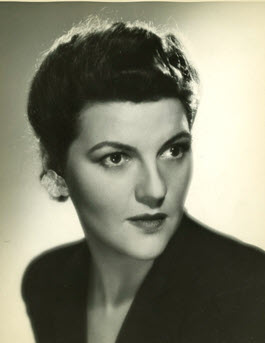 Josefa Rosanska was born Josephine Rosensweet in New York City in 1904. From a very early age she played piano accompaniments in performance for her father David Rosensweet, a violinist with the Chicago Symphony Orchestra. Her earliest studies were in Chicago with Eva Koch, Emil Liebling and Heniot Levy. Further studies were with Ernest Hutcheson at the Juilliard School and with Edward Steuermann in Vienna. She played Mozart’s D minor Concerto in her first public concert appearance at age 9, followed by a performance at age 13 of the Chopin E minor Concerto with the Chicago Symphony Orchestra, conducted by Frederick Stock. She concertized throughout the United States and Europe, and she won particular acclaim in Central and South America. She performed under many eminent conductors of her time, including Serge Koussevitzky, Otto Klemperer, Pierre Monteux, Ernö Rapée and Ernest Ansermet. Rosanska was the first wife of Viennese violinist Rudolf Kolisch of the Kolisch and Pro Arte String Quartets. Rosanska was friends with George Gershwin and retained a manuscript of an unpublished piano piece given to her by him entitled “rubato”. This work received its first public performance by pianist Joseph Smith in 1987. Josefa Rosnaska died in 1986.
Josefa Rosanska was born Josephine Rosensweet in New York City in 1904. From a very early age she played piano accompaniments in performance for her father David Rosensweet, a violinist with the Chicago Symphony Orchestra. Her earliest studies were in Chicago with Eva Koch, Emil Liebling and Heniot Levy. Further studies were with Ernest Hutcheson at the Juilliard School and with Edward Steuermann in Vienna. She played Mozart’s D minor Concerto in her first public concert appearance at age 9, followed by a performance at age 13 of the Chopin E minor Concerto with the Chicago Symphony Orchestra, conducted by Frederick Stock. She concertized throughout the United States and Europe, and she won particular acclaim in Central and South America. She performed under many eminent conductors of her time, including Serge Koussevitzky, Otto Klemperer, Pierre Monteux, Ernö Rapée and Ernest Ansermet. Rosanska was the first wife of Viennese violinist Rudolf Kolisch of the Kolisch and Pro Arte String Quartets. Rosanska was friends with George Gershwin and retained a manuscript of an unpublished piano piece given to her by him entitled “rubato”. This work received its first public performance by pianist Joseph Smith in 1987. Josefa Rosnaska died in 1986.
SERIES DESCRIPTION
Series I – Programs, Reviews, Publicity
Series II – Programs: Other Performers
Series III – Correspondence
Series IV – Miscellaneous
Series V – Biographical
Series VI – Articles
Series VII – Photographs
Olga Samaroff Collection
Madame Olga Samaroff-Stokowski (nee Lucy Mary Olga Agnes Hickenlooper) was born in San Antonio, Texas, August 8, 1880, while her father was an officer in the United States Army stationed there. At the age of three she astounded her mother and grandmother (both of whom were music teachers) by improvising melodies at the keyboard. At twelve years of age, she was taken to Europe by her grandmother, where she remained until she was twenty-one. She was the first American woman to be given a scholarship in the piano class at the Paris Conservatoire, where she studied with Antoine Francois Marmontel (teacher of Bizet, Dubois, Giraud and others), Ludovic Breitner, and with E.M. Delaborde (the illegitimate son of Charles-Valentin Alkan). She made a highly successful debut in Paris and shortly thereafter she married a Russian engineer, Boris Loutzky, and went to Berlin where she studied with Ernest Hutcheson, Otis B. Boise and Ernest Jedliczka (pupil of Anton Rubinstein and Tchaikovsky). Her marriage was brief and ended in an annulment.
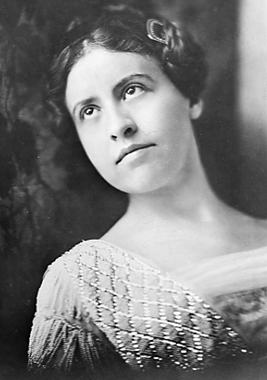 Her successful pianistic debut in America was January 8, 1905, at Carnegie Hall, with the New York Symphony Orchestra (Walter Damrosch conducting). This was followed by extensive tours in America and Europe. She ranked with the foremost women pianists, such as Clara Schumann, Annette Essipov and Teresa Carreno. Upon the advice of her manager, Henry Wolfsohn, she chose the professional name of Olga Samaroff from a remote Russian relative and used it throughout her career.
Her successful pianistic debut in America was January 8, 1905, at Carnegie Hall, with the New York Symphony Orchestra (Walter Damrosch conducting). This was followed by extensive tours in America and Europe. She ranked with the foremost women pianists, such as Clara Schumann, Annette Essipov and Teresa Carreno. Upon the advice of her manager, Henry Wolfsohn, she chose the professional name of Olga Samaroff from a remote Russian relative and used it throughout her career.
In 1911, she became the wife of Leopold Stokowski, then at the beginning of his brilliant career as a conductor. Their marriage also ended in divorce twelve years later. Their one daughter, Sonya, married Lieutenant William Thorbecke, the son of a Dutch diplomat.
During the 1920s, Samaroff made an extensive series of recordings for the Victor Talking Machine Company, including works of Bach, Chopin, Liszt, Juon, Lecuona, and others. Most of Samaroff's recordings have been reissued on a compact disc produced by Pearl Records of England.
An injury to her left arm in 1926 compelled Samaroff to cancel all concerts for the season, after which she accepted the position of chief music critic of the New York Evening Post which she continued for two years. Her broad knowledge, varied musical experience and clear style were highly praised. The Post attempted to retain her for three more years but she declined their offer to devote herself to educational work and lecturing.
When the Juilliard Foundation organized its Graduate School in 1925, Samaroff was asked to join the faculty. In 1927, she became head of the Piano Department of the Philadelphia Conservatory. She held both positions, traveling between New York and Philadelphia, until her death.
In 1927, she founded the Schubert Memorial, Inc., with a view of providing opportunities for young artists to obtain a hearing in the larger concert and opera field. In 1931, she was one of the four founders of the Musician's Emergency Aid of New York, which collected and distributed large funds to musicians in need during the Great Depression.
Samaroff's services as a lecturer were in great demand. She appeared at Yale, Harvard, Columbia and many of America's finest universities. Her lectures were prepared with extreme care and delivered eloquently. Realizing that one of the great needs of America was a layman's music course for listeners, she arranged, in 1935, with the W.W. Norton Company, to publish a series of books to bring together musical ideas and information to educate the layman. "The Layman's Music Book" resulted, followed by her autobiography, "An American Musician's Story," a few years later. Her success with "The Layman's Music Course" was outstanding, resulting in several years of subscription lecture series given at Town Hall in New York.
Notwithstanding her eminent position as a virtuoso, a critic, an author, lecturer and organizer, Samaroff is perhaps best known for her distinguished career as a teacher. She was extremely dedicated to her students and would go to extraordinary lengths to provide for them the best, well-rounded education possible in preparation for a concert career. Some of her more distinguished pupils were William Kapell, Claudette Sorel, Rosalyn Tureck, Joseph Battista, Eugene List, Sigi Weissenberg and Raymond Lewenthal.
Samaroff died after a brief illness on May 17, 1948 in her New York apartment. Further details of Samaroff's life and career may be found in a 60-minute documentary video produced by Samaroff researcher and biographer Donna Kline: "Virtuoso--The Olga Samaroff Story," available via amazon.com. (For further information, see www.olgasamaroff.com.)
SERIES DESCRIPTION
Series I - Correspondence
The OS Collection contains a substantial amount of correspondence.
Series II - Writings
This series contains the writings of OS from various periods of her life. It is divided into:
- Unpublished Writings
- Published Writings
- Radio and Lecture Scripts
Series III - Photographs
Here are found publicity and personal photographs (including photographic portraits) of OS, her family and friends as well as a small collection of slides and negatives. There are approximately 41 items (excluding the slides and negatives) and 2 photo albums which are located in Boxes 11 and 12. Oversized materials (framed/mounted pictures) are stored separately.
Series IV - Subject Files
Here are found various materials that have been divided into the following subseries, and located in Boxes 13-20:
- Biographical Materials/Published Articles/Other
- OS as pianist
- Lectures (tours)
- Book Reviews
- Students
- Educational Institutions
- Leopold & Sonya Stokowski
- Miscellaneous
- Layman's Musical Course
Series V - Scrapbooks
There are a total of 12 scrapbooks consisting of mainly newspaper clippings and some photographs. The materials are organized chronologically. Articles are about OS (her career as pianist, writer, teacher, lecturer and broadcaster), OS and Leopold Stokowski, Sonya, and OS' students. One of the scrapbooks consists only of materials about Leopold Stokowski. (Red, oblong scrapbook). There are three notebooks (with leather covers) which list O.S's repertoire and programs from various places.
Series VI - Recordings
Consisting of approximately 21 items, divided into the following four subseries:
- OS Broadcasts, containing the WQXR broadcasts of "Getting Your Music's Worth" in 1945.
- OS Piano Recordings
- OS Students' Recordings
- Miscellaneous Commercial Recordings
Series VII - Books
There are a total of 360 books in the collection including scores, story books, travel books, cultural books, children's books and dictionaries. They are listed alphabetically under each subject and can be found in Boxes A-M.
Series VIII - Miscellaneous
David Saperton Collection
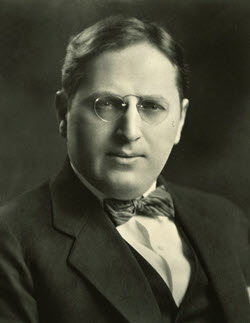
David Saperton (1889-1970) was born David Sapirstein in Pittsburgh, PA, and made his debut in that city at age 10. His New York debut was at the age of 15, after which he studied in Europe with August Spanuth and was also a member of Ferruccio Busoni’s “circle” in Berlin. Upon returning to the US he met Leopold Godowsky, who left a major imprint on Saperton’s pianistic outlook. Saperton married Godowsky’s daughter Vanita in 1921, and he frequently offered Godowsky’s original works and transcriptions on his recital programs. In 1924 he joined the faculty of the newly-formed Curtis Institute of Music in Philadelphia, and retained that position until 1941. During his Curtis tenure he served as assistant to the school’s director, Josef Hofmann. Among the more noted pianists who Saperton taught during this period were Shura Cherkassky, Jorge Bolet, Abbey Simon, Sidney Foster, and Seymour Lipkin. After leaving Curtis, Saperton established a private studio in his New York home at 344 West 72nd Street, where his other prominent pupils included Julius Katchen and William Masselos.
Saperton composed a number of effective piano pieces, among which are several in boogie-woogie style, and he also wrote a sophisticated, Godowskyesque paraphrase of Gershwin’s “Bess, You is My Woman Now,” recently recorded on CD by Jenny Lin. After the 1930s Saperton’s public performances were infrequent, but he left a recorded legacy that includes discs made for RCA Victor in 1941, for the Command Performance LP label in 1952, and for Kapp Records in 1958. These recordings include not only the complete Chopin Etudes, but also a varied selection of Godowsky works. A CD reissue of most of Saperton’s recordings is available on the VAI label. Until a revival of interest in Godowsky began in the 1980s, Saperton, in the words of Abram Chasins, “alone had both the will and the skill to play and record a sizable number of Godowsky’s compositions.”
SERIES DESCRIPTION
The Saperton Collection consists of scores, including published and unpublished works by Saperton, programs, reviews, photographs, correspondence, together with legal and financial documents.
Ernest Schelling Collection
Ernest Schelling was born in Belvedere, N.J. on July 26, 1876. He studied music with his father and made his debut as a pianist at the Academy of Music in Philadelphia at the age of four. By age seven, he was taken to study music in Europe. He was admitted to the Paris Conservatoire and worked with many great masters of Europe including Goetschius, Huber, Barth, Moszkowski and Leschetizky. He played for the crowned heads of Europe and also for such musical luminaries as Rubinstein and Brahms. At the age of twenty he began studying with Ignace Paderewski and was his only pupil for three years. This would turn out to be a great life-long friendship and an important musical partnership for both.
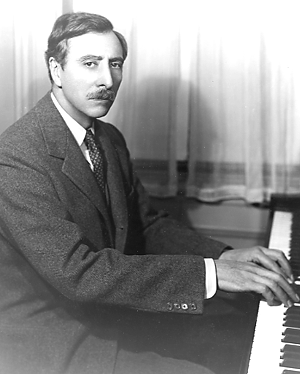 At the beginning of the century, Schelling toured Europe, South and North America with brilliant success, gaining a reputation as a remarkable pianist. He then took a post as the court musician to the Duchess of Mecklenburg-Schwerin, and began to compose as well. Schelling wrote many works that were often played during his lifetime, including works for piano, orchestra, and chamber groups. Since his death these have regrettably fallen from the repertoire. His most popular work was "A Victory Ball," a symphonic poem for orchestra based on a poem by Alfred Noyes, which received very appreciative reviews in America and Europe.
At the beginning of the century, Schelling toured Europe, South and North America with brilliant success, gaining a reputation as a remarkable pianist. He then took a post as the court musician to the Duchess of Mecklenburg-Schwerin, and began to compose as well. Schelling wrote many works that were often played during his lifetime, including works for piano, orchestra, and chamber groups. Since his death these have regrettably fallen from the repertoire. His most popular work was "A Victory Ball," a symphonic poem for orchestra based on a poem by Alfred Noyes, which received very appreciative reviews in America and Europe.
In 1917, he joined the U.S. Army intelligence corps, and served bravely in the First World War. He was highly decorated not just by the U.S., but also by Poland, Spain and France, and was discharged as a Major at the end of the war.
In 1924, Schelling was appointed conductor of the Young People's Concerts of the New York Philharmonic Symphonic Society. These children's concerts were to take up the bulk of his time and energy for the rest of his life. The concerts were a combination of lecture, picture show and orchestral performance that he designed to encourage in children a love and understanding of music. He not only conducted these concerts in New York but all over the country and even the world, earning great success everywhere from Philadelphia and Los Angeles to London and Rotterdam. From 1936 to 1938, he also took on an appointment as music director of the Baltimore Symphony.
Schelling was also very active in many other aspects of musical life. He organized benefits for composers, worked with the Musicians Relief Fund, and was the president of the Edward MacDowell Association beginning in 1929. He was friendly with most of the great musicians from America and Europe and often entertained them at his summer home on Lake Geneva. He greatly facilitated the acceptance of American music and musicians in Europe and helped bring many great European musicians to America, including Enrique Granados whom Schelling championed until Granados's untimely death in 1916. Schelling died in his home in New York City on December 8, 1939.
THE COLLECTION
The Ernest Schelling collection contains a large variety of materials reflecting his diverse interests. There is a great deal of information on Ernest Schelling himself, including detailed sections on his various careers as pianist, composer, conductor and author. The collection also contains a great deal of correspondence, mostly from musicians. This includes a great number of letters from Granados as well as from Fritz Kreisler and Josef Hofmann. The bulk of the papers relate to the Children's Concerts including lecture, program and slide materials. There is also a substantial score collection that features not only Schelling's own compositions and other rare piano scores, but also valuable early editions of Chopin and Beethoven and several very rare 18th century prints. Lastly, there is a quite sizable collection of iconography of various types, including many photographs of Schelling and his family.
Harold C. Schonberg Collection
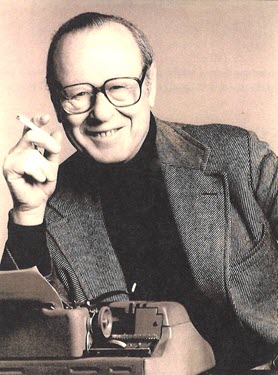
Harold C. Schonberg, one of the world's leading music critics, was born in New York City in 1915. He received his B.A. from Brooklyn College and an M.A. from New York University. He has been conferred the honorary degrees of Doctor of Letters from Temple University and Doctor of Humane Letters from Grinnell College. He joined the New York Times in 1950 as music critic, was named senior music critic in 1960 and continued at that post until he became cultural correspondent in 1980. Schonberg was awarded the Pulitzer Prize for Criticism in 1971. The author of more than a dozen books -- including "The Great Pianists," "The Great Conductors," "Lives of the Great Composers," "Facing the Music," "The Glorious Ones" and "Horowitz: His Life and Music" -- Schonberg has served as a juror in many international piano competitions, including the Rubinstein in Tel Aviv and the Liszt in Budapest.
Schonberg died on July 27, 2003.
As of 2003, IPAM's Schonberg Collection consists mainly of a correspondence file of letters to and from Mr. Schonberg and various musicians and readers of his reviews. Further details are available on request.
Alexander Siloti Collection
Alexander Ilyich Siloti (Ziloti), one of the few pianists to carry into the 20th century the "grand manner" of pianistic interpretations typified by the Liszt-Rubinstein schools, was born near Kharkov in the Ukraine on October 9, 1863 and died in New York City on December 8, 1945. At the Moscow Conservatory, he studied piano with Zverev and Nicholas Rubinstein (and for a brief time with Nicholas's brother, Anton), and composition with Tchaikovsky. He was a pupil of Franz Liszt at Weimar from 1883 to 1886 and became the master's devoted disciple. Returning to the Moscow Conservatory in 1887, he taught (among others) his younger cousin, Sergei Rachmaninoff. Between 1891 and 1901, he lived in Frankfurt am Main, Antwerp, and Leipzig, pursuing a career as concert pianist. He played in the United States in 1898 and 1899.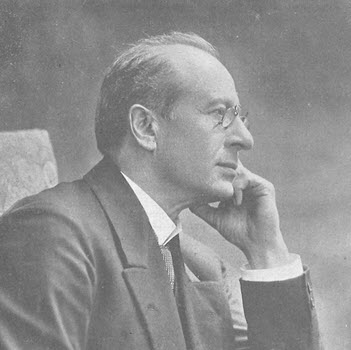
Siloti began a conducting career in 1901 by accepting the directorship of the Moscow Philharmonic. In 1903 he founded his own orchestra in St. Petersburg with which he introduced much new music, including works of the French impressionists and Elgar. He also championed the music of Liszt and the younger Russian composers (including Gnessin, Glazunov, Stravinsky, Scriabin, Prokofiev and, of course, Rachmaninoff). As a conductor he offered performance opportunities to young artists such as Pablo Casals, Wanda Landowska, Fritz Kreisler, and Rosina Lhevinne. He continued with his orchestra for 15 years, becoming Manager of the St. Petersburg State Opera in 1917.
He escaped Bolshevik Russia in 1920 and lived in Finland, France and England before immigrating to the United States in 1922. From 1924 until his retirement in 1942, he was a prominent and highly respected member of the faculty at the Juilliard School.
Siloti made major contributions to music literature through his transcriptions, arrangements and editions of the music of Liszt, Bach, Vivaldi, Tchaikovsky, Arensky and others. Perhaps his most famous publication was his concert transcription of the B minor Prelude from Bach's Clavier-Buechlein, dedicated to his daughter Kyriena. It was played by many of the great pianists, especially the Russians, and has been recorded by Emil Gilels. He also made important revisions to the first and second piano concertos of Tchaikovsky, with the composer's consent. A large number of Siloti's transcriptions and editions have recently been reprinted in a single volume published by Carl Fischer of New York.
As a teacher, Siloti influenced such diverse artists as Konstantin Igumnov, Bernhard Stavenhagen (another Liszt pupil), Alexei Haieff, Marc Blitzstein and Rachmaninoff.
Siloti was dedicatee of Rachmaninoff's first Piano Concerto and his ten Preludes op. 23 and Stravinsky's Scherzo (1903).
Leo Sirota Collection
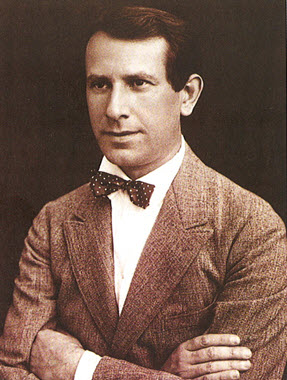
Leo Sirota (1885-1965), outstanding Ukrainian-born pianist and teacher, studied in St. Petersburg with Alexander Glazounov and later in Berlin with Ferruccio Busoni. Sirota played Busoni's massive Concerto under the composer's baton and soon established a firm reputation in the major cities of Europe. He also performed in Soviet Russia. Following a trip to Japan in 1928, Sirota was offered the directorship of the Ueno Imperial Academy in Tokyo. The Sirota family settled in Japan and Leo was much sought-after as both recitalist and teacher. During this period Sirota made recordings for Japanese Columbia, including the first complete recording of Stravinsky's Three Scenes from Petrouchka. At the outbreak of the Second World War, Sirota was exiled to a village where he and his wife faced daily hardships and lived without a piano. After 1945 Sirota moved to the United States and became artist-in-residence at the St. Louis Institute of Music. He remained there for nearly 20 years, continuing his concert activity and making an extensive series of radio broadcasts. In 1963 Sirota returned to Japan for a series of concerts, where he was warmly acclaimed by that country's musical community and was reunited with several of his former pupils, such as Takahiro Sonoda.
SERIES DESCRIPTION
Series I- Subject Files
Series II- Performance Files
Series III- Correspondence
Series IV- Photographs
Series V- Miscellaneous
Series VI- Materials from the Estate of Edward Petsch (donated to IPAM in May 2003 by Kay Hilliard)
Jan Smeterlin Collection
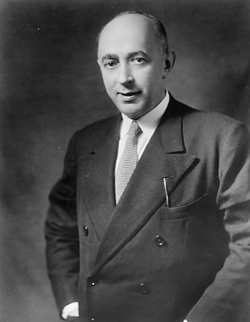 Jan Smeterlin, noted for his interpretations of Chopin's piano music, was born in Poland in 1892. He gave his first public concert at the age of seven playing a Mozart concerto. Despite Smeterlin's wishes to become a concert pianist, he was forced to study law. In the midst of his schooling in Vienna, Smeterlin won a scholarship to study with Leopold Godowsky, one of his most significant teachers. Smeterlin debuted as a performer in 1920, with concerts in Warsaw, Paris, Vienna and Berlin. His concert tours took him to the Netherlands, France, Switzerland, Germany, Denmark, Latin America, Java, New Zealand, Canada, Australia, the United States, and all over Europe, not to mention the annual concerts he gave in London, where he had settled.
Jan Smeterlin, noted for his interpretations of Chopin's piano music, was born in Poland in 1892. He gave his first public concert at the age of seven playing a Mozart concerto. Despite Smeterlin's wishes to become a concert pianist, he was forced to study law. In the midst of his schooling in Vienna, Smeterlin won a scholarship to study with Leopold Godowsky, one of his most significant teachers. Smeterlin debuted as a performer in 1920, with concerts in Warsaw, Paris, Vienna and Berlin. His concert tours took him to the Netherlands, France, Switzerland, Germany, Denmark, Latin America, Java, New Zealand, Canada, Australia, the United States, and all over Europe, not to mention the annual concerts he gave in London, where he had settled.
In 1910, Smeterlin began a unique relationship with composer Karol Szymanowski. He not only had the privilege of working with Szymanowski as a colleague, but also shared a friendship which was evident in Szymanowski's dedication of a volume of mazurkas to Smeterlin. Szymanowski's works were frequently included in his concerts and were often the highlight of his performances.
When not concertizing, Smeterlin enjoyed cooking. He authored a recipe book which was eventually published after his death. Smeterlin had also begun writing a book on the interpretation of Chopin which was he was unable to complete. He had a fondness for animals, especially his dog, Tuki-Tuki. During the last years of his life, Smeterlin and his wife, Didi, lived in New York. They returned to London for two months when he became ill; he died in 1967 at the age of seventy-five.
Smeterlin recorded mostly Chopin works. He recorded the complete Nocturnes for Philips, and various Waltzes and Mazurkas for Mace. A Chopin recital was recorded on LP for Allegro. Several 78s for Polydor were produced which contain Chopin's music and Schulz-Evler's arrangement of The Blue Danube. A Brahms recital was recorded for RCA Victor and Scripglen recorded works of Chopin and Szymanowski.
Joseph Smith Collection
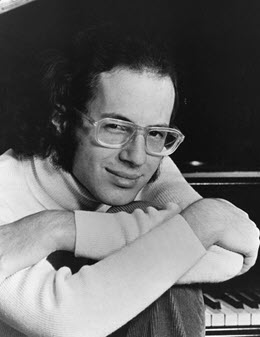
American pianist, author and lecturer Joseph Smith was born in New York City on July 4, 1948. His piano studies were with Olegna Fuschi and Seymour Bernstein. His November 5th, 1974 debut at Carnegie Hall was followed by nearly annual New York recitals at Carnegie and Alice Tully Halls and other venues. Smith’s recitals featured works from the standard repertoire together with lesser-known works by such composers as Louis Moreau Gottschalk, Percy Grainger, Charles Griffes, Seymour Bernstein, Harry T. Burleigh, and Duke Ellington. Smith’s writings about less familiar repertoire appeared regularly in the “Rare Finds” feature of Piano Today, and in his well-researched notes for his own recitals. His many articles on a range of topics can be found in other sources such as Clavier and Piano and Keyboard. Smith also recorded over a dozen albums and edited a similar number of performer editions of neglected repertoire. Among these publications are Piano Discoveries, Romancing the Piano, and Rare Finds for Piano. Joseph Smith combined his fascination for research and scholarship with his skill as a performer in frequent lecture-recitals. Joseph Smith died on March 23rd, 2015.
SERIES DESCRIPTION
Series I – Recordings
- Open Reel Tapes
- Cassette Tapes
- Compact Discs
Series II – Programs and Reviews
Series III – Publications, Scholarship and Contracts
Series IV – Publicity
- Flyers
- Resumes
- Posters
Series V – Recording Files
- Publicity
- Memorabilia
- Reviews
- Contracts
Series VI – Correspondence
Series VII – Photographs
Series VIII – Scores
Series IX – Books, Book Excerpts
Series X – Miscellaneous
Claudette Sorel Collection
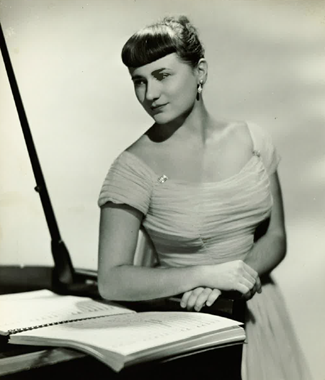
Claudette Sorel was born in Paris of French-Hungarian parentage and was trained in the U.S. by Olga Samaroff, Rudolf Serkin and Mieczyslaw Horszowski. At the age of ten, she made her Town Hall debut in New York and, the following year, performed with the New York Philharmonic. Sorel was a graduate of the Juilliard School, the Curtis Institute and Columbia University. Sorel made more than 2000 concert, recital and festival appearances, playing with 200 major orchestras. Her programs included premieres of music by Lukas Foss, Peter Mennin, Paul Creston and Harold Morris. She held professorships at the University of Kansas, Ohio State University and the State University of New York (Fredonia), where she was chairperson of the piano department for 13 years. Sorel died in 1999.
The Sorel collection contains a small performance file, considerable material relating to Sorel's teaching activity, and some manuscripts of compositions written for her.
SERIES DESCRIPTION
Series I: Performance Files
Series II: Subject Files, Correspondence
Series III: Writings and Other Papers; Fredonia; Mu Phi Epsilon
Series IV: Photographs
Series V: Scores and Books
Series VI: Unpublished Manuscript of Olga Samaroff Writings (Edited by Sorel)
Stecher and Horowitz Collection
In 1951 Melvin Stecher and Norman Horowitz became Stecher and Horowitz, one of the world’s leading duo piano teams. Their internationally acclaimed concert tours, spanning over five decades, and featuring a remarkable variety of new music and traditional masterpieces, have been instrumental in sparking renewed interest in two-piano concerts. Travelling with two Steinway grands, they have performed with overwhelming success both in recital and as soloists with orchestras in the United States, Canada, Central and South America, Europe, Israel, Japan and Australia. Several new works have been written for them, including the Concerto for Two Pianos, by the distinguished American composer Walter Piston, which was premiered by Stecher and Horowitz at the Dartmouth Congregation of the Arts in 1964.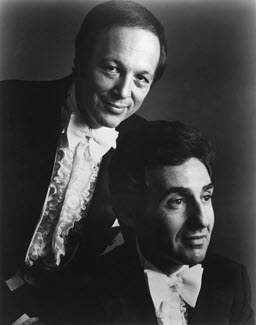
Still in their teens, the two New York-born pianists Melvin Stecher and Norman Horowitz had already made impressive solo debuts prior to forming their duo-piano team. Making their first appearances on the major hotel circuit, they became the first duo-piano attraction to be engaged at the Radio City Music Hall, where they played a record 84 performances. For the following five consecutive years, they toured the US and Canada playing 50 solo recitals and 60 concerts as guests artists with the Roger Wagner Chorale. Throughout their performing career, Stecher and Horowitz appeared in concert in as many as 100 or more cities annually. In 1968, their debut tour of Europe was a sensation. With concerts in Salzburg, Munich, Berlin, London, Copenhagen, Brussels, Stockholm and Amsterdam, the superb artistry of the two-piano team was rapturously received by audiences and lavishly praised by critics who compared them to the legendary duo-piano team of Busoni and Petri. As the leading Berlin newspaper Der Tagesspiegel phrased it: “For the fans of the piano it was a feast, an ensemble such as is hardly achieved in Old Europe these days.” Their recordings of duo-piano works by Brahms, Chopin and Milhaud were issued on Advance Records.
Commensurate with their concert activities, Stecher and Horowitz are prolific educators. In 1960 they founded the Stecher and Horowitz School of the Arts in Cedarhurst, NY, a highly regarded center for the encouragement of creative potential through its innovative learning programs until 1999. Since 2002, the Foundation has presented the New York International Piano Competition in New York City, a biennial event open to pianists ages 16–22. The NYIPC includes educational seminars, master classes, coaching, ensemble playing, and performances. A first in the world of competitions, no contestant is eliminated during the competition’s four rounds. The Foundation also presents a cash award to each of the contestants not receiving a major prize. The centerpiece of the New York International Piano Competition, a program that carries over into the Foundation’s Young Artists Series, is the commissioning of new works. For young pianists, the privilege of working side by side with a living composer allows for a dialogue rarely afforded a classical musician.
In addition to serving as educational consultants for the publishing firm G. Schirmer, they have written and edited the Stecher and Horowitz Piano Library, a comprehensive teaching series ranging from material for beginning students to the college text Keyboard Strategies.
Melvin Stecher and Norman Horowitz have been honored twice by the Music Teachers National Association (MTNA) for "Distinguished Service to America". These occurred in 1988, at the MTNA National Convention in Salt Lake City, Utah, where they were also the Convention Artists, and in 2012, at the National Convention in New York City. There, they received the MTNA Award for Leadership: a special recognition given only at special times to recognize significant and lasting contributions to MTNA, music teachers, and the music teaching profession; and only the third recipients in the 136-year history of MTNA.
Stecher and Horowitz have established the MTNA-STECHER AND HOROWITZ TWO PIANO COMPETITION, (ages 19-29) and the POWER OF INNOVATION AWARD (ages 35 and under). These two significant prizes emanate from the diversified career of the duo-pianists. They have created several additional prizes with the MTNA as well, including the Stecher and Horowitz-MTNA $25,000 Gateway Prize for Advancement in the Arts.
In 2016, Stecher and Horowitz were initiated into SAI as “National Arts Associates”. This is the highest honor Sigma Alpha Iota bestows to a man or woman who is nationally recognized for distinguished contribution to the arts. In all these endeavors, the virtuosity and versatility of Stecher and Horowitz have earned them an unrivaled reputation and the greatest respect in the music world.
More information on Stecher and Horowitz can be found here, on Facebook, and on YouTube.
SERIES DESCRIPTION
The Stecher and Horowitz Collection consists of files encompassing a comprehensive documentation of their performing career. Included are programs, articles, reviews, publicity, itineraries and other related material. In addition, the collection contains extensive files relating to the Stecher and Horowitz School of the Arts, the New York International Piano Competition, and the Young Artists Series. Significant files belonging to William Spielter--brother of Hedy Spielter, Stecher's piano teacher--are also included.
Box 1: Stecher and Horowitz Solo Careers and Concert Materials 1951-1957
Contains a focus on Stecher and Horowitz’s pre-duo careers, the Roger Wagner Choir tour, and Radio City performances. Folders are organized into programs, reviews, publicity, itinerary, contracts, and miscellaneous. Publicity folders include concert announcements, advertisements, and articles about the pianists. Miscellaneous folders contain items like receipts, laundry lists, vehicle registrations, insurance documents, truck repair documentation, etc. Itinerary folders contain recital schedules, tour schedules, hotel information, etc.
Box 2: Concert Materials 1958-1967
Includes a focus on materials relating to the premiere of Walter Piston’s Concerto for Two Pianos. Folders are organized into programs, reviews, publicity, itinerary, contracts, miscellaneous, correspondence with Walter Piston, Piston Concerto correspondence, Piston premiere photos, and Piston miscellaneous. Publicity folders include concert announcements, advertisements, and articles about the pianists. Miscellaneous folders contain items like receipts, laundry lists, vehicle registrations, insurance documents, truck repair documentation, etc. Itinerary folders contain recital schedules, tour schedules, hotel information, etc. A large envelope of handwritten letters from Walter Piston himself, as well as correspondence with others surrounding the concerto, is included. The Piston miscellaneous folder includes programs, magazines, write-ups, etc.
Box 3: Concert Materials 1967-1977
Includes a focus on European tours. Folders are organized into programs, reviews, publicity, itinerary, contracts, and miscellaneous. Publicity folders include concert announcements, advertisements, and articles about the pianists. Miscellaneous folders contain items like receipts, vehicle registrations, insurance documents, truck repair documentation, etc. Itinerary folders contain recital schedules, tour schedules, hotel information, etc.
Box 4: Concert Materials 1977-2003, Correspondence
Folders are organized into programs, reviews, publicity, concert press book materials, letters from music personalities, letters of appreciation, letters from various concert management entities and individuals, international tour and recording dates, itinerary, contracts, and miscellaneous. Concert materials collected for Stecher and Horowitz’ book and the various correspondence are of special interest. Publicity folders include concert announcements, advertisements, and articles about the pianists and the school. Miscellaneous folders contain things like receipts, vehicle registrations, insurance documents, truck repair documentation, etc. Itinerary folders contain recital schedules, tour schedules, hotel information, etc.
Box 5: Stecher and Horowitz School of the Arts Materials 1963-1995, Young Artists Series Materials
Folders are organized into publicity, concert brochures, student recital programs, orchestra concert programs, morning series flyers, ensemble players program flyers, fundraising brochures, S&H school annual fundraising materials, S&H school benefit concerts performed by Stecher and Horowitz, S&H school building fund, S&H school musical notes for majors and minors, S&H school t-shirt and pin, photos, trees for the preservation of the arts acknowledgments, galas honoring the directors, and Young Artists Series programs, publicity, and reviews. Brochure folders contain concert announcements and advertisements for various events that took place at the school or in association with the school. The gala-centered folders contain programs, invitations, and large booklets from the events. Fundraising folders include pamphlets and brochures used to raise funds for the foundation. Photograph folders include excellent photos relating to the school from the 1960s-1990s, as well as photos from the Morning Series and the Summer Festival. The photographs are labeled on the back. The building fund folder includes formal documents and a brochure detailing the proposed expansions. The musical notes folder includes newsletters sent out to students at the S&H school.
Box 6: Stecher and Horowitz Foundation Materials, NYIPC, MTNA, Publishing, Photographs, and Other
Folders are organized into S&H foundation fundraising, S&H foundation galas, American public television, New York International Piano Competition (NYIPC) documentaries, press, and publicity, MTNA two piano competition and journals, S&H publishing catalogues and magazine advertising, S&H publishing with G. Schirmer and with Schmitt, Hall, and McCreary, first drafts of Learning to Play, publishing workshops, publishing workshop publicity and itineraries, publishing photos, truck for touring photos, concert photos, photos for publicity, and miscellaneous photos. Materials filed under "other" include items from Steinway and Sons, such as a letter detailing the terms of the touring piano agreement. Fundraising folders contain materials used to advertise and obtain donations, like brochures and mailers. The gala folder contains programs, invitations, and large booklets from the event. MTNA journals in which S&H, their school, or their foundation are mentioned are included in the “MTNA journals” folder. Publishing folders focus on the pedagogical materials written by S&H. Beautifully handwritten drafts of teaching materials are included. Publishing workshop folders focus on S&H teaching workshops that utilize their own method books. The international workshops folder features mainly programs, itineraries, and writings from pedagogical workshops given in Japan and Australia.
Box 7: Scores and Magazines
Contains scores from the Stecher and Horowitz Piano Library and the New York International Piano Competition (NYIPC), as well as magazines that feature S&H. The NYIPC commissions a new work each year that all participants must perform; the pieces from 2006-2018 are included here. Folders are organized into NYIPC commissioned pieces, S&H scores, and smaller magazines.
Box 8: Audiovisual Materials
Contains records, CDs, Stecher and Horowitz’s book, and a thumb drive back-up of the Stecher and Horowitz Piano library.
Boxes 9-18: William Spielter Materials
Contains papers, scores, artwork, and memorabilia relating to William Spielter and his family: Hermann (father), Josephine (mother), and Hedy (sister). Hedy Spielter was Melvin Stecher’s primary teacher, and Norman Horowitz joined her studio towards the end of his piano study. William Spielter was a composer, arranger, writer, and gifted artist/illustrator; he is known today mainly as an arranger for Hollywood, but his output is significantly more varied. Dozens of handwritten scores, scripts, and book drafts by William are included, as well as folders filled with beautiful drawings and sketches. Spielter’s materials are divided into sections including work for Hollywood, musical dramas/artwork/books, transcriptions, memorabilia, and other scores.
On The Shelves: Posters, Awards, Certificates
Grete Sultan Collection
Johanna Margarete Sultan (Grete Sultan) was born in Berlin, Germany on June 21, 1906. Her musical family included two aunts who had studied with Clara Schumann, and important musicians such as Richard Strauss, Artur Schnabel and Ferruccio Busoni were regular visitors to her childhood home. Her piano studies were at the Berlin Hochschule für Musik with Leonid Kreutzer, and she later studied privately with Edwin Fischer.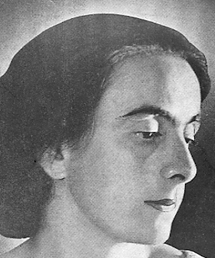
Sultan's early concert career was greatly curtailed by Adolf Hitler's prohibitions against Jewish musicians. Through her childhood acquaintance Richard Buhlig, she was able to escape to the United States in 1941. Buhlig had also introduced her to the composer Henry Cowell, and Sultan was to continue to be an advocate of contemporary music throughout her life.
Sultan held teaching positions at Vassar College, the 92nd Street Y in New York, and at the Masters' School in Dobbs Ferry, NY.
Sultan was closely identified with the composer John Cage, whom she also met through Richard Buhlig in 1945. Cage's Etudes Australes were written for her, and she promoted music by other contemporary such as Earle Brown, Stefan Wolpe, Alan Hovhaness, Ben Weber and Christian Wolff. Sultan was also acclaimed as a Bach player, particularly in the Goldberg Variations, which she performed throughout her life. Grete Sultan died in New York on June 26, 2005.
IPAM's Sultan Collection contains various concert programs documenting her repertoire and performing activity, as well as materials relating to John Cage and his piano works.
Margaret Leng Tan Collection
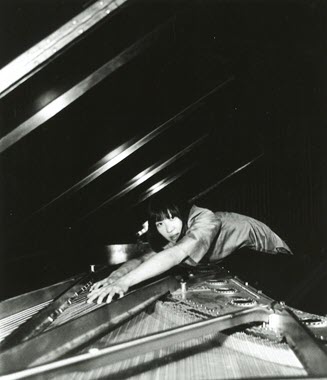
Margaret Leng Tan, referred to as "a diva of avant-garde pianism" by the New Yorker, is renowned for pushing the parameters of conventional piano. Her work with with the toy piano is particularly notable and has brought her much acclaim. Her first toy piano performance was in 1993 (performing John Cage's "Suite for Toy Piano") and has led other composers to add to the now-broadening repertoire of toy piano compositions. Born in Singapore, Tan now resides in Brooklyn when she is not touring internationally. Tan is also the first woman to graduate with a doctorate in music from the Juilliard School.
A discography and other information on Tan can be found at:
margaretlengtan.com
Balint Vazsonyi Collection
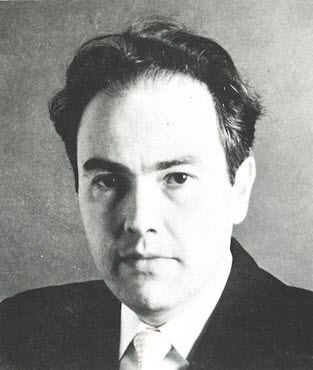
Balint Vazsonyi was born in Budapest, Hungary on March 7, 1936. He began his piano studies early at the Liszt Music Academy and the Vienna Academy of Music. Later, he immigrated to the U.S. and continued his studies under Ernst von Dohnanyi at Florida State University. Vazsonyi has toured the U.S. and Europe, as well as making numerous television and radio appearances. His recordings were issued on the Vox, Pye, and Genesis labels. Vazsonyi was also deeply interested in political science and wrote extensively on that subject for The Washington Times and elsewhere. He died in January 2003.
A separate, highly significant portion of the Vazsonyi Collection consists of materials that he gathered relating to the life and career of his teacher, Dohnanyi. Many of these unique documents, the majority in the Hungarian language, were used by Vazsonyi while preparing his biography of Dohnanyi.
Diane Walsh Collection
Diane Walsh is an American pianist, born in Washington D.C. She enjoys a varied career, acting as soloist, recording artist, chamber musician, educator, and even on Broadway—she joined the cast of Moisés Kaufman's play, 33 Variations, during which she performed Beethoven’s Diabelli Variations 113 times. 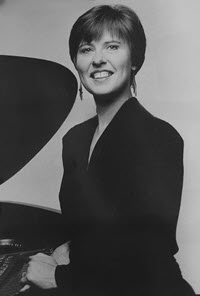 Walsh, a Steinway artist, has won top prizes at the Munich, Salzburg Mozart, Young Concert Artists, and Concert Artists Guild international competitions; she has also claimed awards at the Cliburn, Busoni, and Kapell competitions. Walsh has performed widely, playing in nearly every state and 23 countries worldwide. She has worked with important conductors such as David Zinman and Seiji Ozawa, and has now released 19 records across 11 different labels, featuring a broad range of repertoire. In reviews, Walsh has been hailed for her sensitivity, thoughtful interpretation, technical strength, and command of tone.
Walsh, a Steinway artist, has won top prizes at the Munich, Salzburg Mozart, Young Concert Artists, and Concert Artists Guild international competitions; she has also claimed awards at the Cliburn, Busoni, and Kapell competitions. Walsh has performed widely, playing in nearly every state and 23 countries worldwide. She has worked with important conductors such as David Zinman and Seiji Ozawa, and has now released 19 records across 11 different labels, featuring a broad range of repertoire. In reviews, Walsh has been hailed for her sensitivity, thoughtful interpretation, technical strength, and command of tone.
Walsh holds degrees from the Juilliard School of Music and Mannes College. She taught at Mannes College for over 30 years and has held teaching positions at Vassar and Colby Colleges as well. Walsh also acted as artistic director of the Skaneateles Festival for five years. She most recently served as Artist-in-Residence at the Portland Conservatory of Music in Maine, from 2023-2025.
SERIES DESCRIPTION
Series I- Audiovisual Materials
Series II- Performance Files
Series III- Subject Files
Series IV- Oversized Materials
Beveridge Webster Collection
Born in Pittsburgh, Pennsylvania on May 13, 1908, Beveridge Webster commenced piano studies at the age of five with his father, the founder and director of the Pittsburgh Conservatory of Music (est. 1893). Webster's brother Ferguson and his sister Elizabeth also received musical training from their father. In 1921 Beveridge Webster, Sr. sold the conservatory and the whole family moved to Paris. There Beveridge Jr., as well as Ferguson and Elizabeth, continued their musical education at the Paris Conservatory with the renowned pedagogue, Isidor Philipp. Webster went on to take the Premier Prix in piano, the first and only American to win that coveted Conservatory award. He also studied with Nadia Boulanger and Robert Casadesus at the American School at Fontainebleau, where he won first prize in 1922. He began concertizing extensively in Paris and throughout Europe in the 1920s and 1930s. During the early 1930s, he also spent several years studying with Artur Schnabel in Berlin.
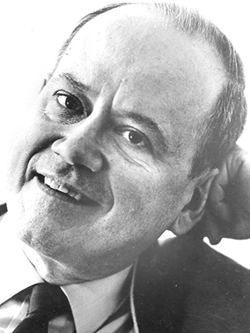 During the Paris years, Webster's empathy for French impressionism was cultivated by his friendships with Maurice Ravel and Jacques Durand, Debussy's publisher and confidante. Webster was a close associate of Ravel and appeared frequently on the same concerts (they often turned pages for one another in chamber music recitals). In 1924, when Webster was only sixteen, he gave the world premiere of Ravel's Tzigane (with violinist Samuel Dushkin) in Paris. Webster was a frequent performer at the musical soirees given by the Durands, as well as those given by the opera diva Nellie Melba. It was in Paris that Webster began to teach; among his students were Hephzibah and Yaltah Menuhin. Webster also was a close associate of Igor Stravinsky, appearing with him on several occasions when Stravinsky conducted his own works.
During the Paris years, Webster's empathy for French impressionism was cultivated by his friendships with Maurice Ravel and Jacques Durand, Debussy's publisher and confidante. Webster was a close associate of Ravel and appeared frequently on the same concerts (they often turned pages for one another in chamber music recitals). In 1924, when Webster was only sixteen, he gave the world premiere of Ravel's Tzigane (with violinist Samuel Dushkin) in Paris. Webster was a frequent performer at the musical soirees given by the Durands, as well as those given by the opera diva Nellie Melba. It was in Paris that Webster began to teach; among his students were Hephzibah and Yaltah Menuhin. Webster also was a close associate of Igor Stravinsky, appearing with him on several occasions when Stravinsky conducted his own works.
On November 11, 1934 Webster made his U.S. debut with the New York Philharmonic, playing the MacDowell Second Piano Concerto. His recital debut at Carnegie Hall in New York City was a mere three weeks later, on November 30. He subsequently appeared with most of the major American orchestras and was greatly in demand as a solo recitalist and chamber music player (with quartets including the Kolisch, Curtis, Juilliard, Pro Arte, Fine Arts, Musical Art, Gordon, Lenox, Netherlands, Berkshire, Concord, Gramercy, Galimir, Capet, and Cremona) throughout North America. His repertory is diverse and wide-ranging, extending from Bach and Beethoven to Twentieth-century avant-garde. He is best known, however, as a champion of modern American composers and for his interpretations of Debussy and Ravel. He has given premieres (as well as made first recordings) of the works of numerous American contemporaries such as Elliott Carter, Roger Sessions, William Schuman, Louise Talma, Robert Helps and David Diamond.
In addition to American music, Webster has also made first-time recordings of works of other Twentieth-century composers such as Alban Berg, Arnold Schoenberg, and Stravinsky. (The labels he has recorded on are MGM, Dover, Columbia, Desto, and Heliodor.) For the fiftieth anniversary of Debussy's death (1968) Webster performed Debussy's complete piano works in a three-recital series in a number of cities, including New York, Chicago. Webster's recordings of the complete Debussy piano works are still considered to be among the finest interpretations.
Webster's performing and teaching careers continued simultaneously. From 1940 to 1946, he taught at the New England Conservatory. In 1946, he joined the faculty of the Juilliard School where he remained until his retirement in October 1990. From 1961 to 1970 he was a performing artist and faculty member at the Aspen Music Festival and School. He was also professor-in-residence at Herbert Lehman College in 1973, and has been a visiting professor at leading colleges, universities, and conservatories throughout the country. A list (not complete) of his students can be found in the Student Files. Some of his students include Paul Jacobs, Michel Block, and three performer/teachers now in the Washington area, Thomas Schumacher (University of Maryland), Thomas Mastroianni (Catholic University) and Raymond Jackson (Howard University).
Webster has served on juries for numerous piano competitions: the Kennedy-Rockefeller Foundations' International Piano Competition, 1978 (jury chairman); University of Maryland Piano Competition, 1980; first Tokyo International Piano Competition, 1980; Robert Casadesus International Piano Competition, Cleveland, 1981; the Warsaw, Mitropoulos, Van Cliburn, Naumburg, Leeds, Munich, and Bach international piano competitions, as well as the Paris Conservatory and the WQXR Young Artists Competitions. He has also been a member of various composition juries, such as the International Society of Contemporary Music (ISCM), the League of Composers, American Broadcast Alliance, and the Pulitzer Prize.
Webster has received various awards and honorary degrees, among them an award for outstanding services to American music from the National Association of American Composers and Conductors, 1959; membership in the National Society of Literature and Arts, 1975; and honorary doctorates from the University of New Hampshire, 1962, and Baldwin Wallace College, 1969.
In 1940, Webster married Frances Brown, a singer, pianist and cellist. Frances holds degrees in music from Oberlin and Radcliffe and has studied with Nadia Boulanger. She has given numerous song recitals, many with Webster as accompanist. For nine years, she was principal cellist with the Westchester (New York) Symphony. The Webster children, Michael and Wendy, first commenced piano studies with their mother. Michael is a clarinetist, conductor, composer, and arranger. He has been the principal clarinetist with the Rochester Philharmonic and the San Francisco Symphony, as well as soloist with various orchestras and performer with numerous chamber music groups and festivals. After musical studies at Oberlin, Aspen, and the Longy School of Music (eurhythmics) and graduate work in early childhood education at Tufts University, Wendy founded the Joy of Music Program (in 1986) in Worcester, Massachusetts. She continues on as teacher/director of this unique community music school for children aged two to twelve.
SERIES DESCRIPTION
Series I - Performance Files
All aspects of BW's more than 550 concert appearances are documented in this series.
Contained in Boxes 1 to 8, Series I covers the years 1916 to 1990 and undated material. Series I is further divided into three subseries:
- Performance files
- Repertoire and performance lists
- Calendars
Subseries I-A is arranged chronologically by date of performance, each folder containing all documents pertaining to a particular performance, e.g., programs, reviews, press clippings, publicity material., etc.
Subseries I-B comprises two folders, one containing various repertoire lists and sample programs, the other containing lists of concert appearances.
Subseries I-C is composed of engagement books, daily reminders, bound calendars, etc. for the years 1941 to 1979, 1981, and 1983 to 1989. The items are arranged chronologically.
Series II - Correspondence
Correspondence is contained in Boxes 14 to 18. This series is divided into four subseries:
- General correspondence
- Letters written by BW
- Family correspondence
- Student correspondence
Subseries II-A comprises letters from colleagues, friends, and business associates and is arranged alphabetically. Notable individuals in this subseries have been filed in separate folders; indicated are date and type of communication, e.g., ALS.
Subseries II-B comprises letters from BW to colleagues, friends, business associates, and family members. This subseries is arranged alphabetically, by individual; indicated are date and type of communication, e.g., ALS.
Subseries II-C consists of letters and cards from members of the Webster family. The arrangement is by individual, in terms of family relationships; indicated in square brackets is the individual's relationship to BW. Also indicated are date and type of communication, e.g., ALS.
Subseries II-D includes letters and cards from students' parents and friends, as well as correspondence from BW students. This subseries is arranged alphabetically by student.; indicated are date and type of communication, e.g., ALS. Letters, notes, and other communications from students relating to BW's 80th birthday celebration (May 1, 1988) are located in Series VII: BW Student Files.
Series III - Photographs and Artwork
Series III consists of formal, candid, and publicity photographs, snapshots, and artwork of Beveridge Webster and family, friends, colleagues, students, and others. It is contained in Boxes 19 to 21. This series is divided into five subseries:
- BW alone
- BW with colleagues and fellow artists
- BW and family
- BW students others
Subseries III-A and III-C are arranged chronologically; Subseries III-B, III-D and III-E are arranged alphabetically. An asterisk (*) indicates photographs with inscriptions. The name of the photographer, if available, is indicated at the end of the entry. If there is more than one item in a folder, the number of items are indicated in parentheses at the end of the entry.
Series IV - Recordings
Series IV consists of 5", 7", and 12" reel-to-reel tape recordings, some cassette recordings, a series of 7" reel-to-reel tapes recorded by engineer Jerry Newman (dates unknown), a series of tape recordings made at the Aspen Music. Festival, and tape recordings of performances by Beveridge Webster's students. There is also a list of LP recordings, acetates, and test pressings found in the collection, as well as one video cassette recording of "Camera 3" from [1982?]
Series V - Legal Documents
Series V consists of birth certificates, passports, BW's marriage certificate, faculty IDs, contracts and agreements with American Artists Management, Inc., and other miscellaneous legal documents.
Series VI - Awards and Certificates
Series VI consists of merit awards, honorary doctoral degrees, and other types of awards and certificates from various civic and music organizations. Perhaps most notable is a 1926 Premier Prix de Piano awarded by the Conservatoire National de Musique et de Declamation.
Series VII - Student Files
This series consists of programs, articles, press reviews and clippings, drawings, writings, and other material (except correspondence and photographs) that relate to Beveridge Webster's students. It is contained in Boxes 22?23 and Box 8. The arrangement is alphabetical, by name of student, with all items pertaining to a student in one folder. Performances, indicated first within each folder, are arranged in chronological, order, along with pertinent press material and reviews. The last three folders contain, respectively, computer printouts of Juilliard allumni (piano majors with addresses in NY, NJ and CT), various lists of Btd students, and responses to the form letter/ questionnaire sent out by Michael Webster to BW students for the occasion of BW's 80th birthday celebration (May 1, 1988). These responses contain numerous notes and letters - either written on the back of the questionnaire or attached to it - from BW students. An alphabetical list of BW students (incomplete) precedes the inventory. Bracketed question marks after the surname signify uncertain spelling; bracketed question marks after the entire entry signify uncertainty of student status.
Series VIII - Music Scores
This series consists of a large number of published scores, some with extensive rehearsal and performance markings. There are also manuscript copies of scores and some photocopies of manuscripts. There is a series of scores by the American composer Elliott Carter that contain extensive fingerings, rehearsal markings, and other performance markings, as well as pencil markings and corrections by the composer. Beveridge Webster worked very closely with Elliott Carter on some of these scores.
Series IX - Writings by and About Beveridge Webster
This series consists of two major sections: Section A consists of articles, both published and unpublished, written by Beveridge Webster on various musical Topics. There are some clippings, handwritten speeches, lectures, notes about Performances, repertory lists, and more. Section B contains writings and biographical articles about Beveridge Webster. Most of the materials in this section consist of reviews of BW performances.
Series X - Publicity flyers, Press Releases
This series consists of general flyers for BW throughout his career, promotional flyers featuring quotes by Copland, Carter, and Sessions, and other flyers promoting specific concerts. There are also press releases of BW's London recitals included in this series.
Series XI - Press Clippings
This series consists of press clippings of a general nature and clippings that are record reviews. The general newspaper clippings are about various aspects of BWs career, advertisements for Baldwin pianos, articles on the Isidor Phillips archive, and articles about the Webster family, as well as other miscellaneous topics. The second section contains record reviews, some in photocopy, of BW recordings of Stravinsky, Rachmaninoff, Debussy, Beethoven, Berg, Schoenberg, Webern, Carter, Copland, Sessions, and Schubert.
Series XII - BW as Piano Competition Jurist
This series contains materials related to Beveridge Websters participation is a piano competition jurist. Here are found jury student lists, scores, lists of judges, and a collection of materials from the 1960 Chopin Competition that included BW, Nadia Boulanger, M. Horszowski, D. Kabalevski, and others as judges.
Series XIII - Workbooks from Study with Father
This series consists of materials related to music study that Beveridge Webster did with his father, Beveridge Webster, Sr. Here are found music books that contain theory exercises, written explanations of aspects of performing, interval drills, polyphony exercises, notes from piano lessons, written and printed piano programs given by BW as a child, transcriptions, and BW compositions (sketches).
Series XIV - Juilliard Files
This series consists of materials related to Beveridge Webster's tenure at The Juilliard School of Music.
Series XV - Family
Series XV contains two sections: Section A contains materials related to information about the Webster family. Section B consists of information about BW's son Michael Webster and his family.
Series XVI - Subject Files
Series XVII - Miscellaneous
Series XVIII - Books from BW's Library
This series contains books found in BW's library. Most of the books are about music and the arts.
Jean and Kenneth Wentworth Collection
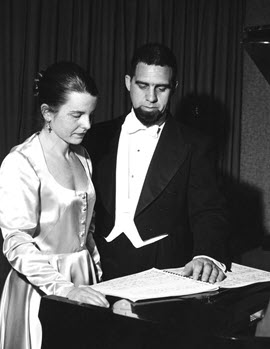 Jean and Kenneth Wentworth came from Chicago and Maine respectively to complete their musical education at the Juilliard School of Music, where they studied piano with Irwin Freundlich. The two married in 1949. Jean Wentworth appeared as a recitalist at Town Hall, Carnegie Hall, Kaufmann Auditorium and other venues throughout her career after winning the Walter M. Naumburg Award in 1954. Kenneth Wentworth maintained a career as a pianist, teacher, conductor, lecturer and artistic director at Sarah Lawrence College, where both Wentworths held faculty positions.
Jean and Kenneth Wentworth came from Chicago and Maine respectively to complete their musical education at the Juilliard School of Music, where they studied piano with Irwin Freundlich. The two married in 1949. Jean Wentworth appeared as a recitalist at Town Hall, Carnegie Hall, Kaufmann Auditorium and other venues throughout her career after winning the Walter M. Naumburg Award in 1954. Kenneth Wentworth maintained a career as a pianist, teacher, conductor, lecturer and artistic director at Sarah Lawrence College, where both Wentworths held faculty positions.
A Fulbright grant in 1964 brought the Wentworths to India where Kenneth Wentworth was a lecturer at the Calcutta School of Music and the University of Calcutta, and where the two played duo recitals in India and subsequently throughout the Middle East. The Wentworths gave Carnegie and Wigmore Hall recitals, toured Europe, and presented numerous concerts at Sarah Lawrence College.
As a duo piano team, the Wentworths focused primarily on repertoire for one piano, four hands, and their careers spanned nearly six decades. The Wentworths were devoted to standard repertoire and were also strong advocates of contemporary four hand music, introducing works by composers such as Robert Starer, André Singer, Lawrence Moss, William Sydeman, Vincent Persichetti and Charles Wuorinen. Their recordings include Mozart’s complete works for piano four hands, the Czerny Concerto for piano four hands, and several contemporary works.
SERIES DESCRIPTION
Series I – Recordings
Series II – Scores
Series III – Photographs
Series IV – Performance Files
Series V – Biographical Files
Series VI – Correspondence
Series VII – Writings, Lectures, Courses
Series VIII - Miscellaneous
Earl Wild Collection
Virtuoso pianist Earl Wild was born in Pittsburgh in 1915 and was recognized as one of the last in a long line of pianist/composers. He began his studies at the age of three and was nurtured in the romantic traditions of piano playing through his studies with Scharwenka pupil Selmar Jansen, Busoni pupil Egon Petri and Ravel pupil Paul Doguereau. Wild’s musical personality was also significantly shaped by pianists he heard in his youth such as Sergei Rachmaninoff, Ignace Paderewski and Vladimir de Pachmann. Wild served as the pianist for the NBC Symphony Orchestra from 1937 to 1944 where he became the first American pianist to perform on television (1939) and the soloist for the only performance of Gershwin’s Rhapsody in Blue ever conducted by Arturo Toscanini (1942). Wild’s many performances of the Rhapsody in Blue and the Concerto in F earned him wide recognition as a Gershwin interpreter during the early portion of his career.
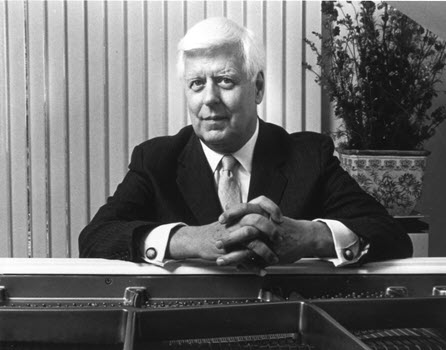 Wild made his New York debut at Town Hall in 1944 in a program that featured works by Haydn, Schumann, Rachmaninoff and Medtner. A subsequent Town Hall concert in 1954 and other concerts in the 1950s began to establish Wild as a sovereign interpreter of the music of Liszt. Wild’s identification with Liszt reached its pinnacle with a series of recitals given in 1986 in honor of the centenary of Liszt’s death. Wild’s triad of Liszt concerts, entitled “Liszt the Poet”, “Liszt the Transcriber” and “Liszt the Virtuoso” were given at Carnegie Hall as well as many other concert halls in the United States and abroad to critical acclaim. Wild’s recitals and appearances with orchestras were weighted heavily toward the romantic repertoire and he frequently performed All-Chopin or All-Liszt recitals. Wild also revived neglected concertos by Scharwenka and Paderewski, and he championed other lesser known romantic composers such as Medtner. Wild played a significant role in reviving the programming of piano transcriptions, a practice that had largely fallen out of favor in the middle 20th century. Wild’s November 1981 concert at Carnegie Hall called “The Art of Transcription” featured only transcriptions, including works transcribed by Liszt, Sgambati, Thalberg and Wild himself. Transcriptions appeared regularly on Wild’s programs, including his own highly effective virtuoso transcriptions of songs by Rachmaninoff and Gershwin. In addition to transcriptions, Wild also composed original works, including Revelations (1962), an Easter oratorio that was subsidized and premiered by ABC television, a set of variations for piano and orchestra on themes by Stephen Foster nick-named “Doo-Dah” Variations (1992) and a Piano Sonata (2000).
Wild made his New York debut at Town Hall in 1944 in a program that featured works by Haydn, Schumann, Rachmaninoff and Medtner. A subsequent Town Hall concert in 1954 and other concerts in the 1950s began to establish Wild as a sovereign interpreter of the music of Liszt. Wild’s identification with Liszt reached its pinnacle with a series of recitals given in 1986 in honor of the centenary of Liszt’s death. Wild’s triad of Liszt concerts, entitled “Liszt the Poet”, “Liszt the Transcriber” and “Liszt the Virtuoso” were given at Carnegie Hall as well as many other concert halls in the United States and abroad to critical acclaim. Wild’s recitals and appearances with orchestras were weighted heavily toward the romantic repertoire and he frequently performed All-Chopin or All-Liszt recitals. Wild also revived neglected concertos by Scharwenka and Paderewski, and he championed other lesser known romantic composers such as Medtner. Wild played a significant role in reviving the programming of piano transcriptions, a practice that had largely fallen out of favor in the middle 20th century. Wild’s November 1981 concert at Carnegie Hall called “The Art of Transcription” featured only transcriptions, including works transcribed by Liszt, Sgambati, Thalberg and Wild himself. Transcriptions appeared regularly on Wild’s programs, including his own highly effective virtuoso transcriptions of songs by Rachmaninoff and Gershwin. In addition to transcriptions, Wild also composed original works, including Revelations (1962), an Easter oratorio that was subsidized and premiered by ABC television, a set of variations for piano and orchestra on themes by Stephen Foster nick-named “Doo-Dah” Variations (1992) and a Piano Sonata (2000).
As a performer, Wild was praised for his virtuoso technique, which he maintained throughout a long concert career that continued until his 90th year, and for his flexible treatment of rhythm which hearkened back to the playing of “golden age” pianists. Earl Wild accumulated an extensive discography including recordings of over 30 concertos and 400 solo piano pieces. He won a Grammy award for “Best Instrumental Soloist Without Orchestra” (1997) for his CD recording “The Romantic Master”. As a teacher, Wild held positions at the Eastman School of Music, Pennsylvania State University, the Juilliard School of Music, the Manhattan School of Music, Ohio State University and Carnegie Mellon University. Earl Wild died on January 23rd, 2010. A Walk on the Wild Side, an extensive memoir by Earl Wild was published by the Ivory Classics Foundation in 2011.
Konrad Wolff Collection
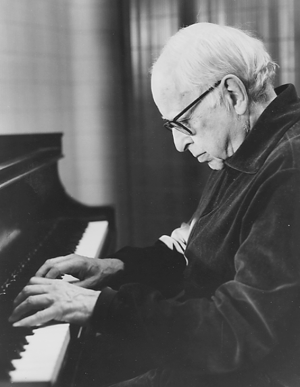 Konrad Wolff was born in Berlin, March 11, 1907 to a German father and British mother. He was educated in German schools until 1925. That same year he commenced studies at the University of Berlin and the University of Heidelberg, studies which continued until 1929. In 1930 he graduated Magna Cum Laude with the degree of Doctor of Law from Berlin University. In 1934-35 he studied at the Sorbonne in Paris and acquired the Diplomes d'etudes superieures. In 1936, Wolff married photographer/artist Ilse Bing and they moved to the United States in 1941. Wolff became an American citizen in 1946.
Konrad Wolff was born in Berlin, March 11, 1907 to a German father and British mother. He was educated in German schools until 1925. That same year he commenced studies at the University of Berlin and the University of Heidelberg, studies which continued until 1929. In 1930 he graduated Magna Cum Laude with the degree of Doctor of Law from Berlin University. In 1934-35 he studied at the Sorbonne in Paris and acquired the Diplomes d'etudes superieures. In 1936, Wolff married photographer/artist Ilse Bing and they moved to the United States in 1941. Wolff became an American citizen in 1946.
Wolff's pianistic education included private studies under Liszt pupil Joseph Lomba, Bruno Elsner and Artur Schnabel. He gave solo recitals in New York, Washington, Boston, London, Paris and Amsterdam in addition to frequent chamber music performances. In addition, Wolff performed many lecture-recitals for the Association of American Colleges and the University of Minnesota Lecture Bureau. Master classes included Smith College, New England Conservatory, University of the Pacific, and Bradley University. He was engaged for a residency at the University of Texas just before his death.
Wolff served on the piano faculties at Westchester Conservatory (1949-54), Drew University, NJ (1952-62), and Peabody Conservatory (1963-74), where he also taught chamber music, score analysis, and graduate piano literature.
Best known to the general world of music as champion of the artistry and teaching of Artur Schnabel, Wolff's impressive study of his teacher Schnabel's Interpretation of Piano Music (2nd edition. New York: W.W. Norton, 1979) is considered the ultimate authority. Other major books include Masters of the Keyboard (2nd edition. Bloomington: Indiana University Press, 1990) and Erich Itor Kahn (Paris 1958) on which he collaborated with Rene Leibowitz. Additional publications include an edition of Schumann's On Music and Musicians and many contributions to the Musical Quarterly, the Journal of the American Liszt Society, Piano Quarterly, and other periodicals.
Wolff died of heart failure October 23, 1989 in Cologne, Germany where he was performing and lecturing.
SERIES DESCRIPTION
Series I - Performance Files
Here are found programs and reviews related to specific performances by Konrad Wolff. The files are organized chronologically by performance date and span the period May 31, 1945 through November 17, 1989. This series is located in Boxes 1 - 3.
Series II - Writings
This series contains the bulk of the material in the Konrad Wolff collection. Included are published books and articles in addition to miscellaneous writings by KW. The material is located in Boxes 3 - 10 and is divided as follows:
A. Published Books - Box 3
B. Manuscripts of Published Books - Boxes 4 & 5
C. Various Writings - Boxes 6 - 8
D. Miscellaneous Writings - Boxes 8 & 9
- Various Notes - Box 8
- Notebooks - Box 9
- Theses - Box 10
Series III - Correspondence
This series, located in Boxes 11 and 12, comprises letters, divided into the following categories:
A. Letters to KW - Boxes 11 & 12
B. Letters from KW - Box 12
C. Condolence letters to Ilse Bing - Box 12
D. Miscellaneous Letters - Box 12
Series IV - Subject Files
Here are found various documents related to Konrad Wolff's personal and professional life. Located in Boxes 13 - 19, this series is divided into the following categories:
A. KW's Life - Boxes 13 & 14
B. KW as Juror and Educator - Boxes 15 & 16
C. Publishing of KW's Books - Box 17
D. Other People's Writings, Reviews, Publicities, etc - Box 18
E. Miscellaneous - Box 19
Series V - Music Compositions (Manuscripts)
This series, in Boxes 20 and 21, contains mostly manuscripts of KW's music compositions. They are organized into 2 large categories:
A. Laurie's Music Book - Box 20
Music by Konrad Wolff, compiled by Edna Dean McGray
B. Manuscripts - Box 21
I. Solo Piano Pieces
II. Ensemble Music
III. Exercises
IV. Miscellaneous Manuscript Pages
V. Other People's Compositions
VI. Music Notebooks
Ivan Wyschnedradsky Collection
Ivan Wyschnegradsky was born in 1893. He was a student of Nicholas Sokoloff at the St. Petersburg Conservatory. Wyschnegradsky made his home in Paris from 1920 until his death in 1979. He devoted most of his life to experimentation with quarter tones and other microtones and had a quarter tone piano built for his use in the 1930s. Later, he wrote for two to four pianos tuned to give the microtonal effects he desired.
SERIES DESCRIPTION
Series I - Written Materials
This series comprises books, journals, articles and analytical materials relating to Ivan Wyschnegradsky and microtonal composition.
Series II - Concert Programs of Microtonal Works
Series III - Correspondence
Series IV - Scores
This series contains scores of works by Wyschnegradsky (beginning with 101), Mildred Couper (beginning with 201) and Alan Hovhaness (301). The largest part of this series is comprised of different versions of Wyschnegradsky's Preludes, Op.22 (101) about which I.W. and John Dierks shared a lengthy correspondence (see Series III). In addition to the 1977 published score (A) of these pieces, the collection contains proofs (B) sent by C.F. Peters to J.D. preceding the work's publication, photocopies (C) of the unpublished (manuscript) preludes seny by I.W. to J.D. beginning in 1973, and photocopies (D,E, numbered) made by J.D. for study and performance. Unfortunately, it is not always clear which photocopies were made and sent by I.W. and which were made by J.D. (For example, it is not certain that all of the copies found in 101 (C) were made by I.W.)
Series V - Audio Materials
Yarbrough and Cowan Collection
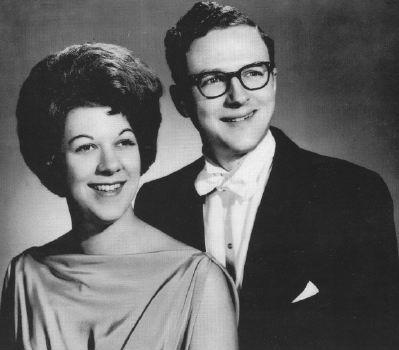 For over thirty years, Yarbrough & Cowan formed one of the world's leading husband and wife duo piano teams. They traveled with their two 7-foot Hamburg Steinways to many of their engagements throughout the U.S., Canada and Mexico. Additional concert tours took them to the Far East, Russia, Austria and Czechoslovakia.
For over thirty years, Yarbrough & Cowan formed one of the world's leading husband and wife duo piano teams. They traveled with their two 7-foot Hamburg Steinways to many of their engagements throughout the U.S., Canada and Mexico. Additional concert tours took them to the Far East, Russia, Austria and Czechoslovakia.
Joan Yarbrough received a B.M. Degree with honors from the Oberlin Conservatory of Music in 1960. She has also studied at the Salzburg Mozarteum, and the Royal Academy of Music in London, where she received the L.R.A.M in 1963 after studies with Franz Reizenstein.
Robert Cowan has studied with Joseph Raieff at Julliard (B.S. and M.S. Degrees), Cecile Genhart at the Eastman School of Music (D.M.A.), and with Harold Craxton as a Fulbright Scholar at the Royal Academy of Music (L.R.A.M.). Yarbrough and Cowan met in London in 1962 and were subsequently married. A busy concert career followed for them, with close to 300 concerts in the U.S., Europe and Mexico from 1964-1965. They have been duo-pianists-in-residence at the University of Montevallo in Montevallo, Alabama, and artist-faculty members at the Brevard Music Center in Brevard, North Carolina.
Yarbrough & Cowan commissioned and performed works for piano duo which include Wallingford Riegger's Variations for Two Pianos and Orchestra, Paul Creston's Concerto for Two Pianos and Orchestra, and Niels Viggo Bentzon's Symphonic Fantasy for Two Pianos and Orchestra. The Yarbrough & Cowan collection features extensive concert materials dating from 1964 to 1995 along with recordings of live performances.
SERIES DESCRIPTION
Series I - Performance Files
Series II - Correspondence/Subject Files
Series III - Recordings
Jascha Zayde Collection
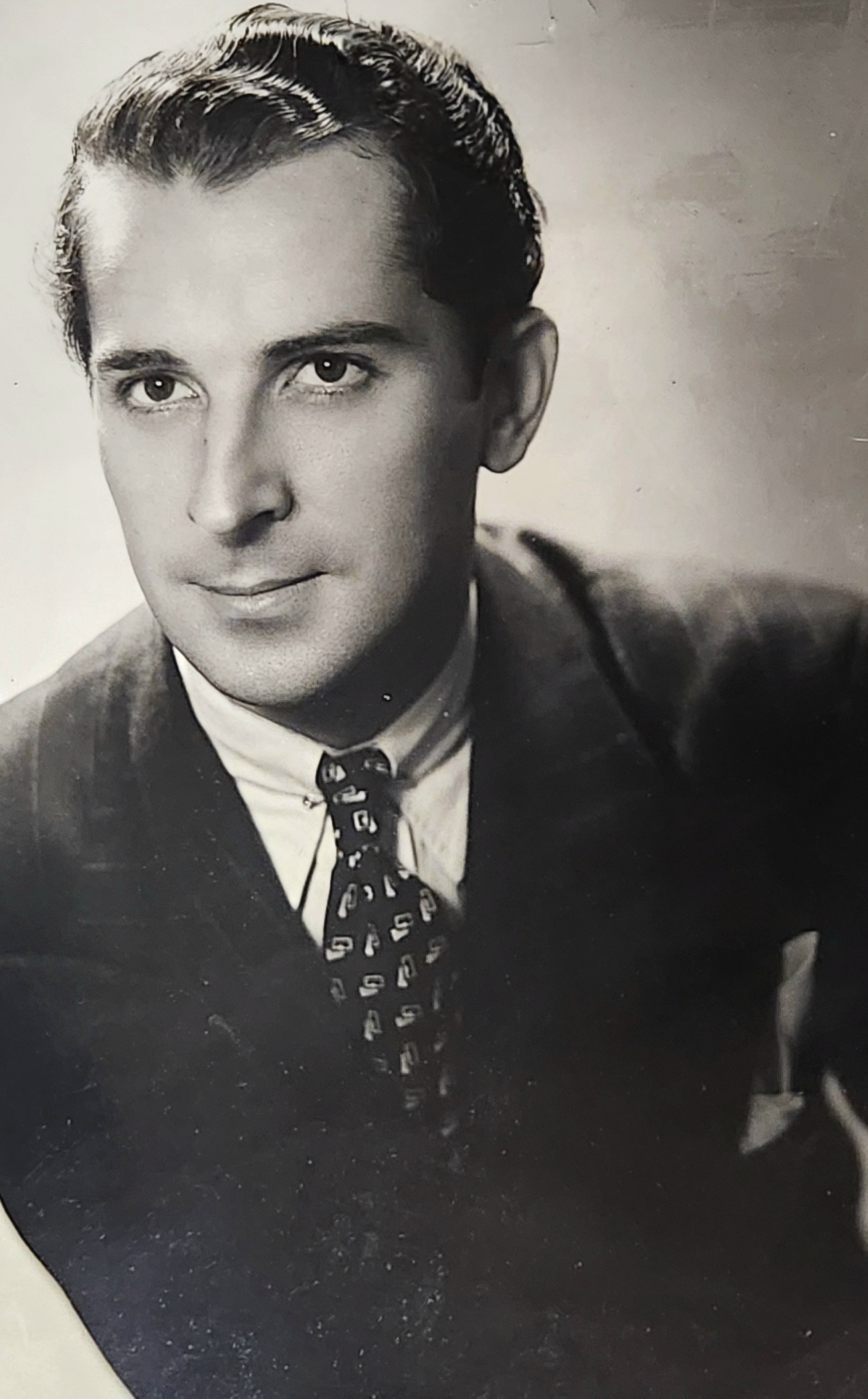
Jascha Zayde was a gifted pianist, composer, educator, and broadcaster. Zayde was born in Argentina in 1911 to Russian parents, moving to the United States when he was 6 months old. He began his piano studies at the age of 3, debuting publicly at 7. Zayde studied with Clarence Adler, and won a fellowship to the Juilliard School where he studied with Carl Friedberg, Rubin Goldmark, Bernard Wagenaar, and Michael Fevesky. He was the first hired musician at WQXR, beginning work shortly after the station began operations in 1936. Zayde ran a show called “Let’s Look at Music” for WQXR; he also performed weekly, first with Clifford Herzer and then with Leonid Hambro.
Zayde and Hambro were a successful duo, enjoying popularity both on the radio and on the concert stage. Their recording of Poulenc’s Sonata for Two Pianos is particularly highly regarded.
Zayde was also a composer, writing trios, string quartets, songs, transcriptions, and a set of variations on Paganini’s Caprice no. 24. Furthermore, Zayde was an accomplished ballet accompanist, serving as the pianist for the New York City Ballet for many years. He also conducted the premiere of several operas on Broadway, including “The Telephone” and “The Medium” by Gian Carlo Menotti.
The Jascha Zayde Collection at IPAM houses papers and recordings surrounding his time at WQXR, as well as recordings and scores from his personal collection.
SERIES DESCRIPTION
Series I- Scores
Includes works by Zayde and works by other composers. Scores are organized into works for piano solo, chamber works, ballet scores, and other.
Series II- WQXR Papers
Includes transcripts of Let's Look at Music with Jascha Zayde, notes and research materials for the show, timing sheets, index/filing cards from the station's programming, and miscellaneous materials.
Series III- Audio-Visual Materials
Includes cassette tapes, reel tapes, DATs, vinyl, and CDs, many of which are either recordings of WQXR shows or used in the production of WQXR shows; performances by Zayde are also included.
Specialized Collections and Miniature Collections
Caine Alder Collection
Caine Alder (1933-2012), a native of Salt Lake City, Utah, was among the major private American collectors of classical piano recordings and associated materials. During his lifetime he built an impressive collection that encompassed a broad range of pianistic history, with particular emphasis on such seminal figures as Hofmann, Rachmaninoff, and Horowitz. He established relationships with a number of like-minded collectors in the US and Europe, and was able to exchange rare material with them. His collection was especially strong in documenting Horowitz's American recitals during the late phase of his career (c.1966-87), as well as assembling a considerable quantity of articles, reviews, correspondence, and discographical data relating to Horowitz. Alder was also a close friend of Vladimir Ashkenazy and was partly responsible for initiating Ashkenazy's Decca/London recordings of the complete works of Chopin, for which Alder contributed the liner notes.
Of particular note is the extensive series of scrapbooks which Alder inherited from Virgil Murphy, a fellow Salt Lake City pianophile. These contain unique documents on the careers of hundreds of pianists both famous and obscure, with much material not accessible elsewhere. Alder was a skilled amateur pianist who taught privately in addition to his main work as a transportation executive. His studies included a year spent in New York (1962) working intensively with Jan Holcman. Alder contributed his reminiscences of Holcman to IPAM's publication of Holcman's essays ("Pianists On and Off the Record").
Series Description
Series I – Virgil Murphy Scrapbooks
5,000 pages of scrapbook materials documenting the careers of nearly 700 pianists
Series II – Selected Pianist Files
Caine Alder’s correspondence with or concerning several eminent pianists, along with research notes. Included are over 100 letters from Vladimir Ashkenazy to Caine Alder and files concerning Sidney Foster, Robert Goldsand, Gary Graffman and Josef Hofmann, along with correspondence with fellow researchers Harry Anderson, Abram Chasins, Jan Holcman and Harold Schonberg
Series III - Miscellaneous Correspondence and Subject Files
Caine Alder’s correspondence with colleagues concerning pianists and piano recordings
Series IV – Vladimir Horowitz Files
Caine Alder’s extensive collection of articles, letters, discographies and miscellaneous research notes concerning Vladimir Horowitz
Cheryl Branham Collection
Conductor and pianist Cheryl Branham currently serves as Director of Music at historic Calvary Baptist Church in Washington, DC.
As a pianist, principal instructors include Nelita True, Stewart Gordon, and Roy Hamlin Johnson at the University of Maryland, Denise Lassimone in England, and John Noel Roberts and David Gibson at Furman University. Dr. Branham serves as a collaborative pianist throughout the DC area, and teaches piano in the Arts Adjunct program of the Holton-Arms School in Bethesda.
The materials found within the collection relate to Branham’s dissertation Piano/Forte: A Study of Women Concert Pianists’ Lives and Careers, completed at the University of Maryland in 1995. The dissertation investigates the individual experiences of 23 female concert pianists through interviews and analysis. Branham focuses on questions surrounding career choices, family dynamics, relationships, and personal challenges/successes to gain understanding of the experiences that female pianists share. Much of the dissertation is made up of interview transcript texts; the interviews are excerpted throughout the chapters, and are published in their entirety in appendix I. In some cases, confidential information was shared during the interview process. This information is available with names removed in a confidential folder in some cases, in other cases the material has been retained in a sealed location within IPAM, available by permission only. Some materials may feature redacted lines where necessary to protect the pianist interviewed.
SERIES DESCRIPTION
The collection is comprised of two series:
Series I- Interviews and Related Documents
Contains transcripts of interviews, correspondence with interviewees, and relevant press materials.
Series II- Miscellaneous
Contains research materials, audio-visual materials, photographs, oversized materials, scores, and the dissertation itself.
Alfred Cortot Correspondence
Alfred Cortot was a French pianist, educator, editor, and conductor, and is widely considered one of the most renowned musicians of the 20th century. Cortot had an incredibly large repertoire as a pianist, performing in thousands of concerts world-wide, but he is particularly remembered for his unique insights into music of the Romantic era—specifically that of Chopin, Schumann, Franck, Liszt, and Saint-Saëns. Cortot was known for his expressive, imaginative, and 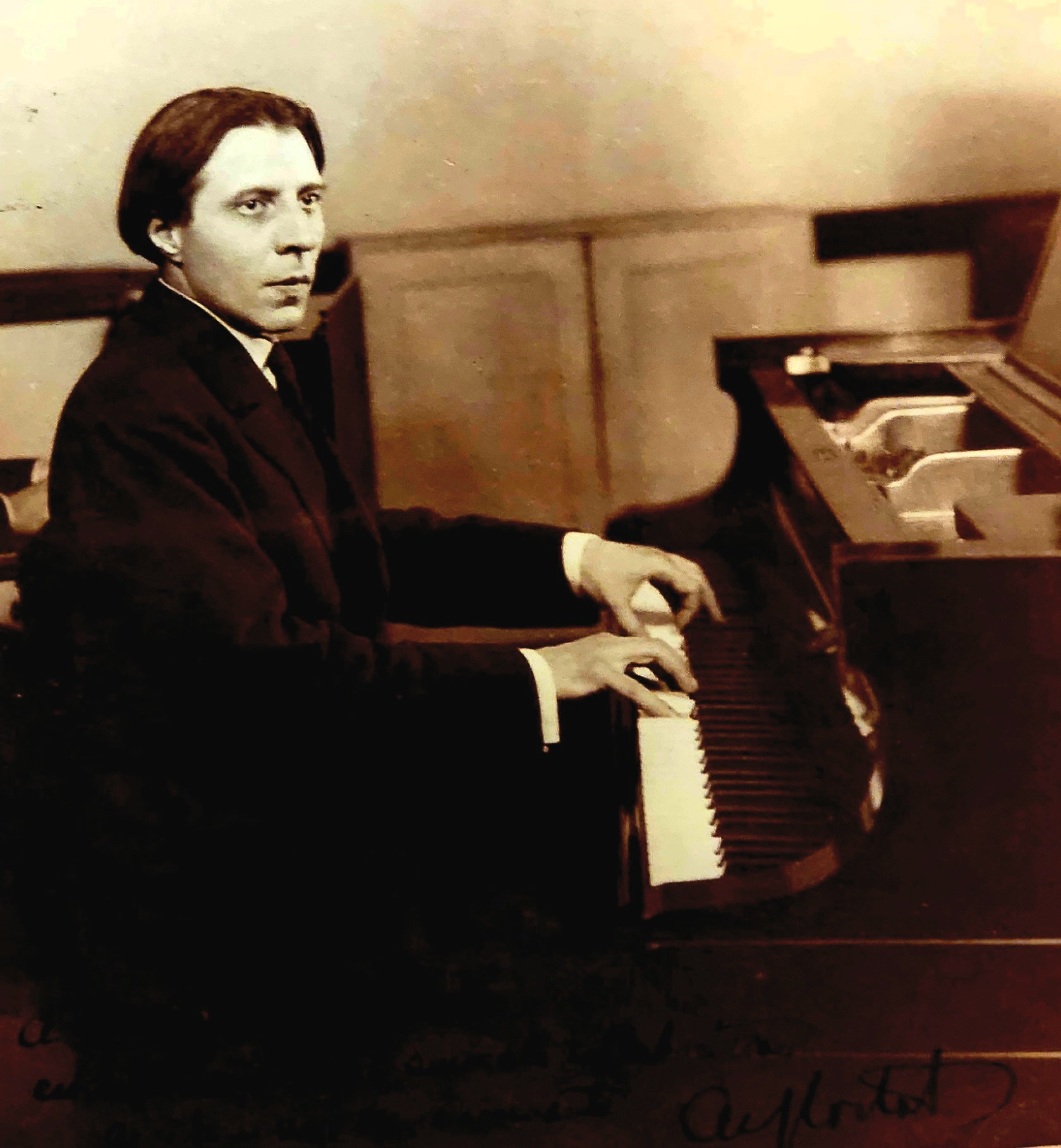 intelligent playing rather than for note-perfect performances.
intelligent playing rather than for note-perfect performances.
Cortot was the first artist to create an electrical recording of classical music, working with Victor in 1925. He was also the first to record the complete Chopin preludes, op. 28. Cortot was one of the most influential pedagogues of his time as well, with students such as Vlado Perlemuter, Clara Haskil, Gina Bachauer, Dinu Lipatti, Samson François, and Magda Tagliaferro. As an editor, Cortot created several highly influential editions of the music of Chopin, Debussy, and Schumann, as well as several others.
The Alfred Cortot Correspondence Collection at IPAM contains about 130 photocopies of letters written by Cortot, in French. It also houses 21 original letters from Cortot to Arthur Hedley, renowned Chopin scholar, dating from 1938-1962. The original letters (also in French) have been summarized in English by Charles Timbrell, author of “French Pianism: A Historical Perspective” and professor emeritus at Howard University. The summary document can be found within the collection and has been further summarized within the finding aid document.
Series Description
Series I- Correspondence
John Crown Collection
John Crown was an English-born American pianist, renowned as a performer and educator. Crown studied with Moritz Rosenthal in Vienna, and the two corresponded regularly. Crown taught as a member of the piano faculty at the University of Southern California for many years, and maintained a notable performance career as well.
The John Crown Collection at IPAM houses Crown’s correspondence with Rosenthal, as well as transcriptions of letters from important musicians to Josef Dachs, a relative of Crown. Paper files relating to Rosenthal and Crown respectively are also included.
Series Description
Series I- Correspondence
Series II- Performance Files
Series III- Miscellaneous
Nina Deutsch Collection
Nina Deutsch was a performer and dedicated educator, teaching both piano and voice in a variety of genres. She received degrees from Juilliard and Yale, studying with Sascha Gorodnitzki, Dorothy Taubman, and Rudolf Firkušný, amongst others. Deutsch made her piano debut at Carnegie Hall in 1968 and enjoyed an active performance career throughout the United States, Europe, and China in the years that followed. During her time at Yal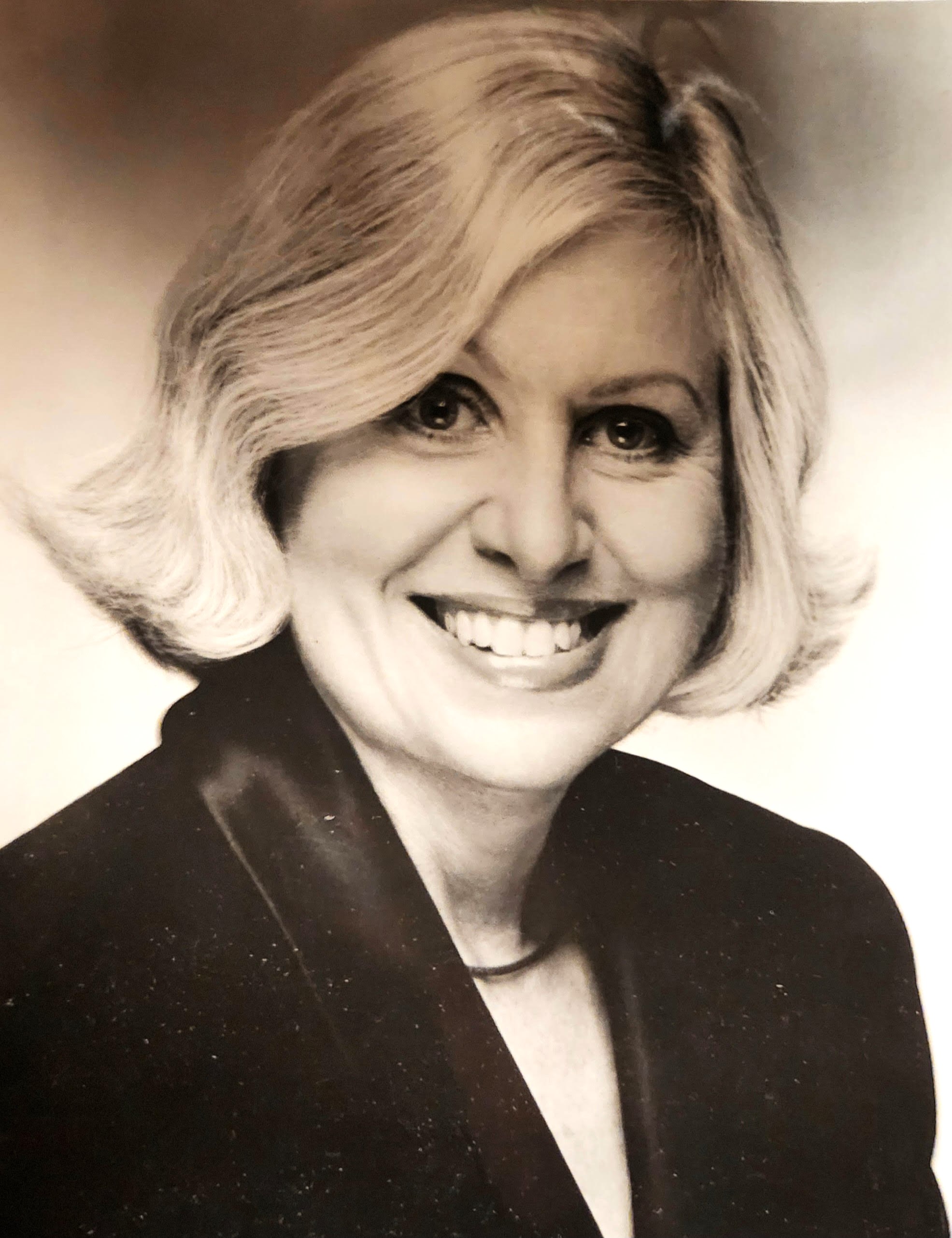 e, Deutsch studied the music of Charles Ives, which became a lifelong passion. Notably, she was the first woman to record the entirety of Ives' piano music.
e, Deutsch studied the music of Charles Ives, which became a lifelong passion. Notably, she was the first woman to record the entirety of Ives' piano music.
Deutsch was a child prodigy, beginning her studies at the age of 5 and making her debut with an orchestra in Miami at 10 years old. Deutsch performed as a pianist and as a singer (often while accompanying herself), and she performed in original one-woman theatrical works based around the lives of composers such as Clara Schumann. She took up the pseudonym “Nina Diamond” for popular music performances, playing in clubs, restaurants, and on cruise ships. Deutsch appeared on several television specials and radio shows as well, including with Robert Sherman on “The Listening Room” and on CBS's “To Tell the Truth. "
Nina Deutsch died on January 22, 2024. The Nina Deutsch Collection at IPAM consists mainly of audiovisual materials relating to her performances, recordings, and TV/radio appearances, but also includes a small number of photographs and other papers.
Series Description
Series I- Audiovisual Materials
Series II- Papers and Photographs
Ania Dorfmann Scrapbooks
Ania Dorfmann was a Russian-American pianist and teacher, known for her work with Arturo Toscanini and her extended teaching career at Juilliard. Dorfmann was born in 1899 in what is now Ukraine, giving her first concert at the age of 11. Following her debut, Dorfmann went to Paris and studied with Isidor Philipp at the Paris Conservatoire. Dorfmann concertized throughout Europe for many years before debuting at Town Hall in New York in 1936. She 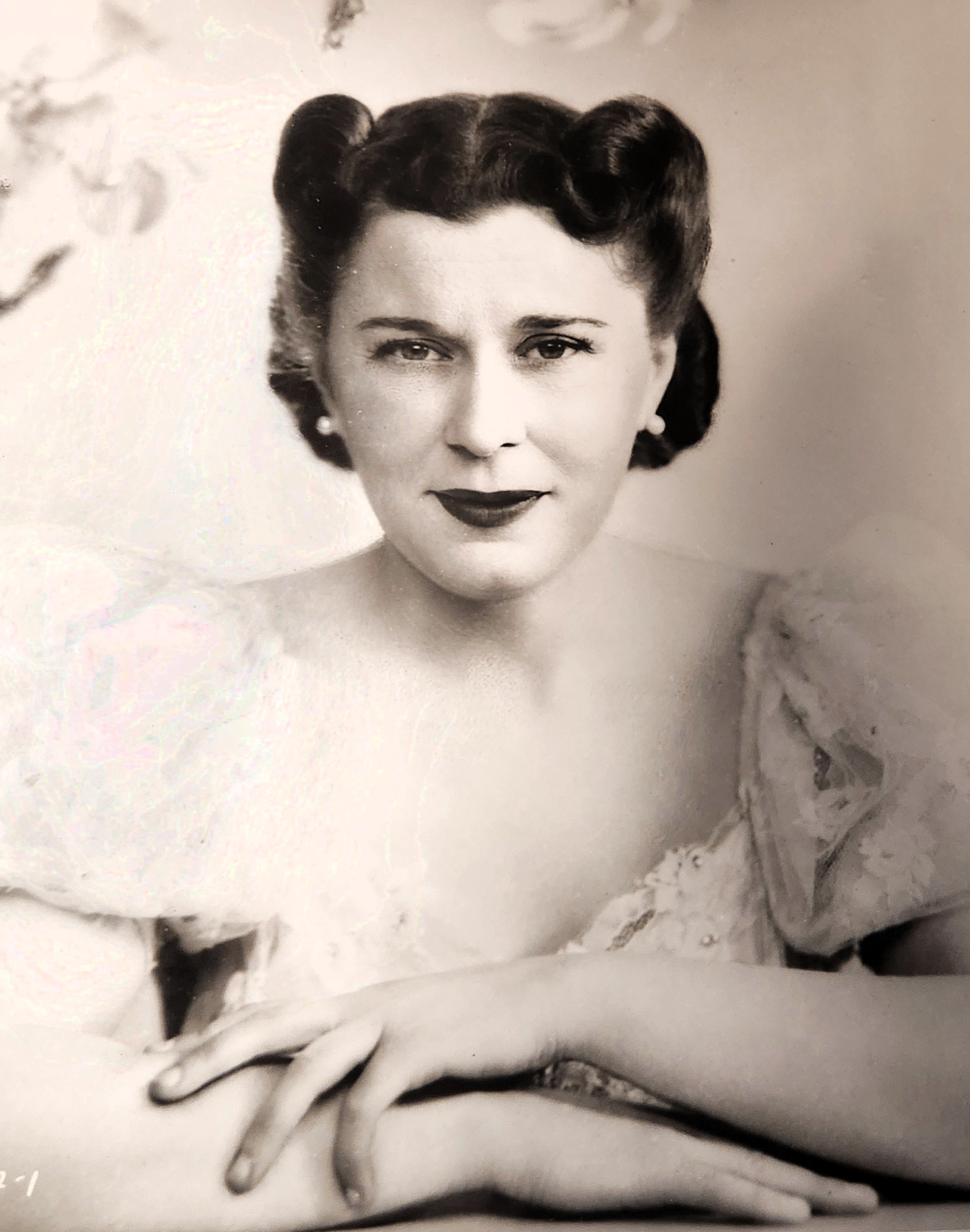 was the first female pianist to be engaged as a soloist by Arturo Toscanini, and together they performed Beethoven Concerto no. 1, his Triple Concerto, and his Choral Fantasy. Dorfmann was also active in Hollywood, working with Barbara Stanwyck on her film “The Other Love.” Dorfmann played for the soundtrack and coached Stanwyck so that her actions at the keyboard would match the recorded sound. During the 1930s, Dorfmann made a series of recordings for English Columbia, and from 1945-1959, she recorded for RCA Victor.
was the first female pianist to be engaged as a soloist by Arturo Toscanini, and together they performed Beethoven Concerto no. 1, his Triple Concerto, and his Choral Fantasy. Dorfmann was also active in Hollywood, working with Barbara Stanwyck on her film “The Other Love.” Dorfmann played for the soundtrack and coached Stanwyck so that her actions at the keyboard would match the recorded sound. During the 1930s, Dorfmann made a series of recordings for English Columbia, and from 1945-1959, she recorded for RCA Victor.
Dorfmann joined the faculty of the Juilliard School in 1956, and remained there for most of her life. She taught notable students such as Solveig Funseth, Lev Natochenny, Alexander Peskanov, Minuetta Kessler, Marian Migdal, Roman Markowicz, and Robert Shannon. Dorfmann retired in 1983, and died on 4/21/1984, at the age of 84.
The Ania Dorfmann Scrapbooks Collection at IPAM houses three microfilm reels containing Dorfmann’s personal scrapbooks.
Series Description
Series I- Microfilm Reels
Dean Elder Collection
Dean Elder was a pianist, pedagogue, critic, adjudicator, and esteemed author.
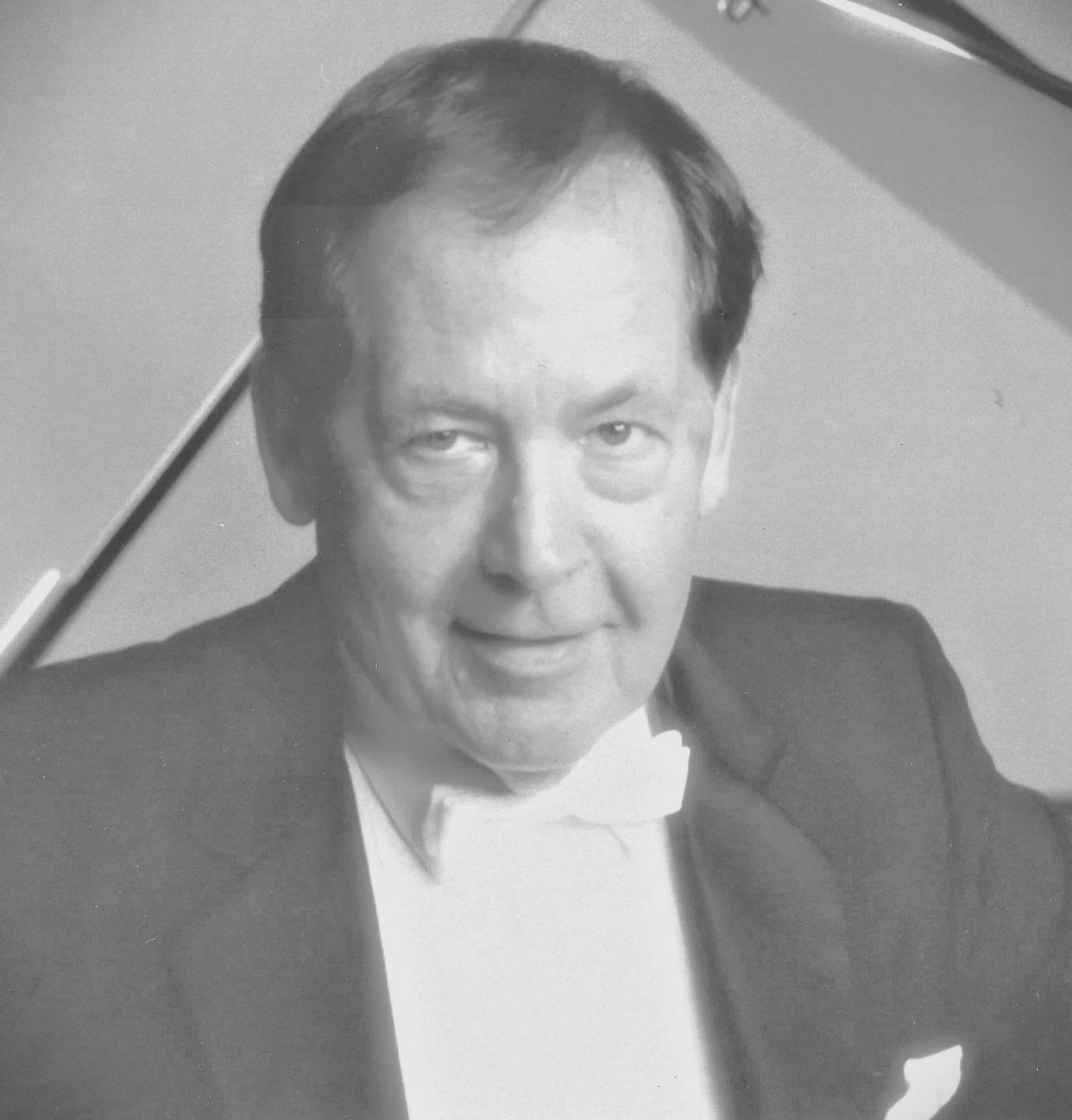
Elder completed his early piano training with Franziska Heinrich, a student of Teresa Carreño. He received degrees from the University of Idaho and Columbia University, and was also the recipient of several Fulbright grants which allowed him to continue his studies with Walter Frey, Jean Batalla, and Walter Gieseking in Europe.
Elder completed hundreds of interviews over the course of his life, both for Clavier magazine, where he was the consulting editor and a record reviewer, and for his book, Pianists at Play. Elder’s book is largely considered an important text within the musical community, and his numerous articles for Clavier continue to be held in high esteem.
Elder served on the juries of countless competitions, including the Gina Bachauer, William Kapell, Arthur Rubinstein, Jose Iturbi, Utrecht Liszt, Sydney, Senigallia, Hamamatsu, Leeds, and Paris International Piano Competitions. Elder also acted as a member of the Van Cliburn International Piano Competition screening jury in 1997.
Elder passed away at the age of 98 in 2019.
SERIES DESCRIPTION
The Dean Elder collection contains two series. A complete finding aid of the materials is available.
Series I- Correspondence
Contains correspondence between Elder and famous pianists.
Series II- Interview Materials
Contains cassette tapes and CDs of interviews between Elder and famous pianists.
Alice Frisca Collection
Alice Frisca was the stage name for pianist Alice Mayer Kirsch, aunt of Harold C. Schonberg. The name “Frisca” was drawn from San Francisco, Frisca’s place of bir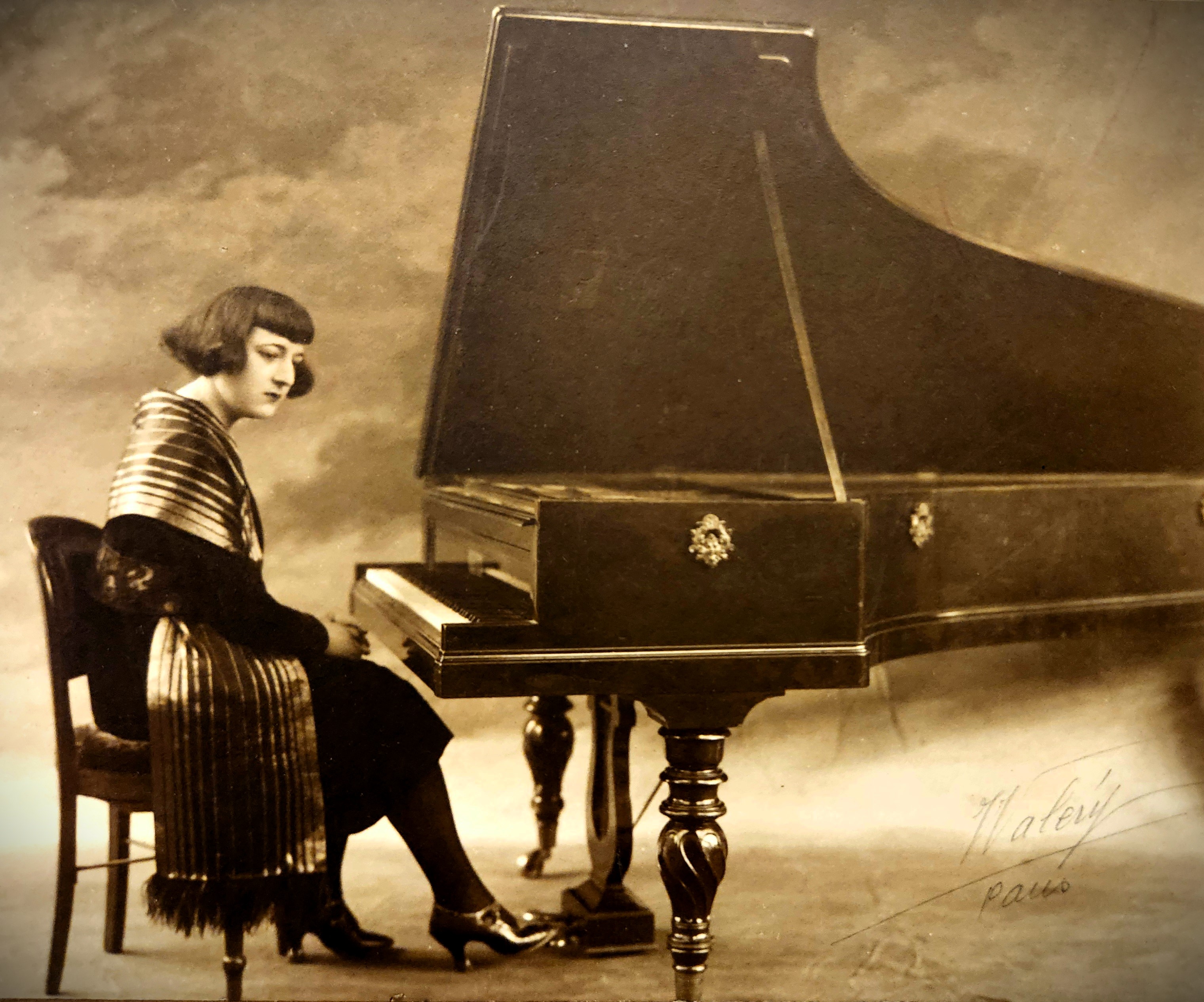 th. Frisca studied with several renowned musicians, including pianists Pierre Douillet and Leopold Godowsky, and organist Clarence Eddy. As a concert pianist, she won the MacDowell Prize from the California Federation of Music Clubs, and was honored with a medal following a benefit concert she gave in Paris in 1921. Frisca played across Europe and the United States to favorable reviews throughout the 1910s, 20s, and 30s. She is cited by Harold C. Schonberg as his first piano teacher and a highly influential figure in his early musical development.
th. Frisca studied with several renowned musicians, including pianists Pierre Douillet and Leopold Godowsky, and organist Clarence Eddy. As a concert pianist, she won the MacDowell Prize from the California Federation of Music Clubs, and was honored with a medal following a benefit concert she gave in Paris in 1921. Frisca played across Europe and the United States to favorable reviews throughout the 1910s, 20s, and 30s. She is cited by Harold C. Schonberg as his first piano teacher and a highly influential figure in his early musical development.
The Alice Frisca Collection at IPAM contains a large suede-bound scrapbook and a document case, both filled with materials relating to the life and career of Alice Frisca.
Series Description
Series I- Document Case
Series II- Scrapbook
Libidins-Horowitz Collection
David Libidins was an artist manager and administrative director, known for his professional work with the Ballet Russe, Vladimir Horowitz, Wanda Landowska, and others. The Libidins-Horowitz Collection focuses predominantly on the correspondence between Libidins, Horowitz, and family, but also includes performance files relating to Horowitz’s career under Libidins’ management.
Series Description
Series I- Correspondence
Series II- Performance Files
Marguerite Melville Liszniewska Collection
Marguerite Melville was an American pianist, composer, and teacher. She was born in New York to a musical family; her father, Charles Melville, was an organist, singer, and composer, and her mother, Mary Theresa Hughes Melville, was an opera singer. Melville’s brother was a multi-instrumentalist, and her paternal grandfather was a piano maker in Glasgow, Scotland. Melville studied piano and composition with Ernst Jedliczka and O.B. Boise in Berlin at the age of 15. Following the death of Jedliczka, Melville traveled to Vienna to study with and work for Theodor Leschetizky. She was a devoted student of his, and eventually became his assistant.
As a performing pianist, Melville played regularl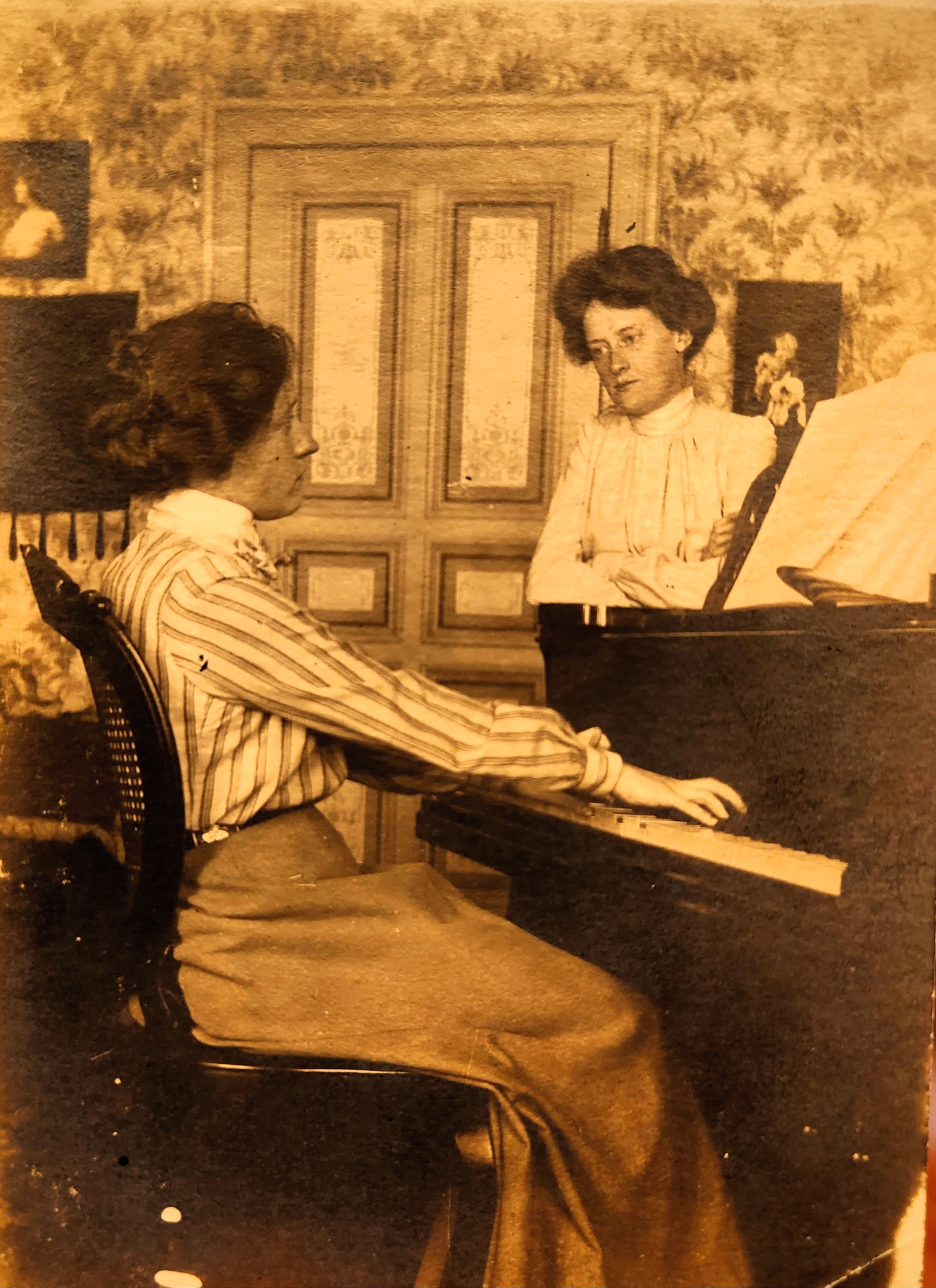 y in Europe and the United States. She debuted publicly in Berlin in 1897, and made her London debut in 1910, playing under Sir Henry Wood several times throughout her career. She gave a number of charity and aid benefit concerts, including one in Vienna in which she shared the program with Pablo Casals. Melville toured across the United States from 1915-1917, winning acclaim; she was eventually asked to perform for Calvin Coolidge at the White House in 1926.
y in Europe and the United States. She debuted publicly in Berlin in 1897, and made her London debut in 1910, playing under Sir Henry Wood several times throughout her career. She gave a number of charity and aid benefit concerts, including one in Vienna in which she shared the program with Pablo Casals. Melville toured across the United States from 1915-1917, winning acclaim; she was eventually asked to perform for Calvin Coolidge at the White House in 1926.
As a composer, several of Marguerite Melville’s works still survive today, the most significant of which being the Piano Quintet in E minor, op. 8. She wrote several additional chamber pieces, including a Romance for violin and piano and a Violin Sonata. Melville also wrote several songs for voice and piano, entitled Einkehr, Die Wasserrose, and Wehmut.
In 1908, Melville married Polish pianist Karol Liszniewski; the two settled in Cincinatti, Ohio in 1920. Melville taught at the Cincinnati Conservatory of Music until her death in 1935. The Marguerite Melville Liszniewska Collection at IPAM houses an envelope filled with photographs of Marguerite Melville and her family, as well as a large scrapbook, containing photographs, performance files, and papers compiled by Bertha Azora Olsen Hughes, a friend of Melville from her student days in Berlin.
Miller, Petri, and Ganz Collection
Evelyn Miller was a dedicated pianist and teacher. She studied with Egon Petri and Rudolf Ganz, amongst others, and was a prominent pianist in the Knoxville, TN area. She started the Evelyn Miller Young Pianist Series as well, a non-profit dedicated to providing performance opportunities for international artists at the start of their careers. The collection contains mainly correspondence between Miller, Petri, and Ganz, though performance files relating to the three pianists are also included.
Series Description
Series I- Correspondence Relating to Egon Petri
Series II- Performance Files Relating to Egon Petri
Series III- Correspondence Relating to Rudolph Ganz
Series IV- Performance Files Relating to Rudolph Ganz
Anton Rubinstein and Theodor Leschetizky Materials
The Leschetizky/Rubinstein Collection at IPAM houses photocopies of correspondence and scores belonging to Anton Rubinstein and Theodor Leschetizky. Rubinstein was a Romantic era virtuoso, often considered one of the greatest pianists of the 19th century. He was a highly influential figure, and founded the Russian Music Society and the St. Petersburg Conservatory. In addition to his accomplishments as a pianist, Rubinstein was also an important composer with a vast output. He wrote symphonies, operas, chamber works, lieder, and numerous works for solo piano.
Theodor Leschetizky was amongst the most influential piano teachers of the 19th century. While he was a great pianist himself, Leschetizky is mainly remembered for his legacy as a teacher. His students include Artur Schnabel, Ignacy Paderewski, Ossip Gabrilowitsch, Fannie Bloomfeld-Zeisler, Benno Moiseiwitsch, Ignaz Friedman, Miecyzslaw Horszowski, and over 1000 others. Leschetizky was also a composer, writing works for piano, piano and voice, and two operas.
Series Description
Series I- Anton Rubinstein Materials
Correspondence
Scores
Series II- Theodor Leschetizky Materials
Correspondence